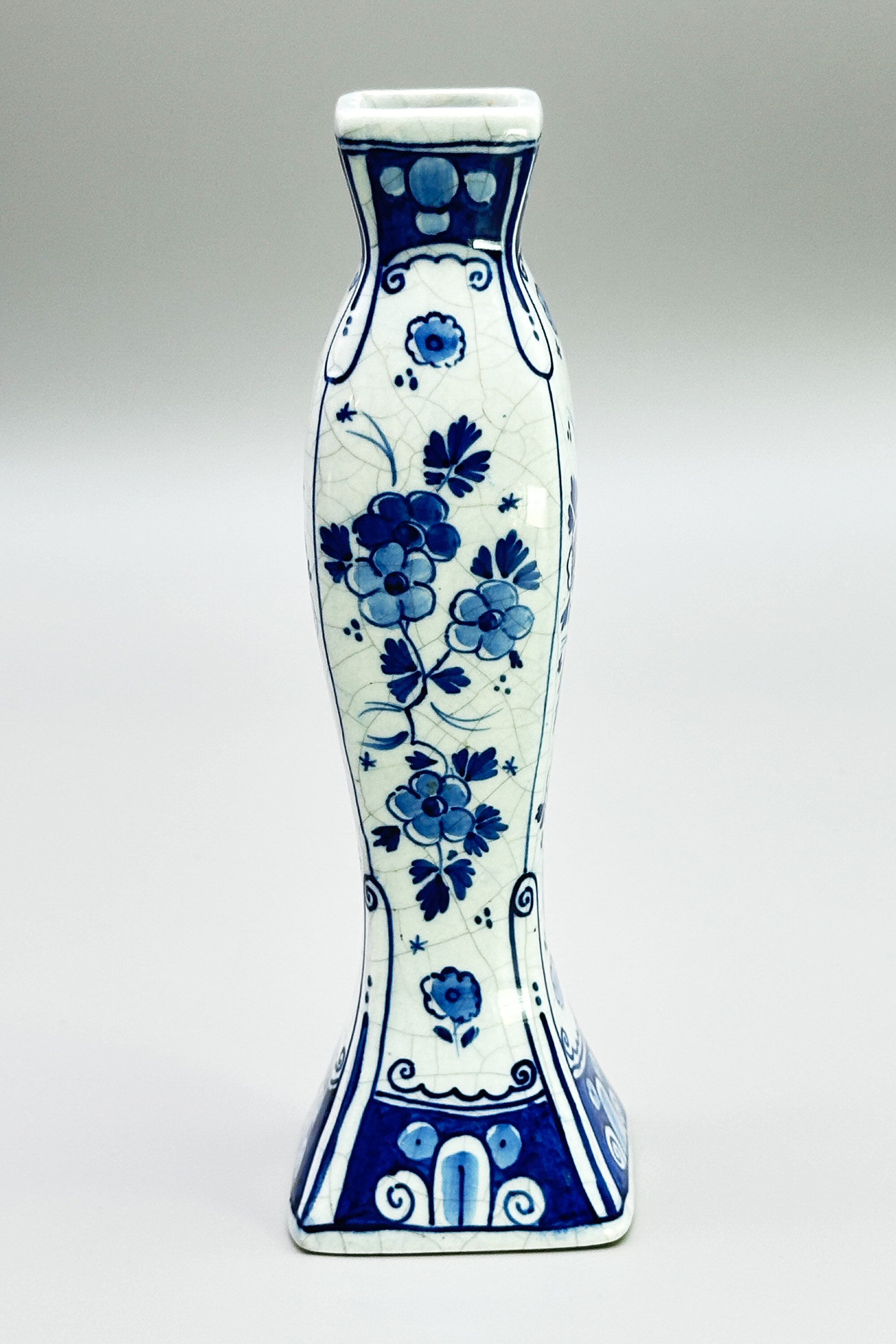Decorative Arts & Ephemera
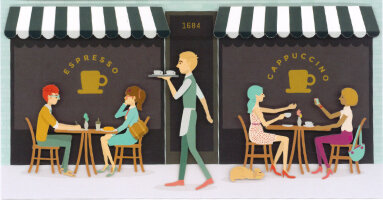
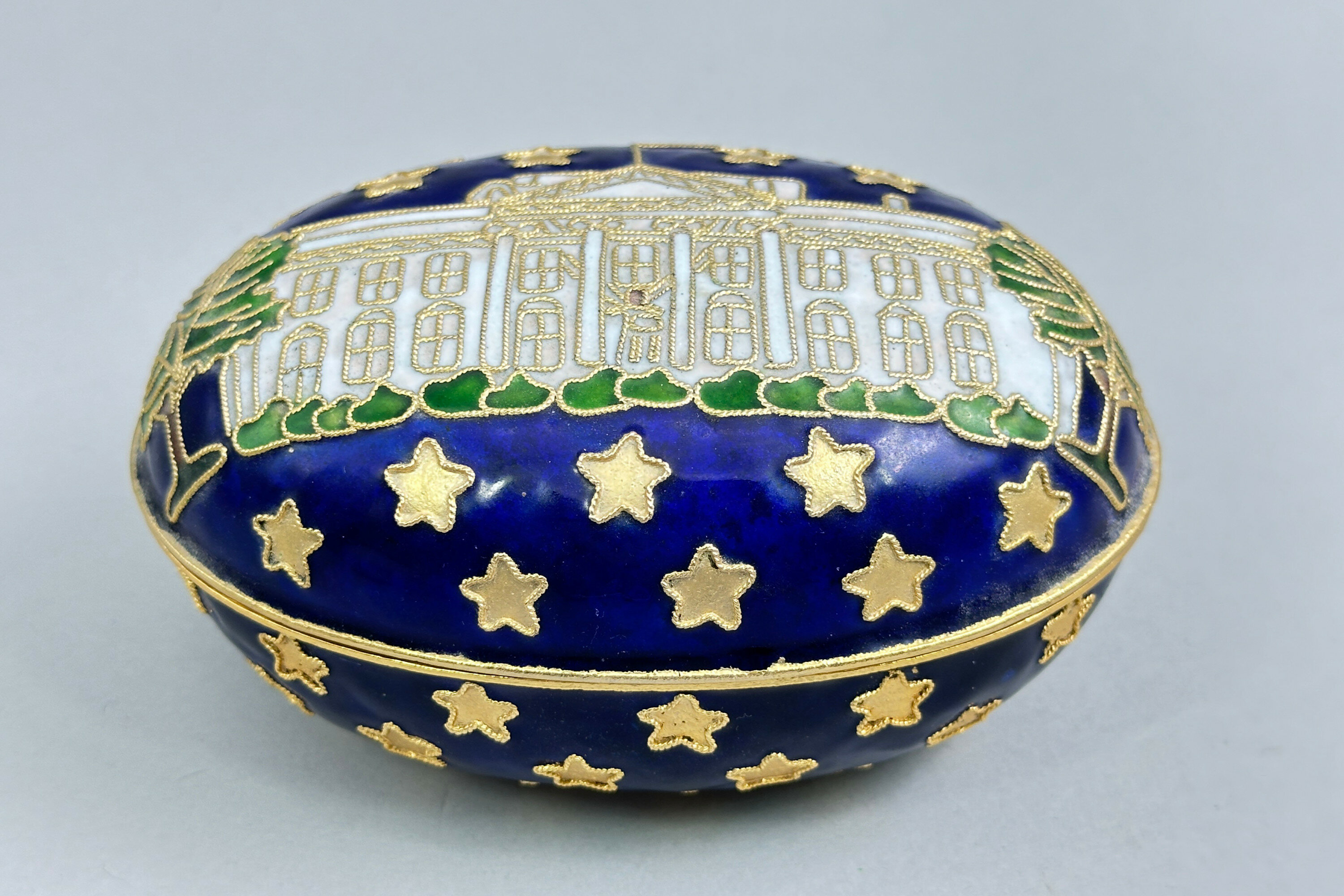
Souvenir White House Enamel Box and Cover
Price: £15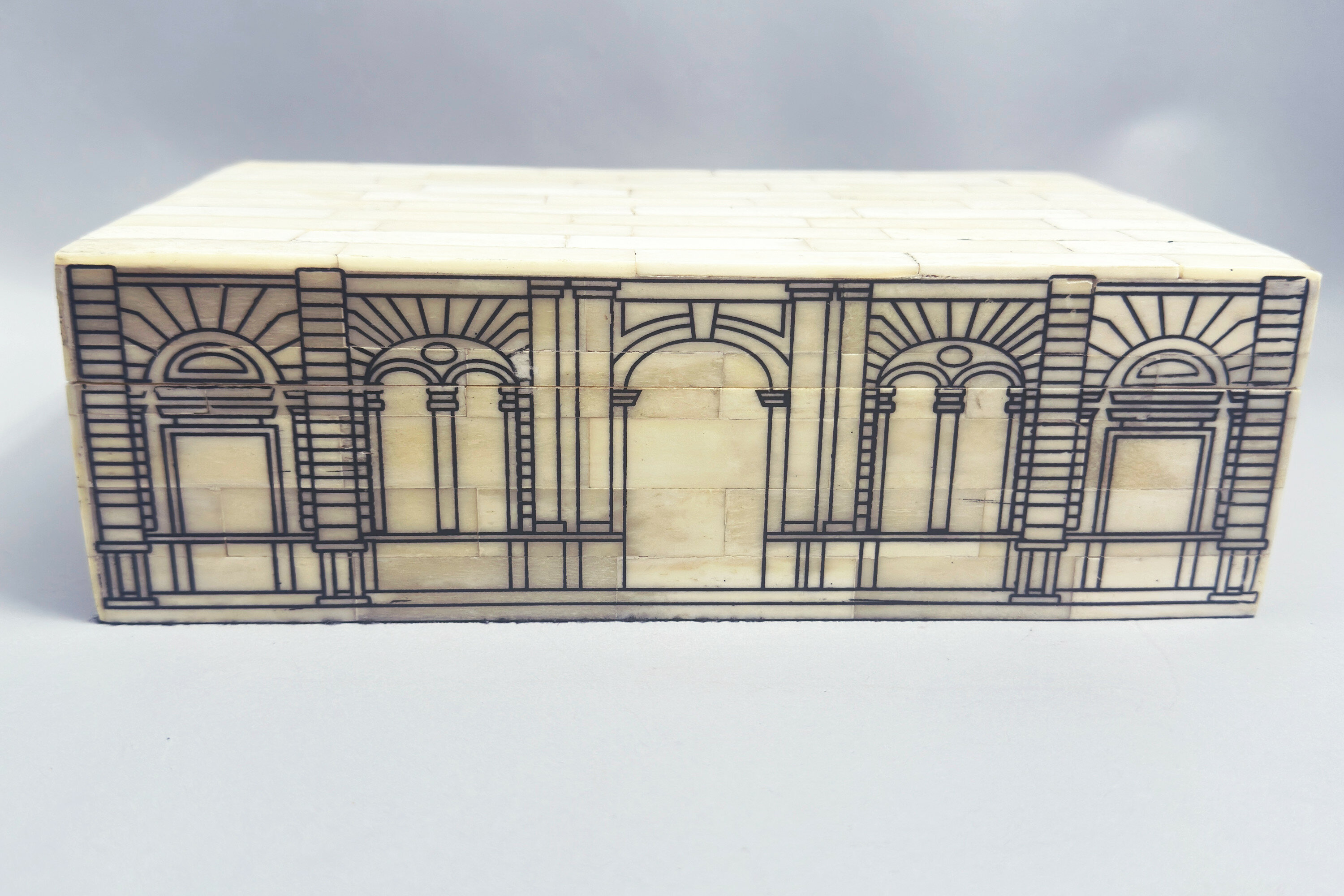
Bone parquetry box decorated in the manner of Fornasetti, Venetian, mid C20th
Price: £85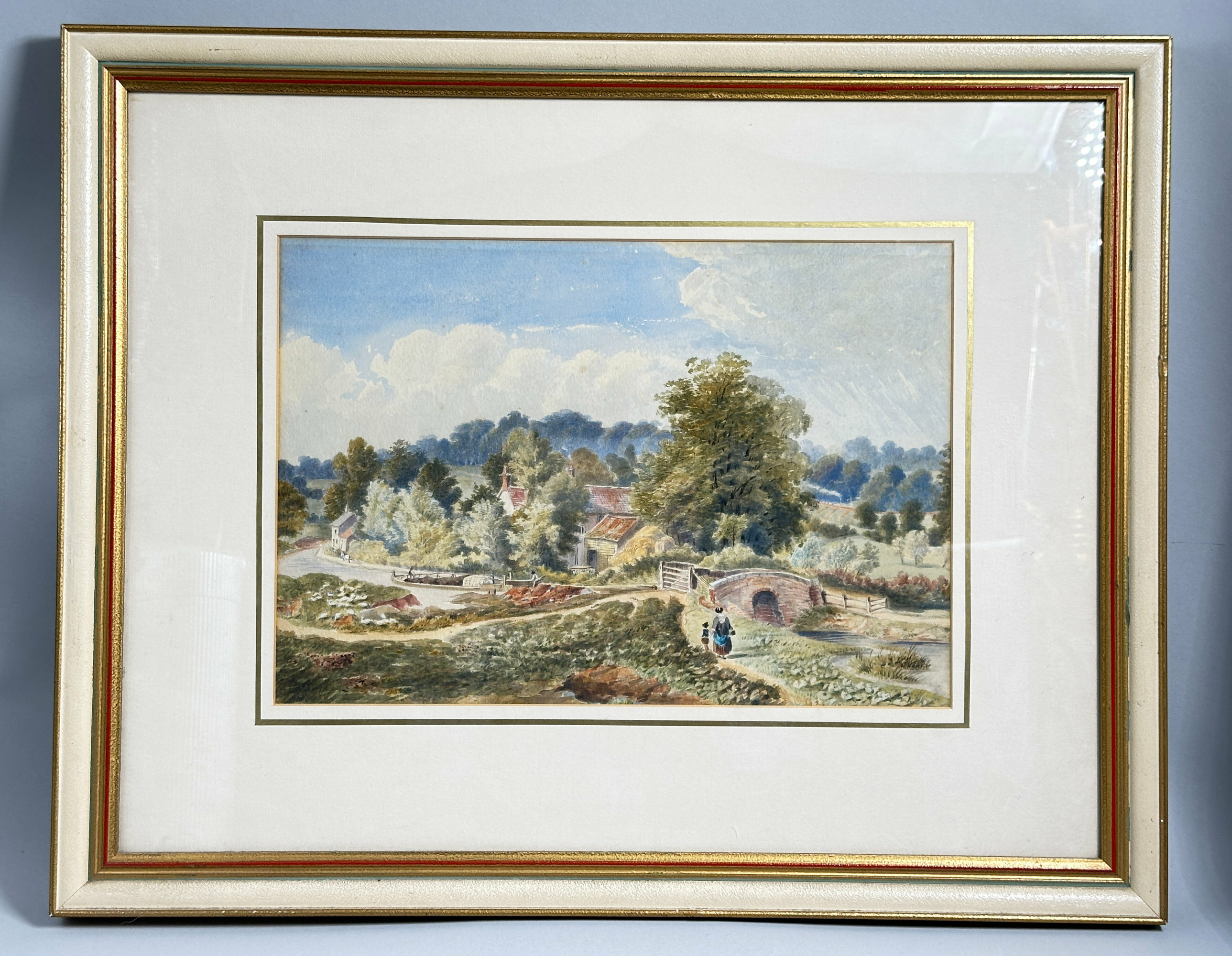
Framed Watercolour of a Countryside Scene, C20th
Price: £45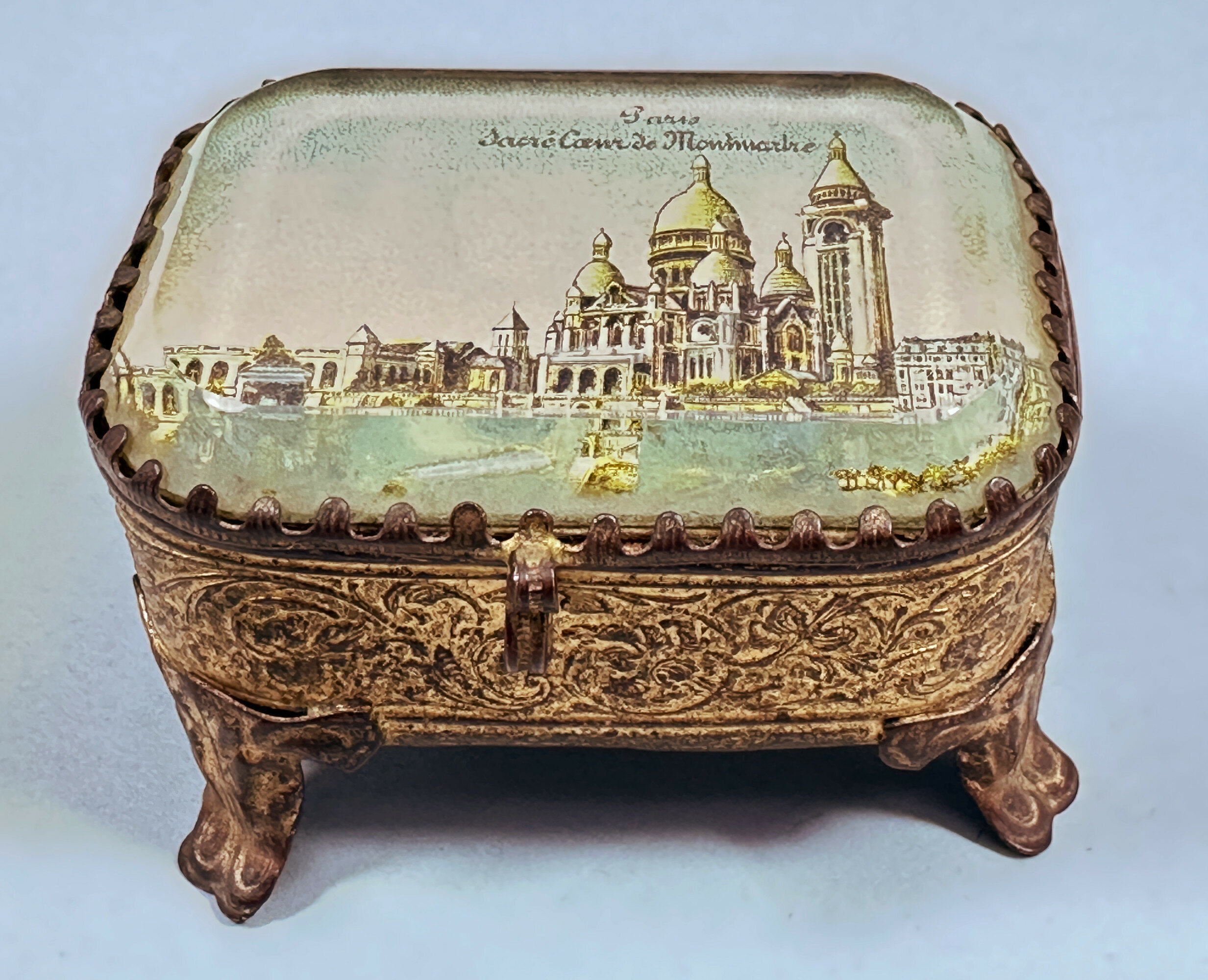
French Souvenir Verre Eglomise Box and Cover, Sacre Coeur de Montmatre, circa 1900
Price: £55
Vintage Needlepoint Picture of a Garden Scene, framed, second half C20th
Price: £25
Vintage Needlepoint Picture of a lady dressed in a crinoline, framed, probably 1930s
Price: £25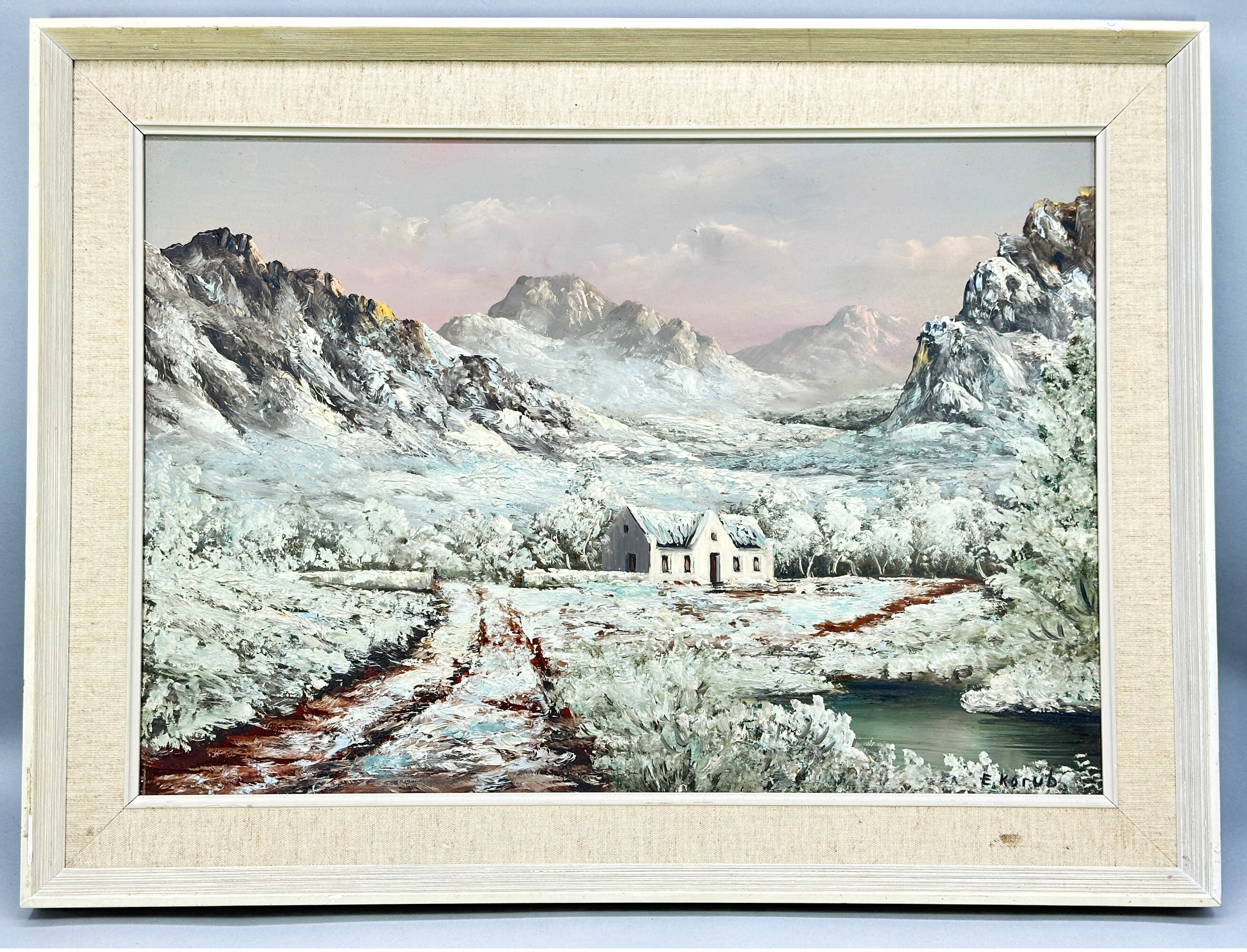
Framed Oil Painting on Board of a Winter Landscape Scene, C20th
Price: £55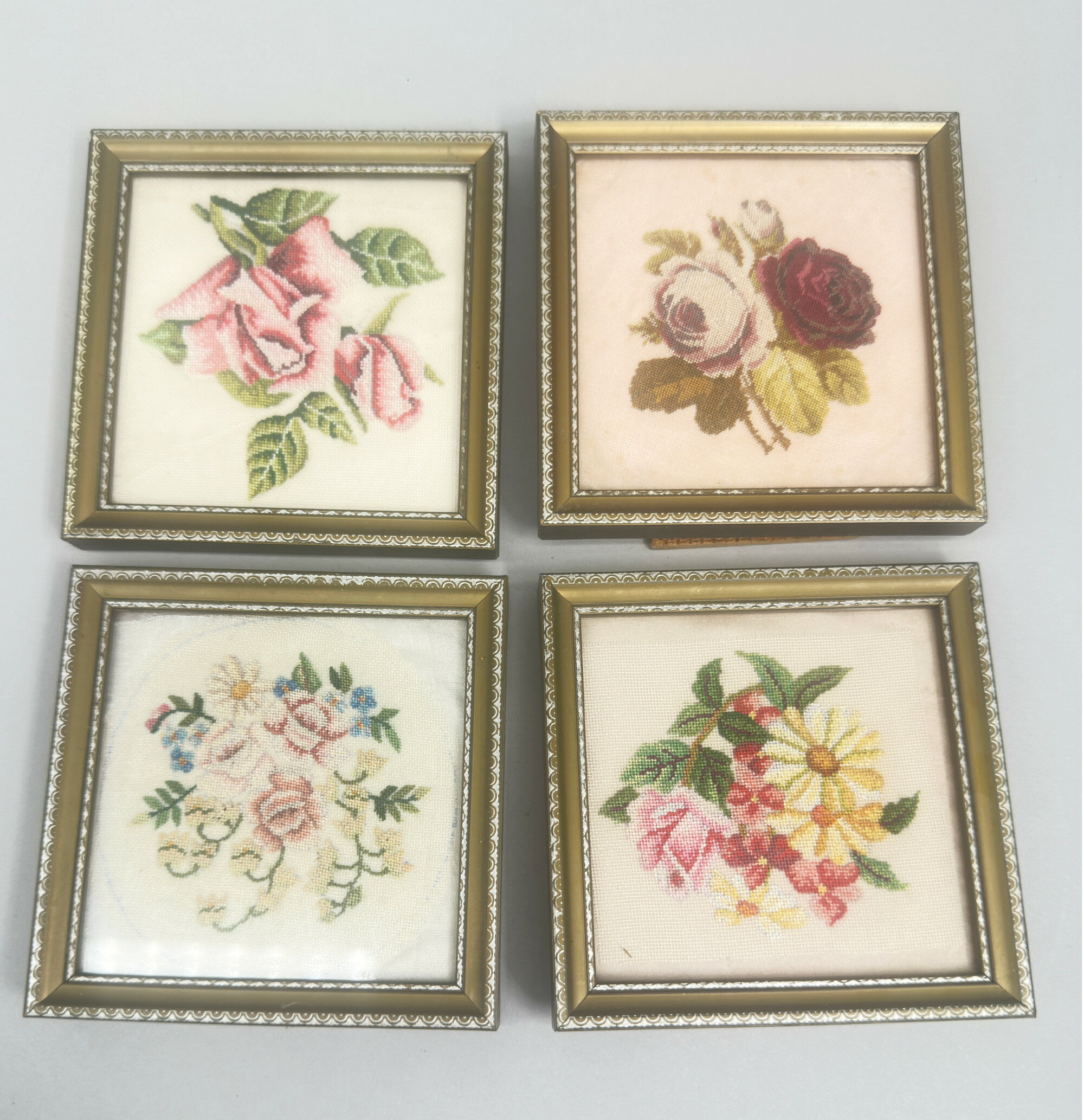
Set of four Petit Point needlepoint stitch framed floral Wall Hangings, mid C20th
Price: £45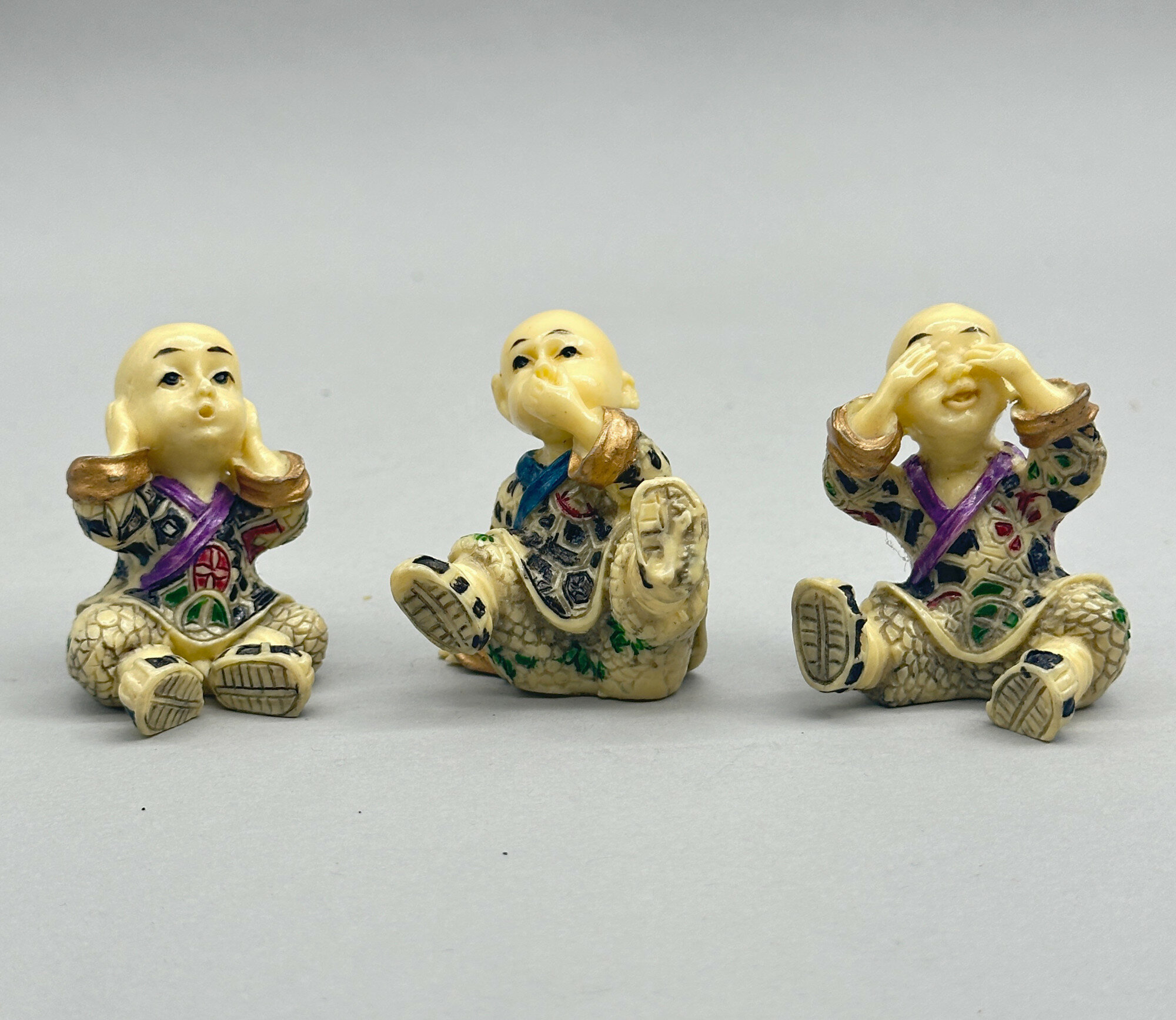
Set of Three Celluloid Figures of Monks, Japanese, first half C20th
Price: £45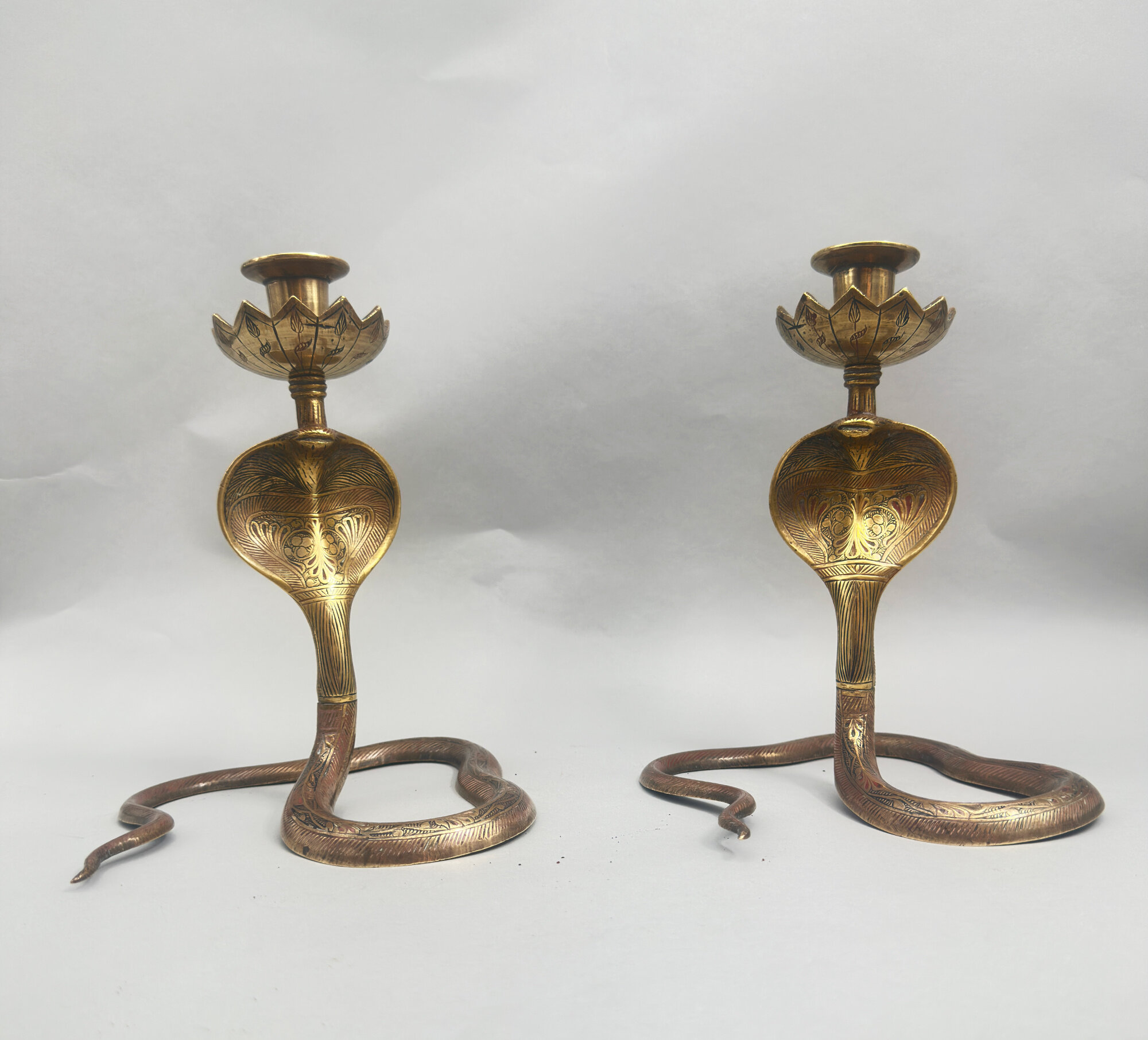
Pair of Indian brass candlesticks c1900
Price: £175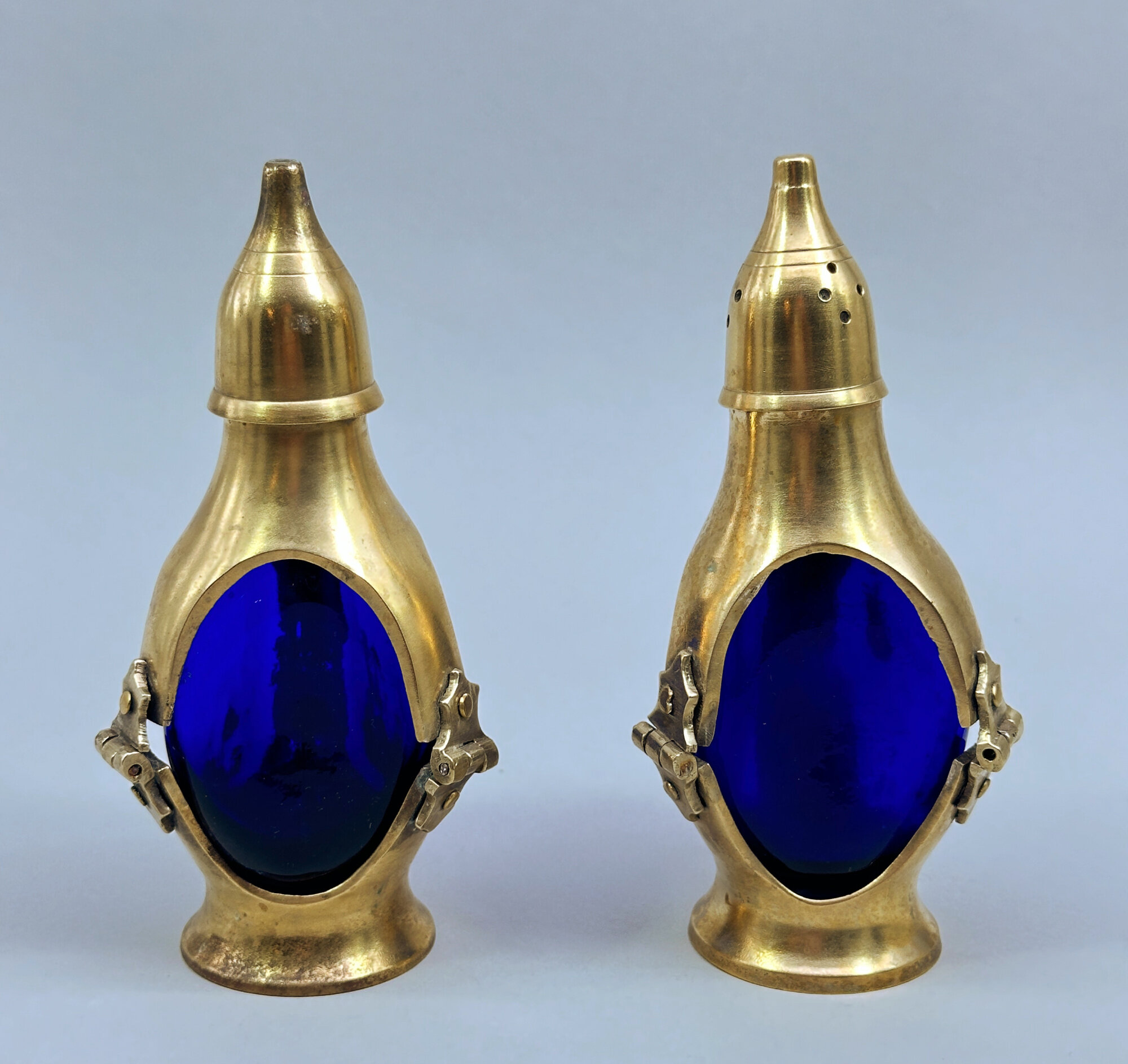
Arts and Crafts Brass and Cobalt Glass Salt and Pepper, early C20th
Price: £55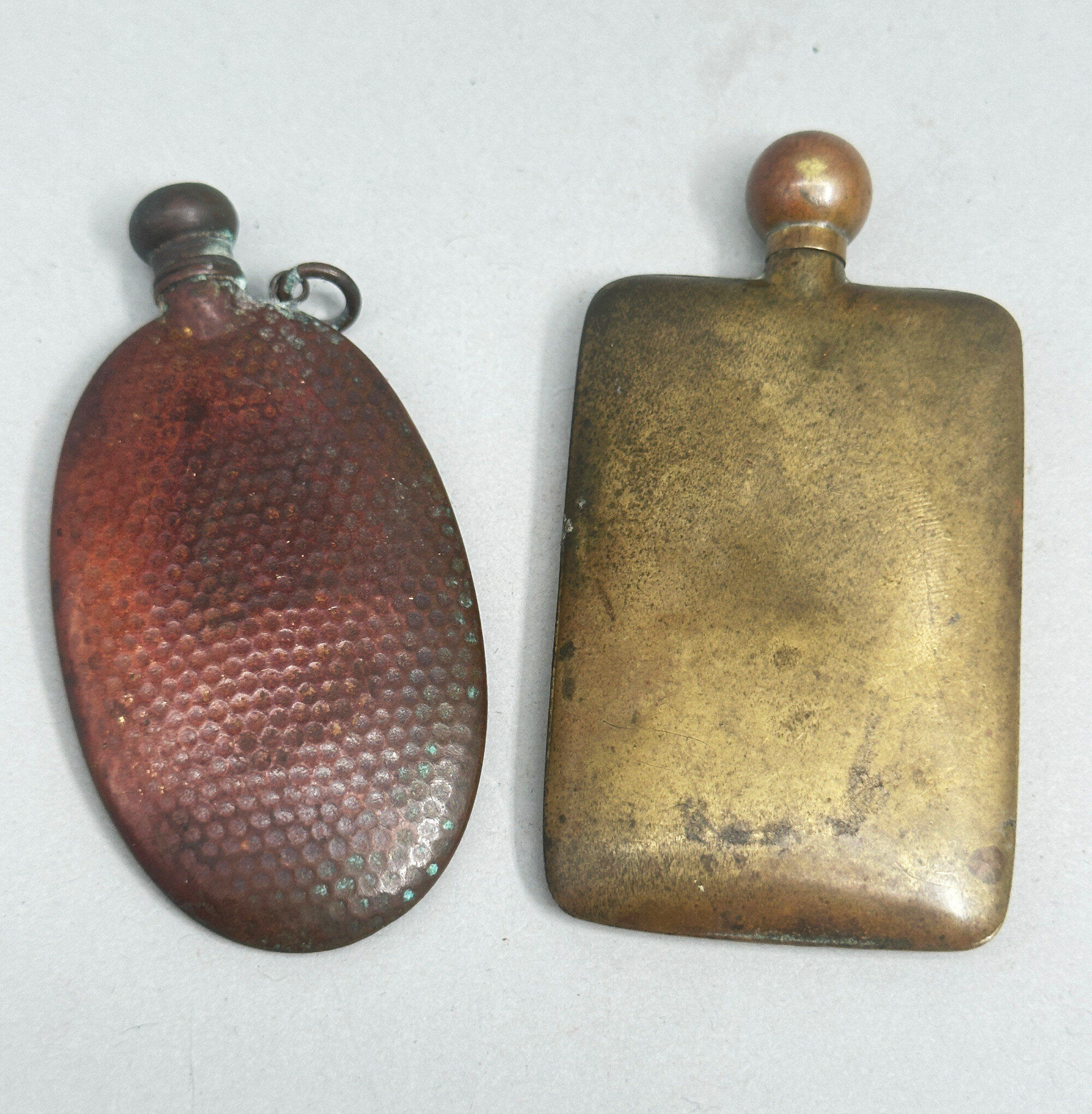
Two small metal perfume Flasks and Stoppers, 1920s
Price: £35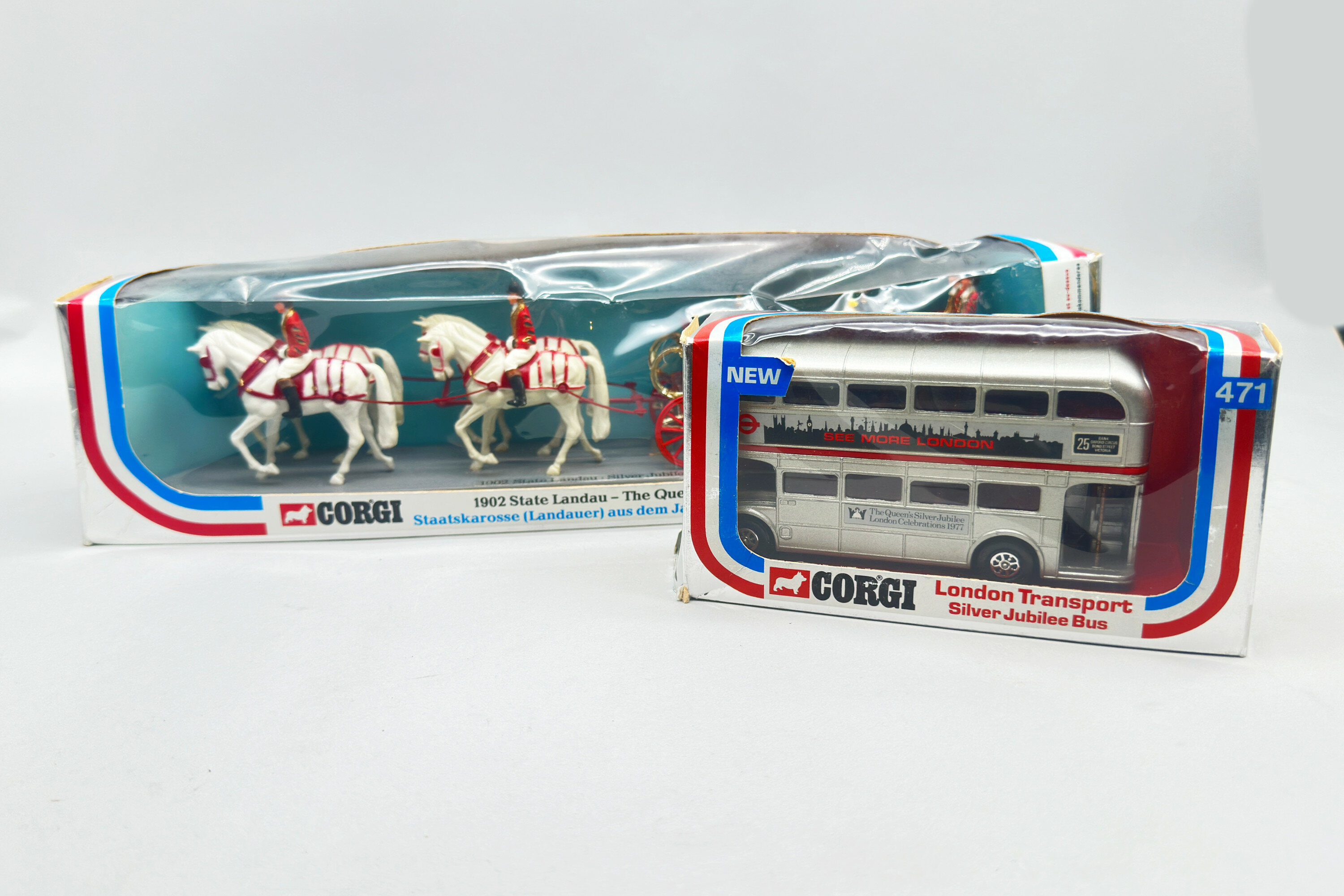
Two Corgi Silver Jubilee Toys Boxed, (41) State Landau, (417) London Bus, 1977
Price: £45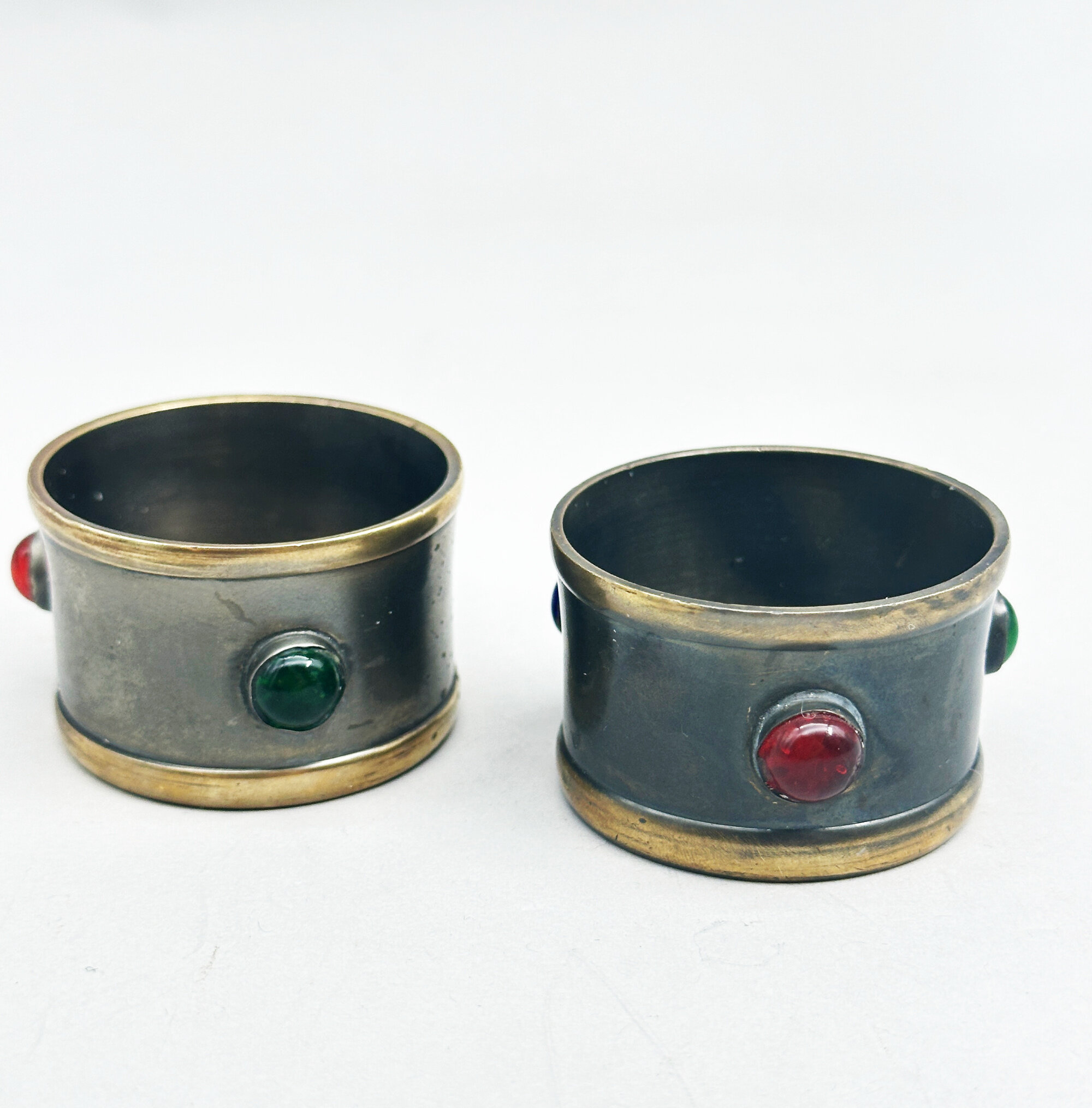
Pair of Arts and Crafts Pewter Salts, early C20th
Price: £45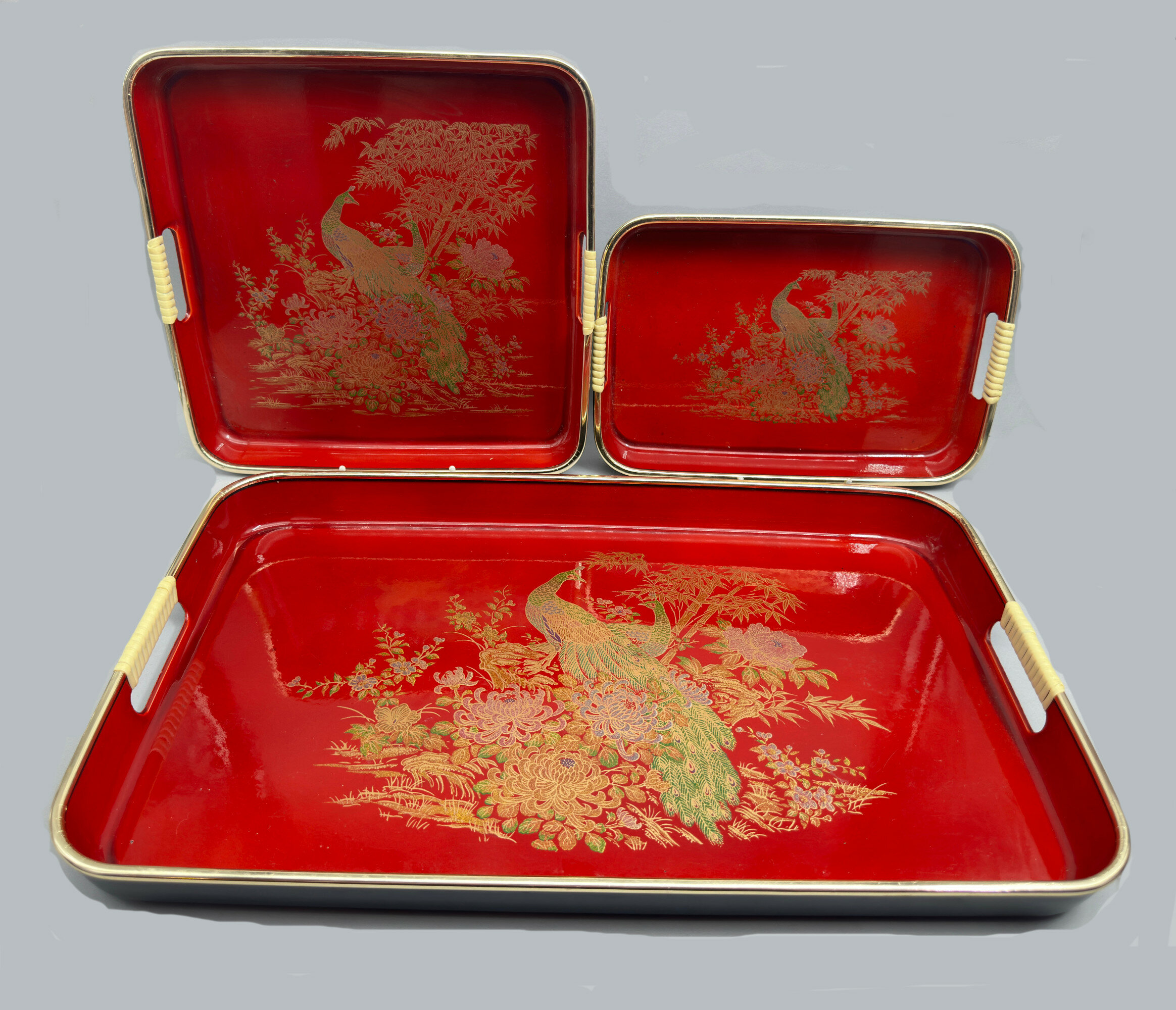
Set of Three Japanese Lacquer Nesting Trays, mid to late C20th
Price: £45
Octagonal Agate Mortar Bowl, C20th
Price: £25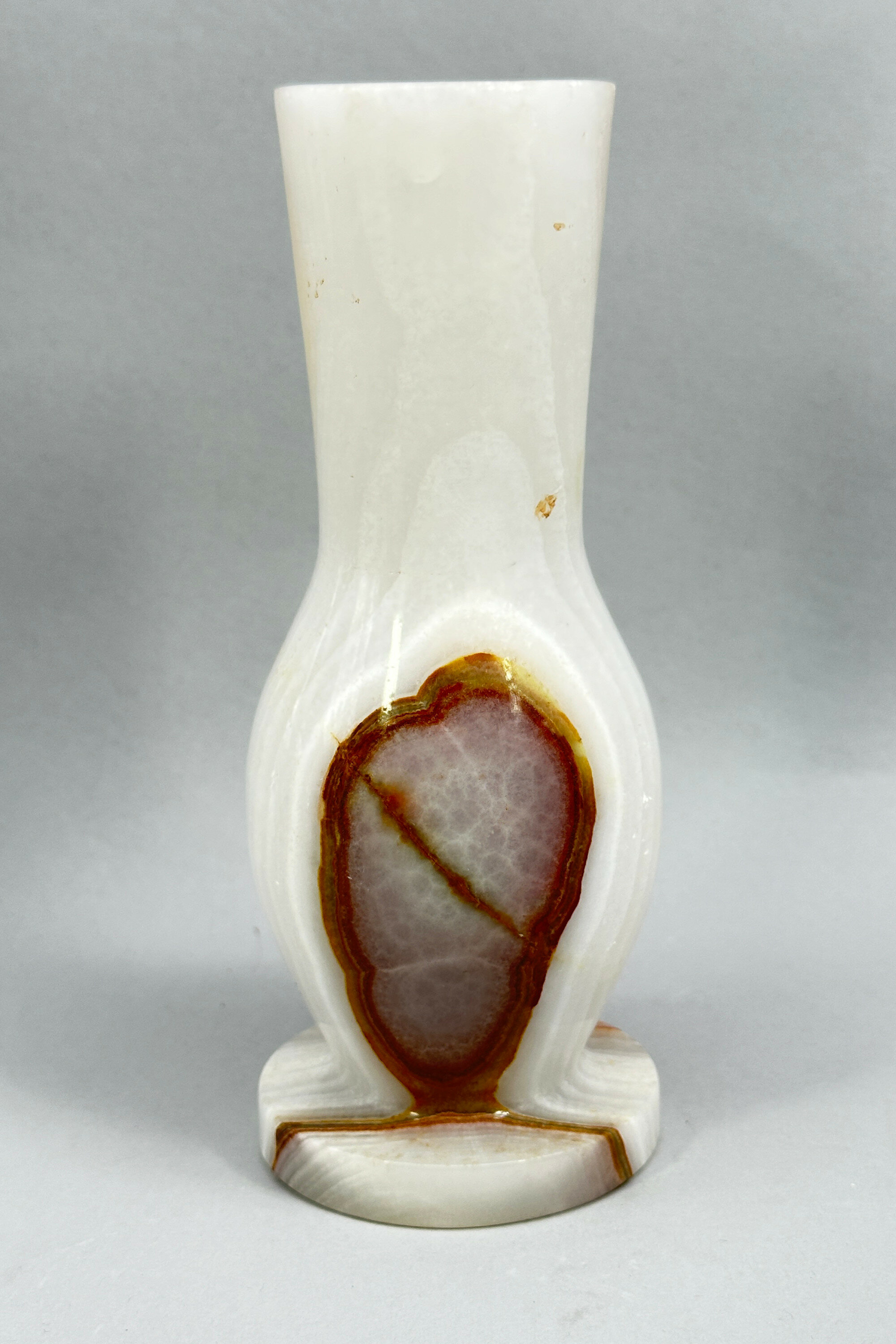
Pedestal footed Onyx Vase, mid to late C20th
Price: £25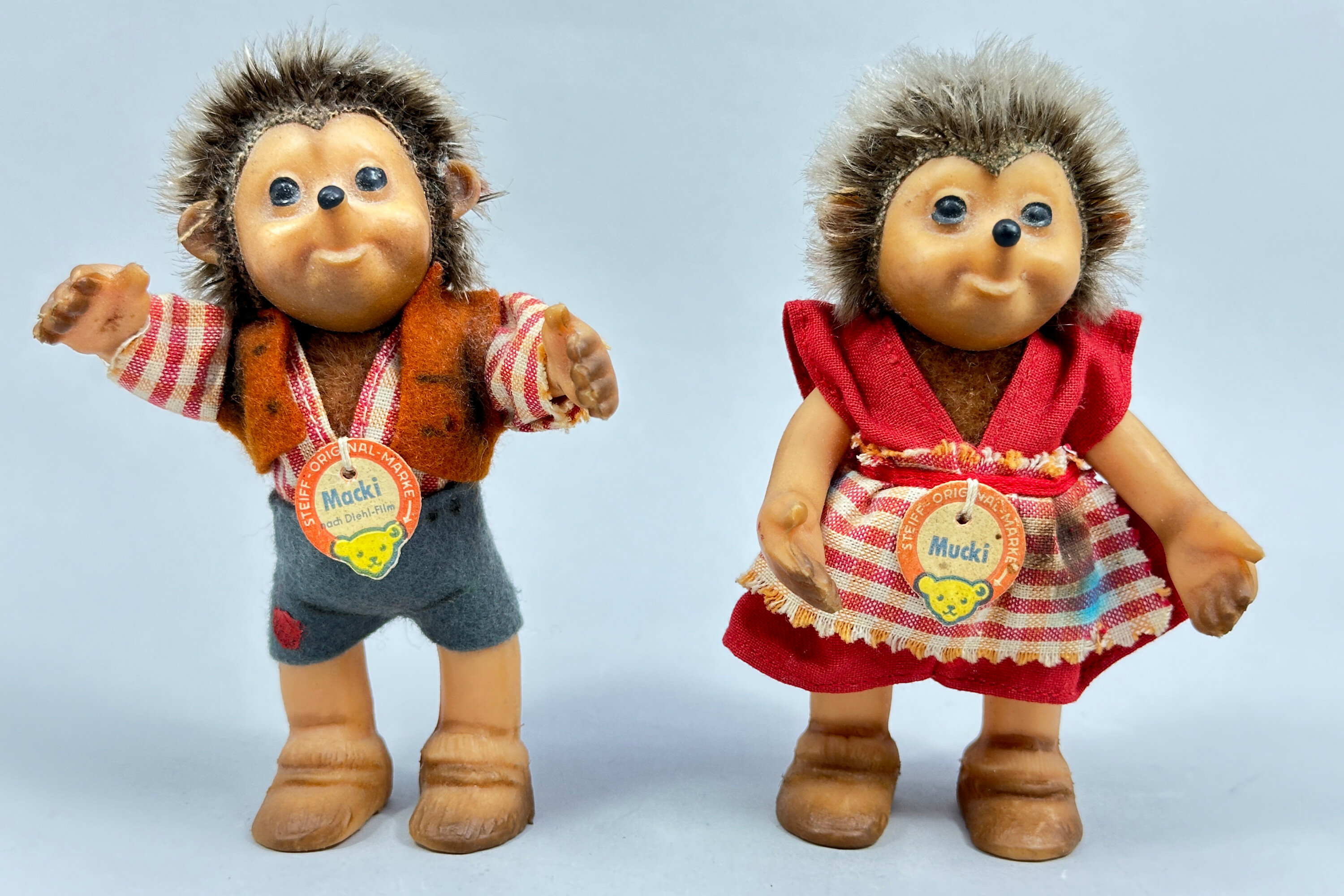
Steiff Hedgehogs : Macki and Mucki, 1950s/1960s
Price: £120…………………………………………………………………………………………........................................................................................…
The firm Steiff was begun by Margarete Steiff in 1880. A seamstress by training Margarete recognised a strong demand for some fabric elephants which she had made and intended for use as pincushions but soon became adopted as toys. Many other animals followed and a felt factory was founded in Giengen, Germany, in 1893 soon to be followed two years later by the first consignment of her wares to Harrods, London. In 1897, Margarete’s nephew Richard joined the firm and went on to design the first plush bear with movable arms and legs for which a substantial order was received of 3000 examples in 1903 from an American buyer who sensed a growing demand for these animals as a result of the US President Theodore ‘Teddy’ Roosevelt being shown in a photograph with a young cub in The Washington Post of the previous year. By 1907 a little under one million of these bears were being produced and turnover went on to increase substantially. Steiff bears can be purchased today and the earlier examples are actively sought after by collectors.
In the 1930s, Steiff began to collaborate with the Walt Disney company and characters from their films were reproduced starting, unsurprisingly, with Mickey Mouse and going on to include some of the most famous creations even up to the present day with ‘Nemo’ and ‘Woody’ from Toy Story being recent and popular additions.
The Hedgehog family, comprising Mecki and Micki with their children Macki and Mucki first appeared in 1951 and continued in production until the 1990s. These four characters are often found, sometimes with the characteristic round Steiff tag bearing their name and with the wording ‘Steiff–Original–Marke’ with an arrow pointing to a teddy bear’s head, but other hedgehog models which can be regarded as ‘cousins’ were made for a brief period in the 1960s. The nuclear family, though, comprised these four and they are sometimes illustrated together on postcards. Some of the round tags have additional wording ‘nach Diehl Film’ (‘from/after the film [maker] Diehl’) which refers to a German film company set up by three brothers Ferdinand, Hermann and Paul Diehl in 1937. They specialised in the ‘stop motion’ technique which involves the minute movement of model figures which, when photographed and with the images displayed in quick succession, allows the illusion of movement, now familiar today in the films featuring Wallace and Gromit.
Mecki and his family were popular characters in some of the films the Diehl brothers made and first made their appearance in 1949 designed as mascots for a German periodical called ‘Hor Zu’ which began publication in 1946 and covered radio and television news. Some of the tags attached to members of the family allude to this and Macki’s here reads at the back ‘Redaktionsigel von Hor Zu’ (‘the hedgehog editor of Hor Zu’). This explains the blue stain on Mucki’s skirt which is clearly meant to represent ink. Other members of the family also display marks on their clothes as a sign of being hard at work. Sensing the popularity of these characters, Stieff negotiated an exclusive right to produce dolls of them in 1951 and the hedgehogs became a staple of their output. The Diehls’ last film was made in 1970 and the hedgehogs featured in more than one over the years, becoming much loved characters in Germany during the 1950s and 1960s.
The techniques of production of the figures varied over time as did the attached labels. The earliest were made from 60% wool and 40% cotton with the faces formed from rubber like latex over a straw filling. Such example of these as survive are in rather poor condition. The very latest versions, made from 1968 to 1990 have a different form of chest name tag and a different ‘button’ label. (From the earliest times, Steiff toys had a yellow rectangular label listing the materials used and the country of origin and sometimes the price, attached by a small button marked ‘Steiff’. Unfortunately, these are missing here but the chest tags are intact and in good condition which does not always occur.) Dating of these two examples is therefore midway and probably to the late 1950s or early 1960s and they survive in near pristine condition making them an excellent addition to a collection of Steiff soft toys and a fine memento of almost iconic companions to so many children in post war Germany.
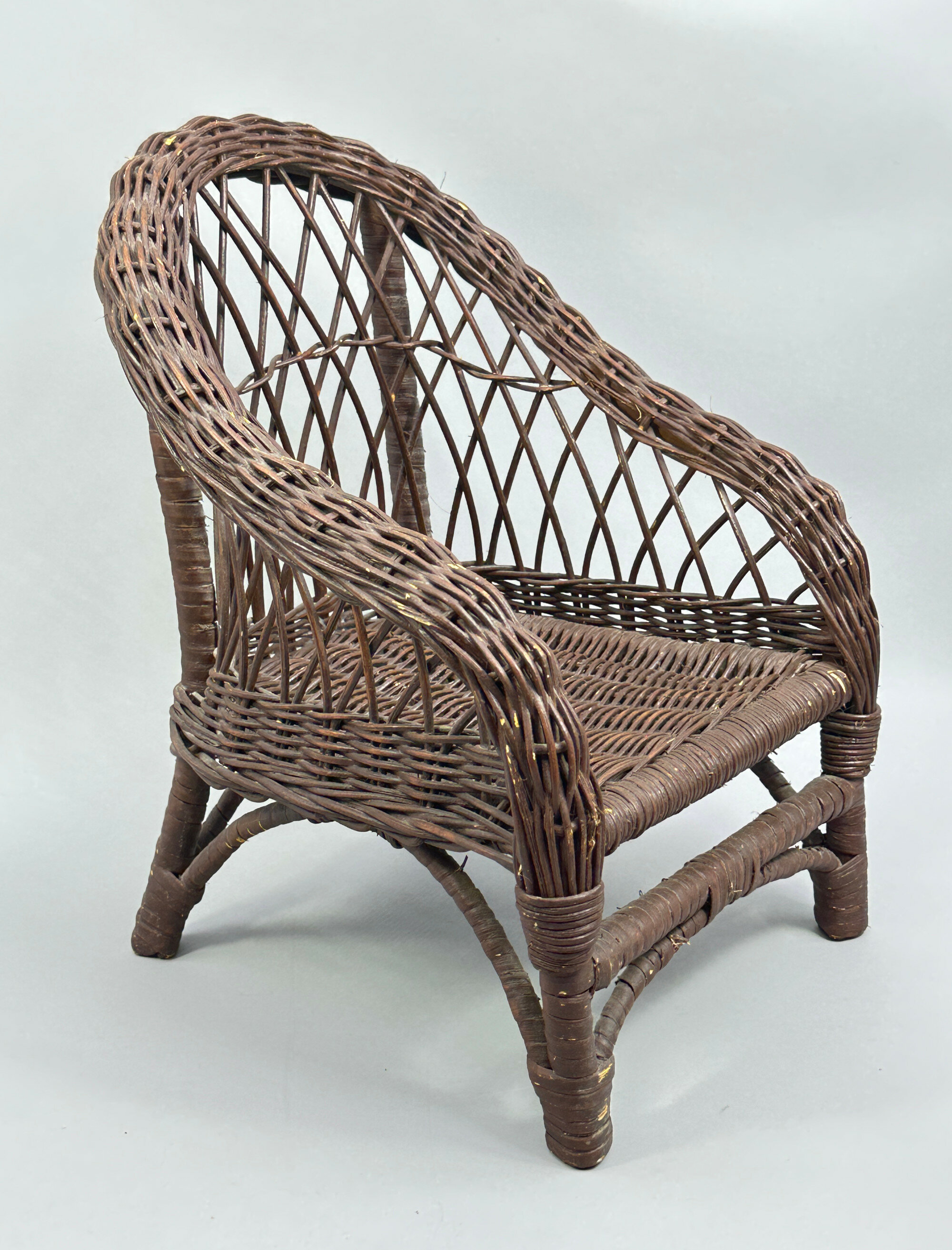
Toy Wicker Chair, mid C20th
Price: £35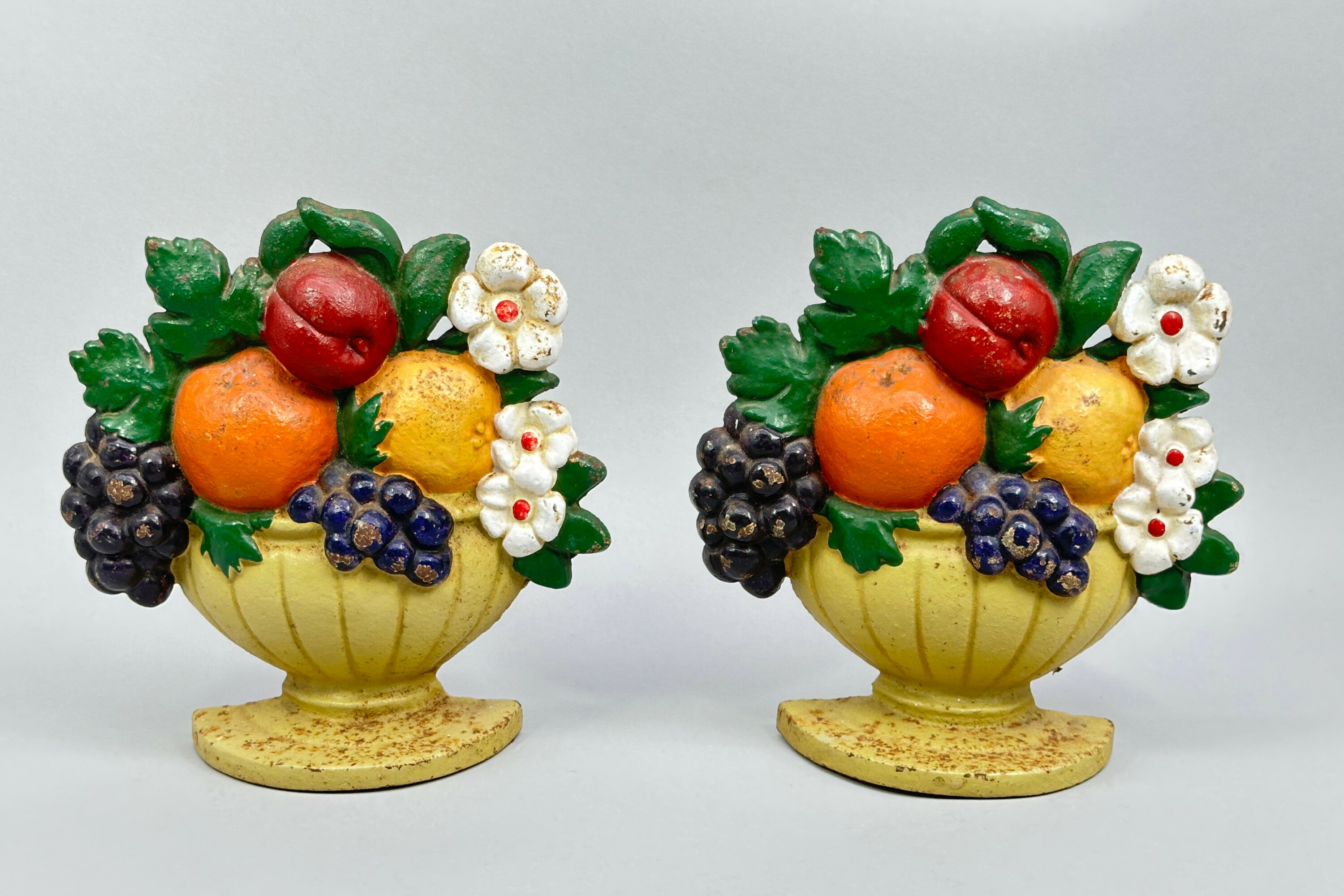
Pair cast iron Doorstops, Basket of Fruit, probably American mid C20th
Price: £45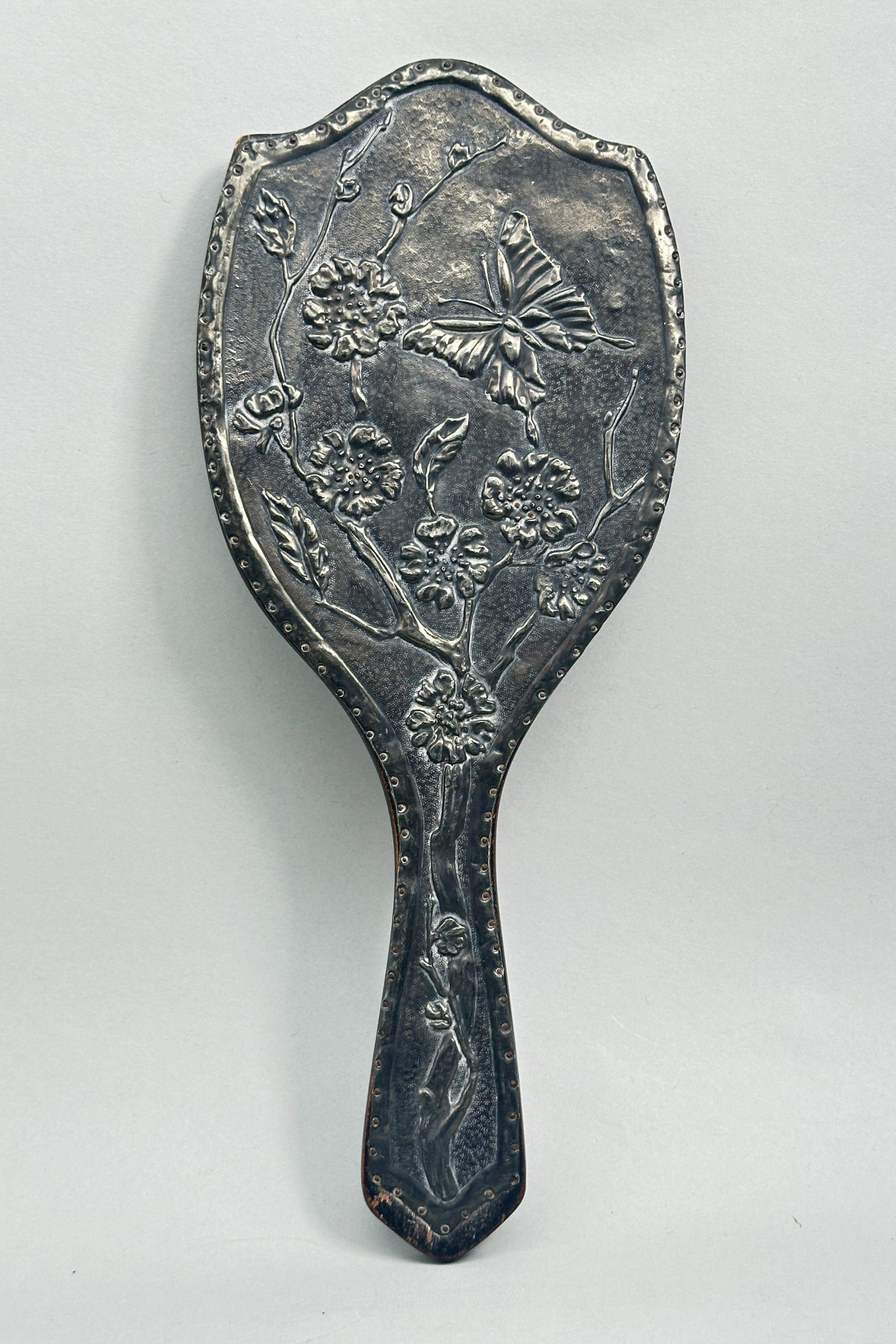
Arts and Crafts Hand Mirror with Repousse Decoration, circa 1900
Price: £55Elements of two contrasting contemporary styles combine here with features from both the Arts and Crafts and the Art Nouveau movement. The hammered pewter with the almost rustic nail head fixings and the red bead reflect the former but the elegant depiction of the lotus and butterfly, with more than a hint of the Orient, reflect the latter. The maker is anonymous but doubtless British and clearly a highly skilled craftsman. Much thought and expertise went into the design of this piece which would be a desirable addition for collectors of either or both of the pieces made under the influence of these two highly popular design movements.
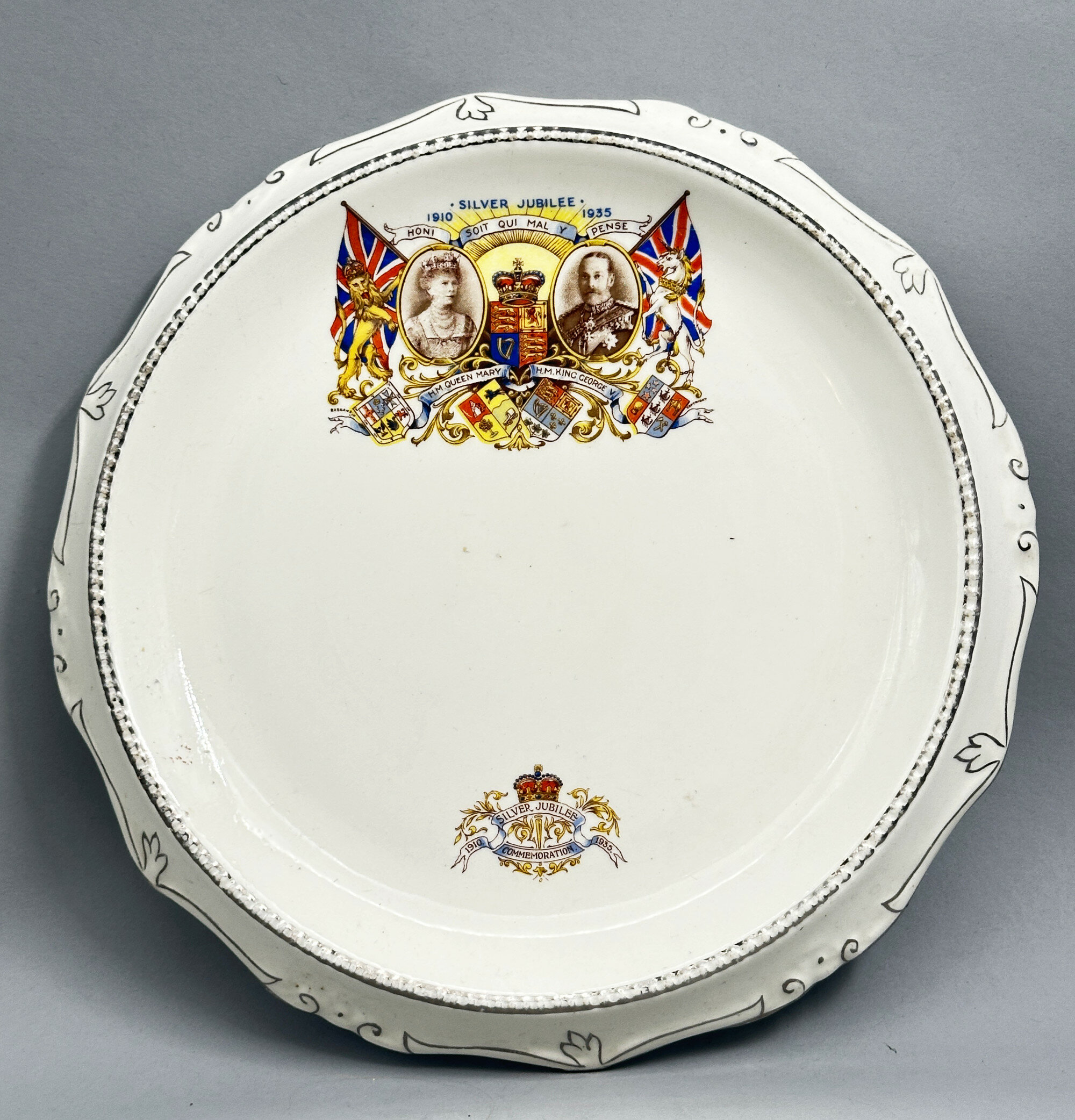
Commemorative Ware Silver Jubilee Plate, James Kent Ltd, England, 1935
Price: £35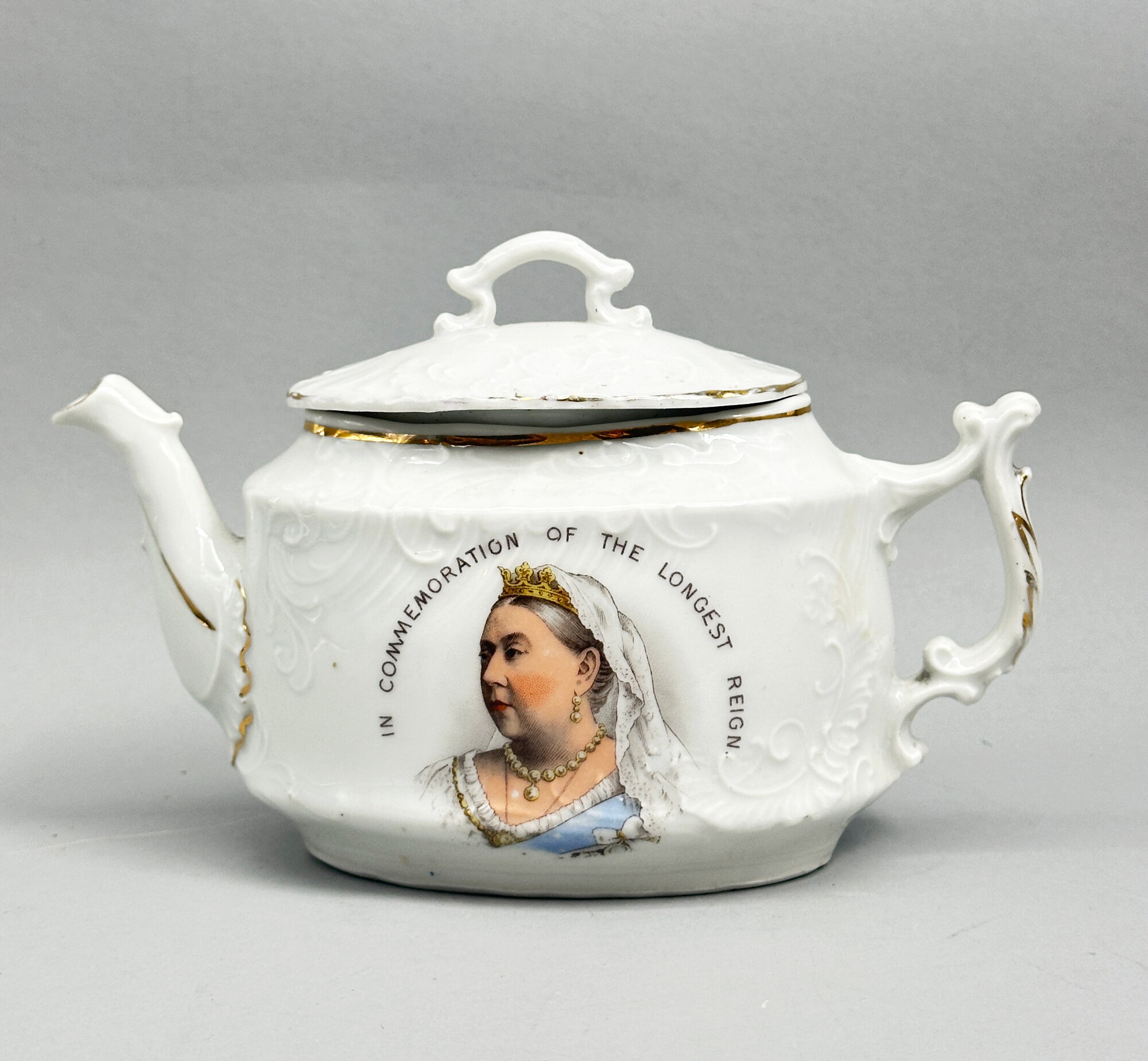
Reproduction Queen Victoria Diamond Jubilee Teapot, Modern
Price: £35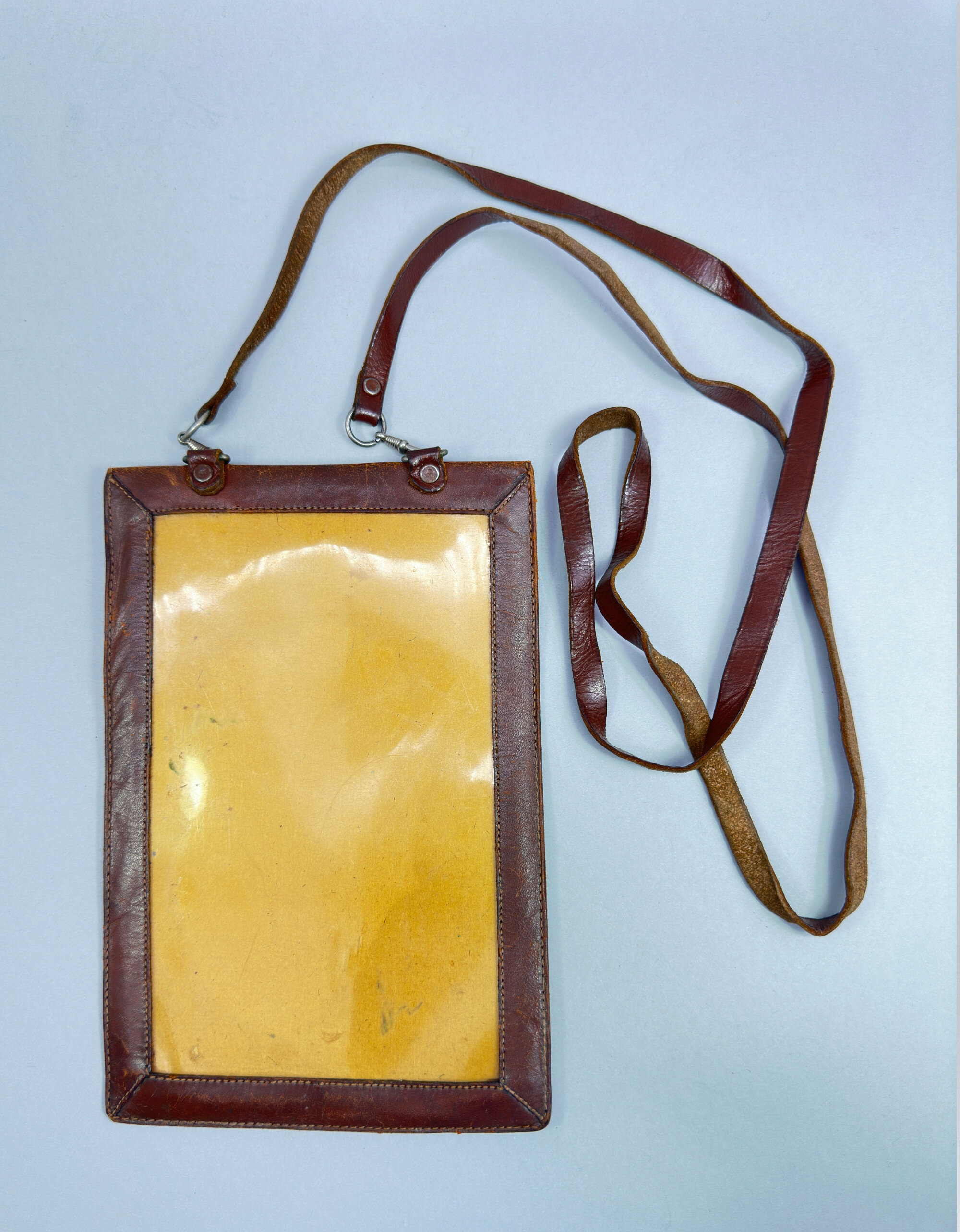
Vintage Leather Map Case, probably 1940s
Price: £45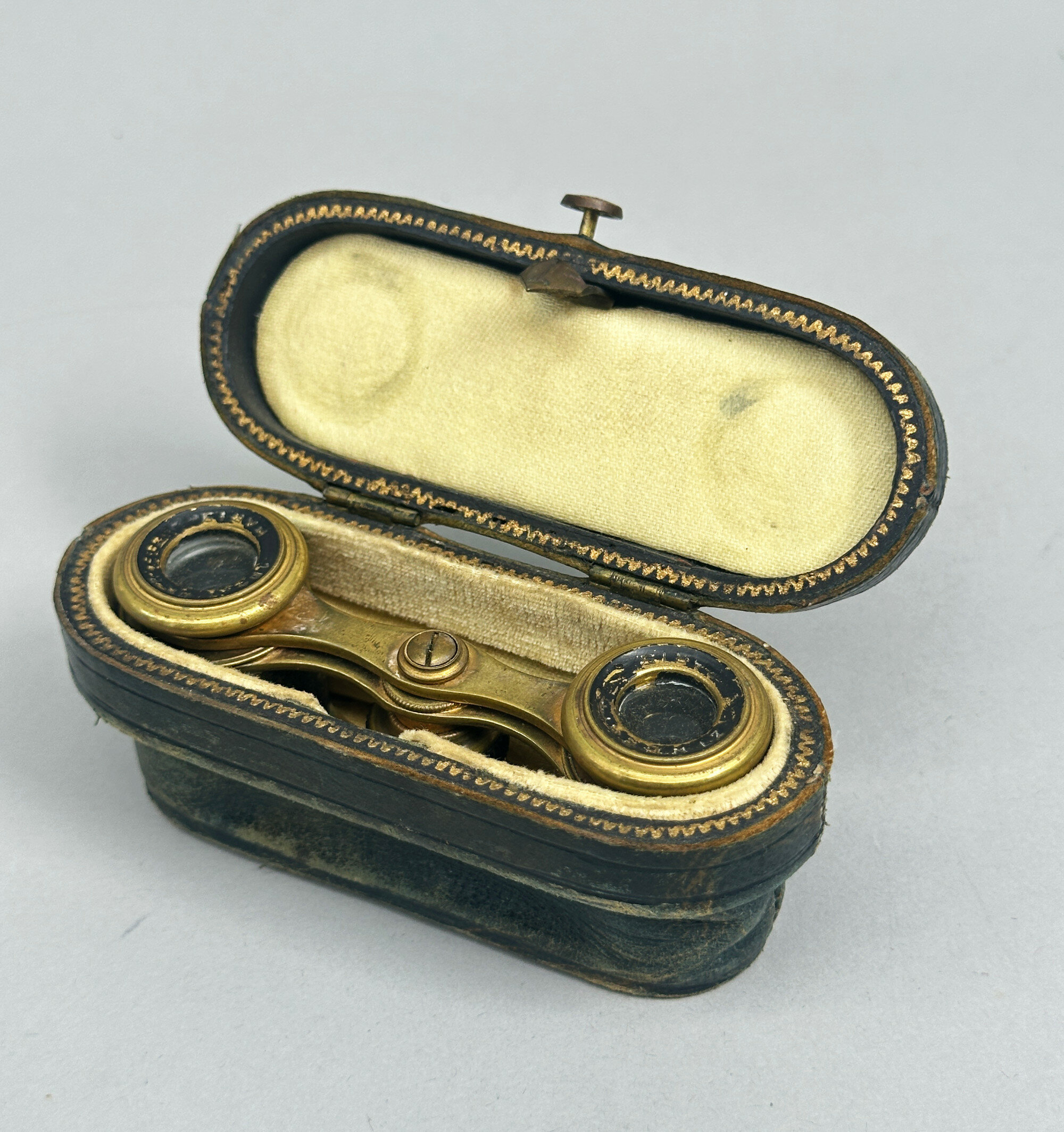
Pair of Opera Binocular Glasses in green leather Case, French, first half C20th
Price: £25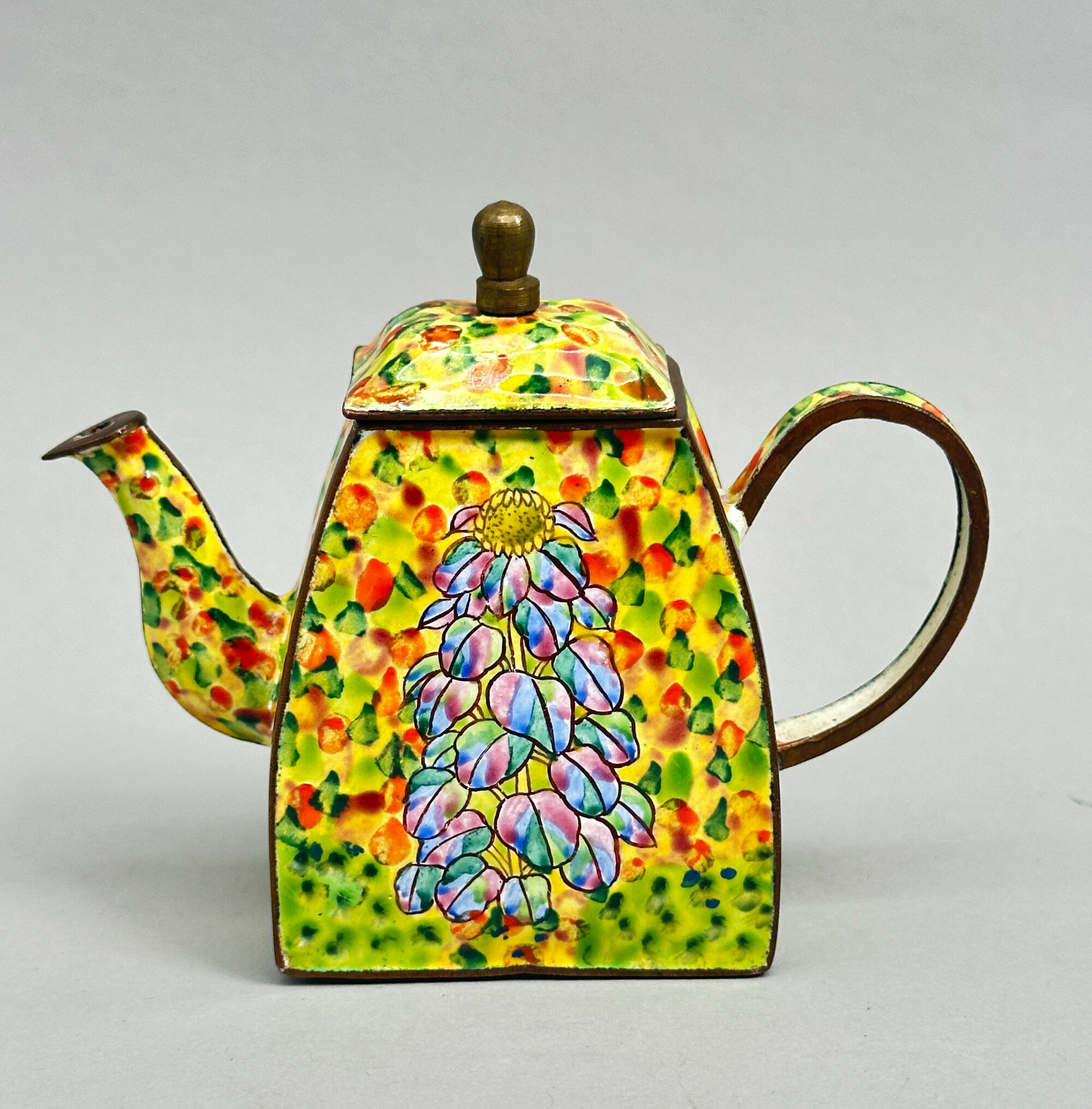
Trade+Aid Enamel Teapot, No.292.UK, 1990s
Price: £25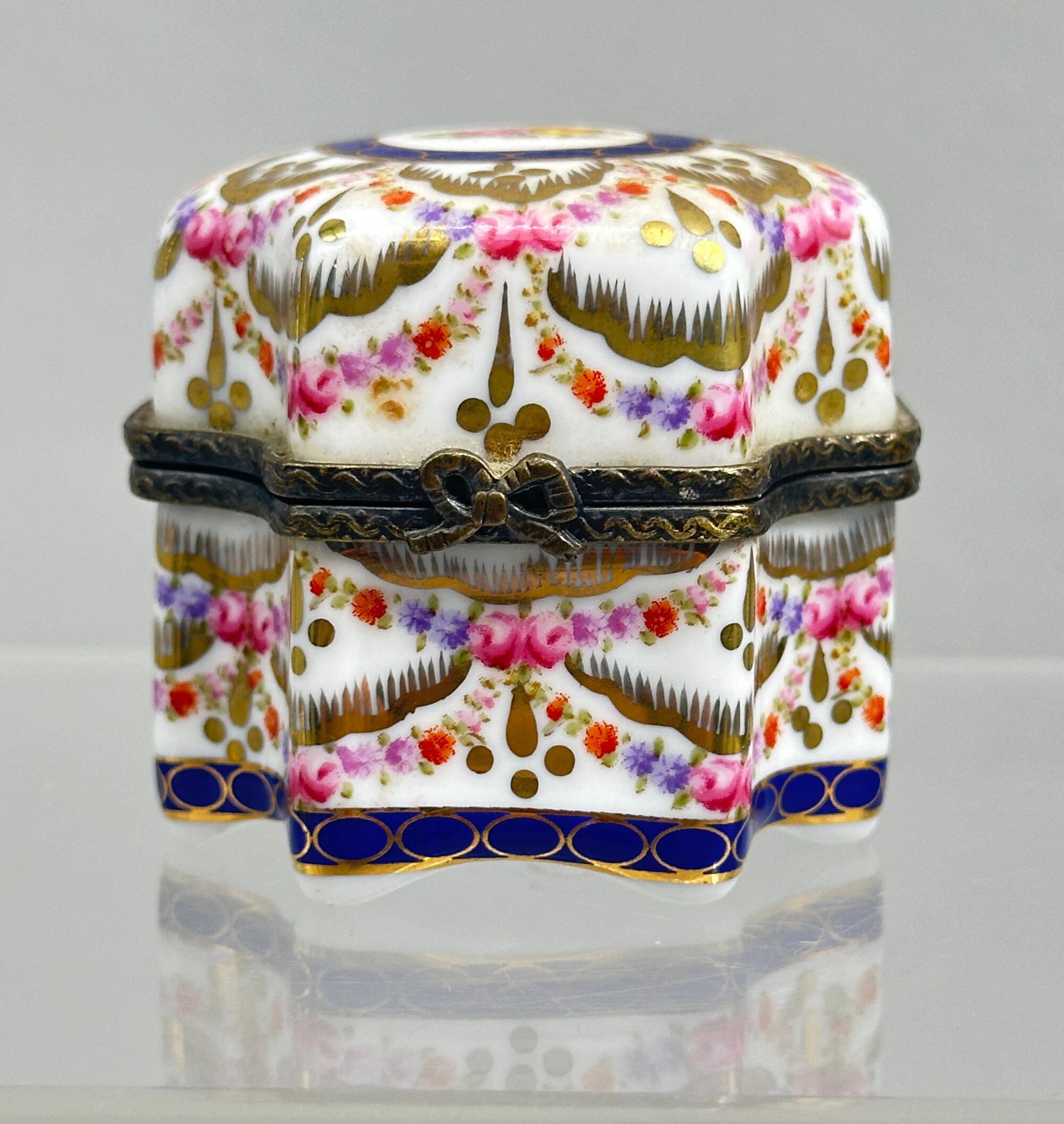
Reproduction Limoges Porcelain Box with Scent Bottles, Modern
Price: £25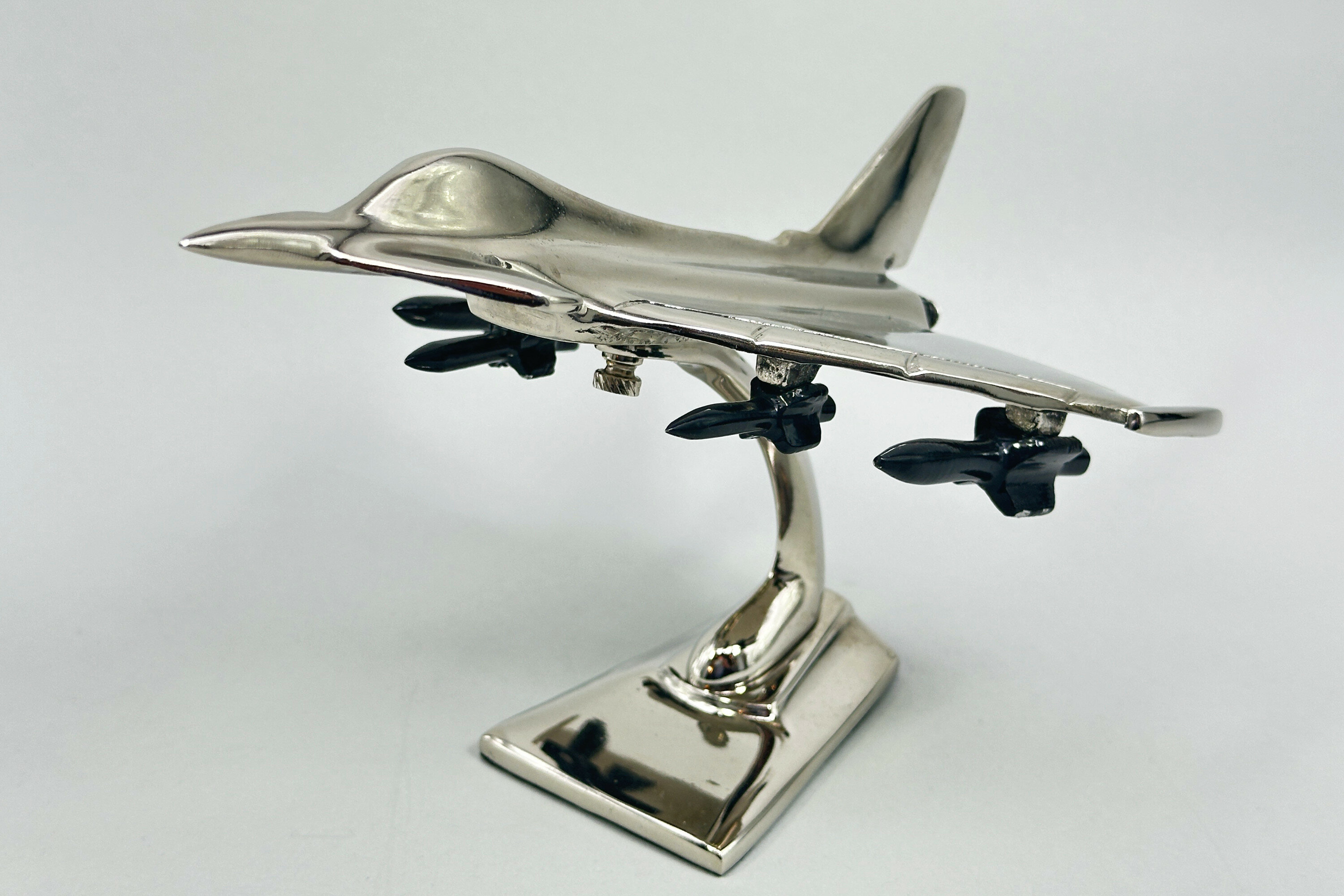
Desktop Model of a Typhoon Bomber Plane, Modern
Price: £45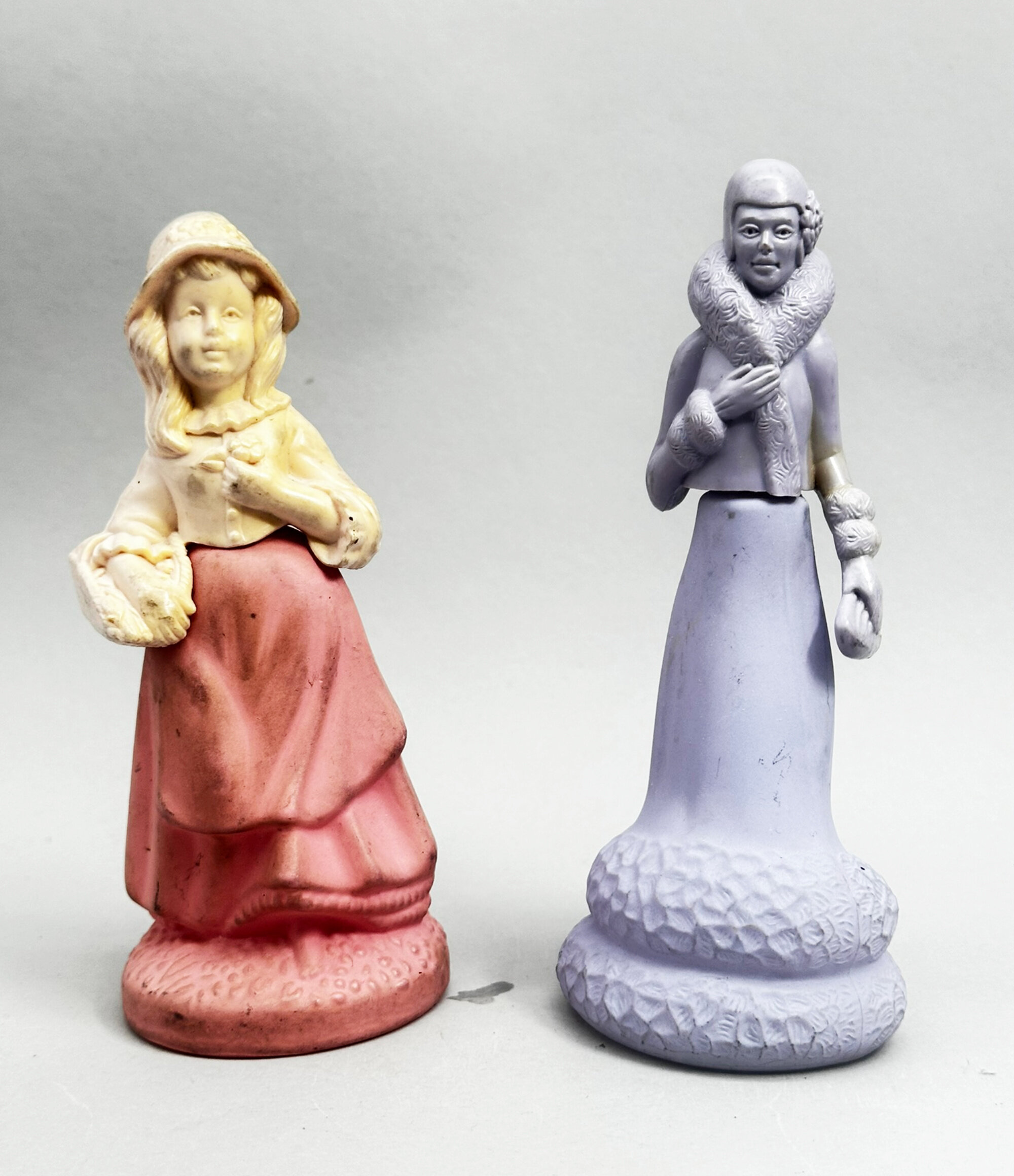
Two Avon Perfume Bottles, Lady and a Girl, 1970s
Price: £20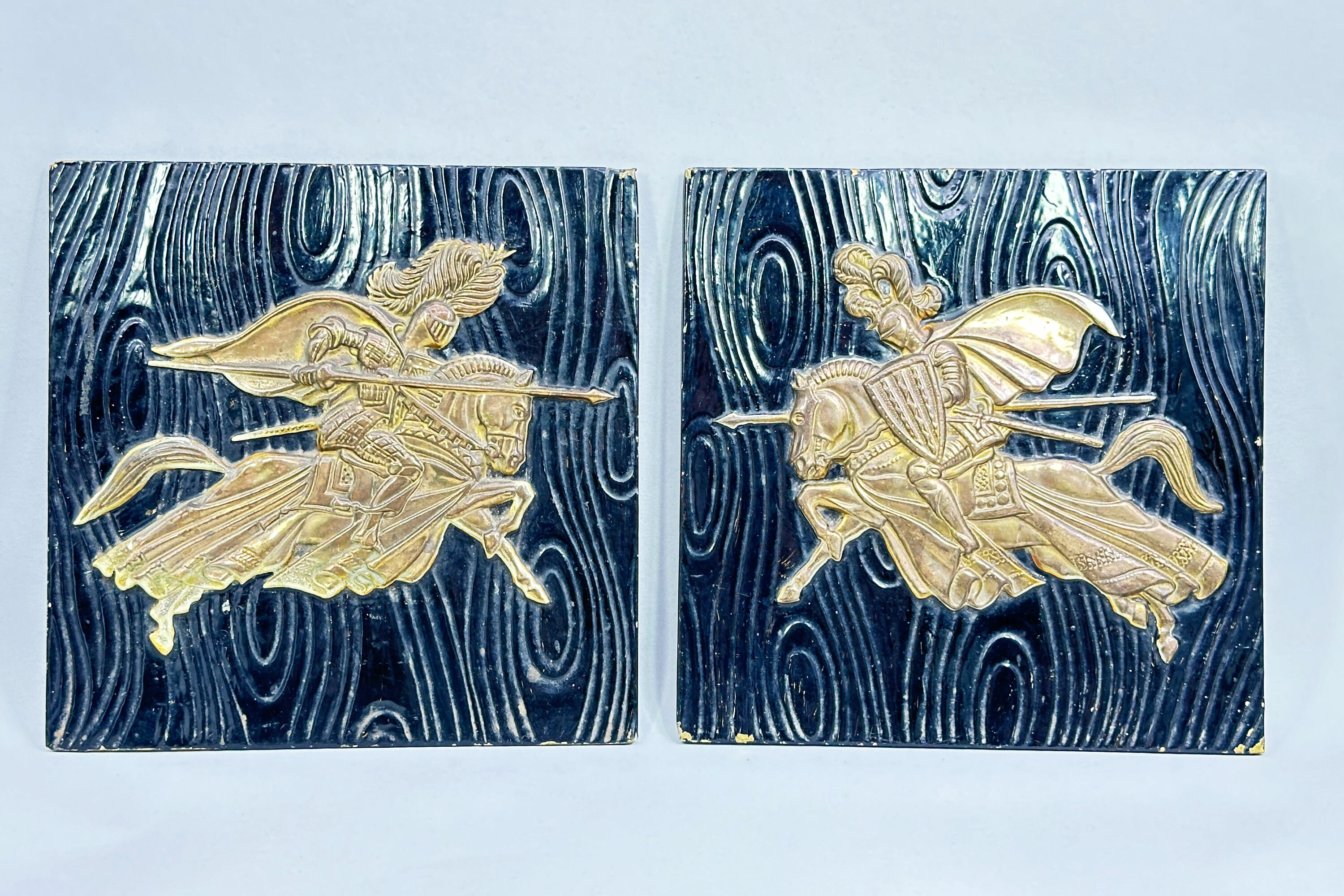
Pair of Brass Wall Plaques of Jousting Knights, Peerage Brass, mid C20th
Price: £45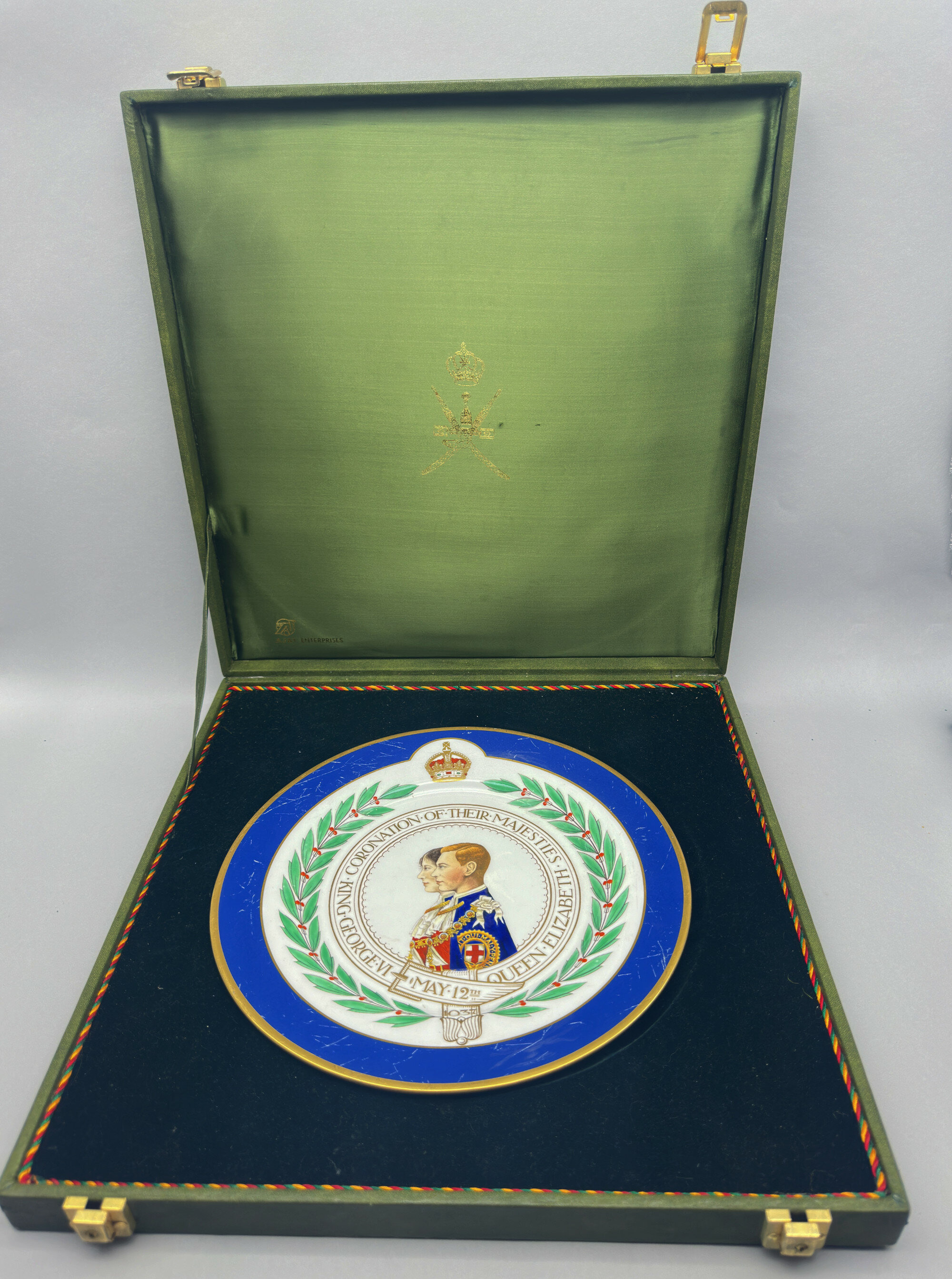
Mintons Coronation Plate, King George VI and Queen Elizabeth 1937, boxed
Price: £25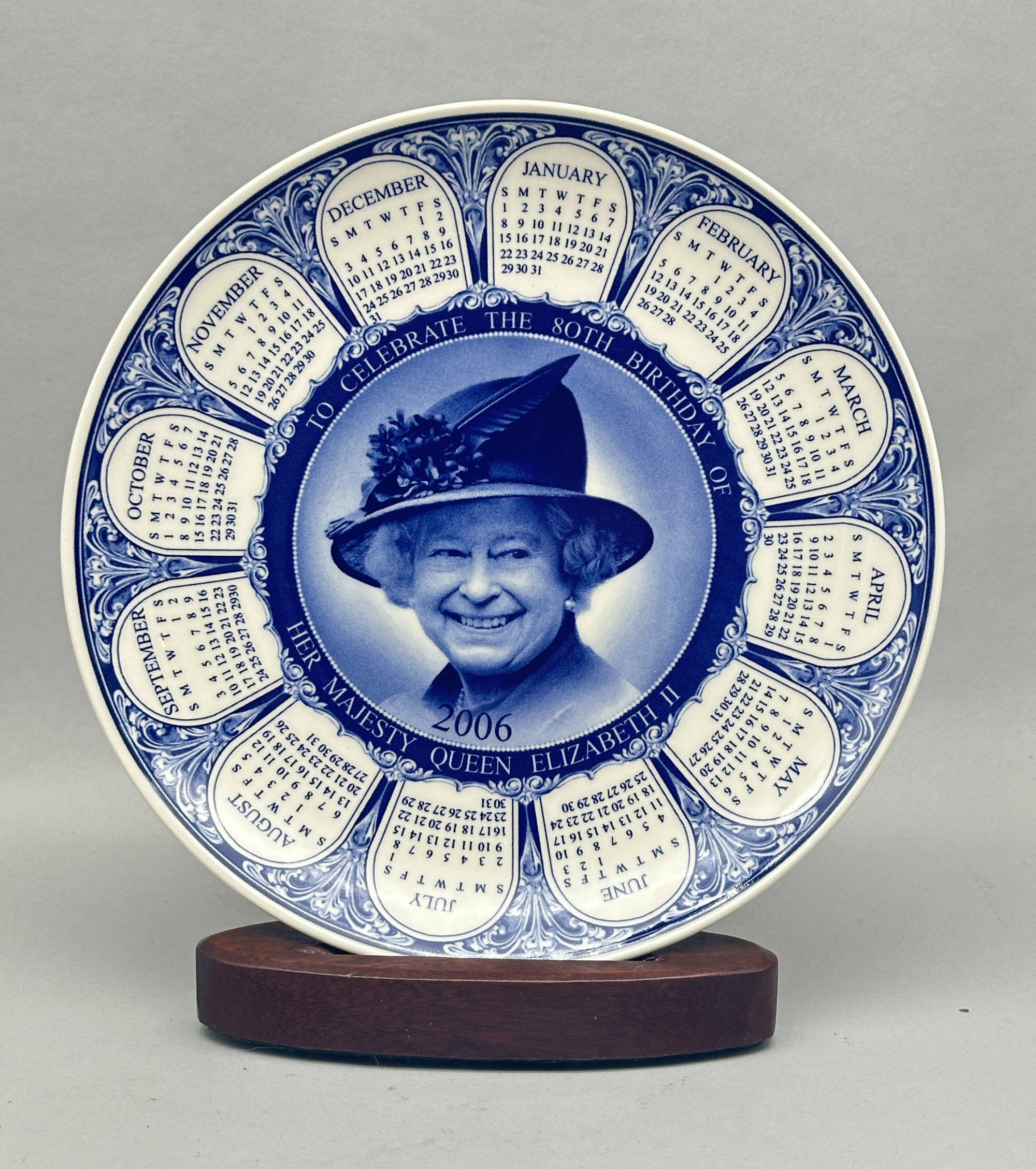
Wedgwood Calendar Plate, 80th Birthday of Queen Elizabeth II, 2006
Price: £10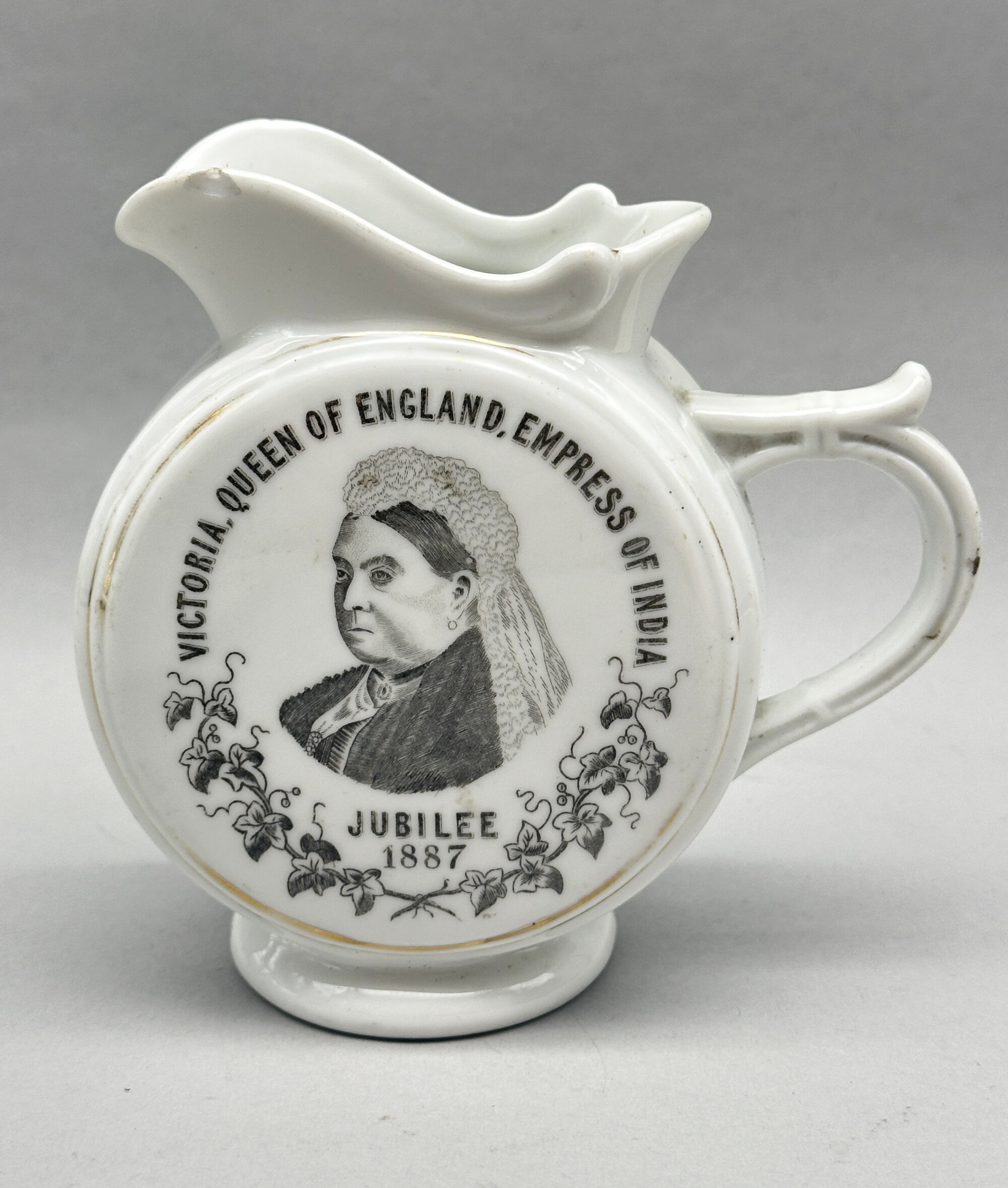
Queen Victoria Golden Jubilee Jug, 1887
Price: £10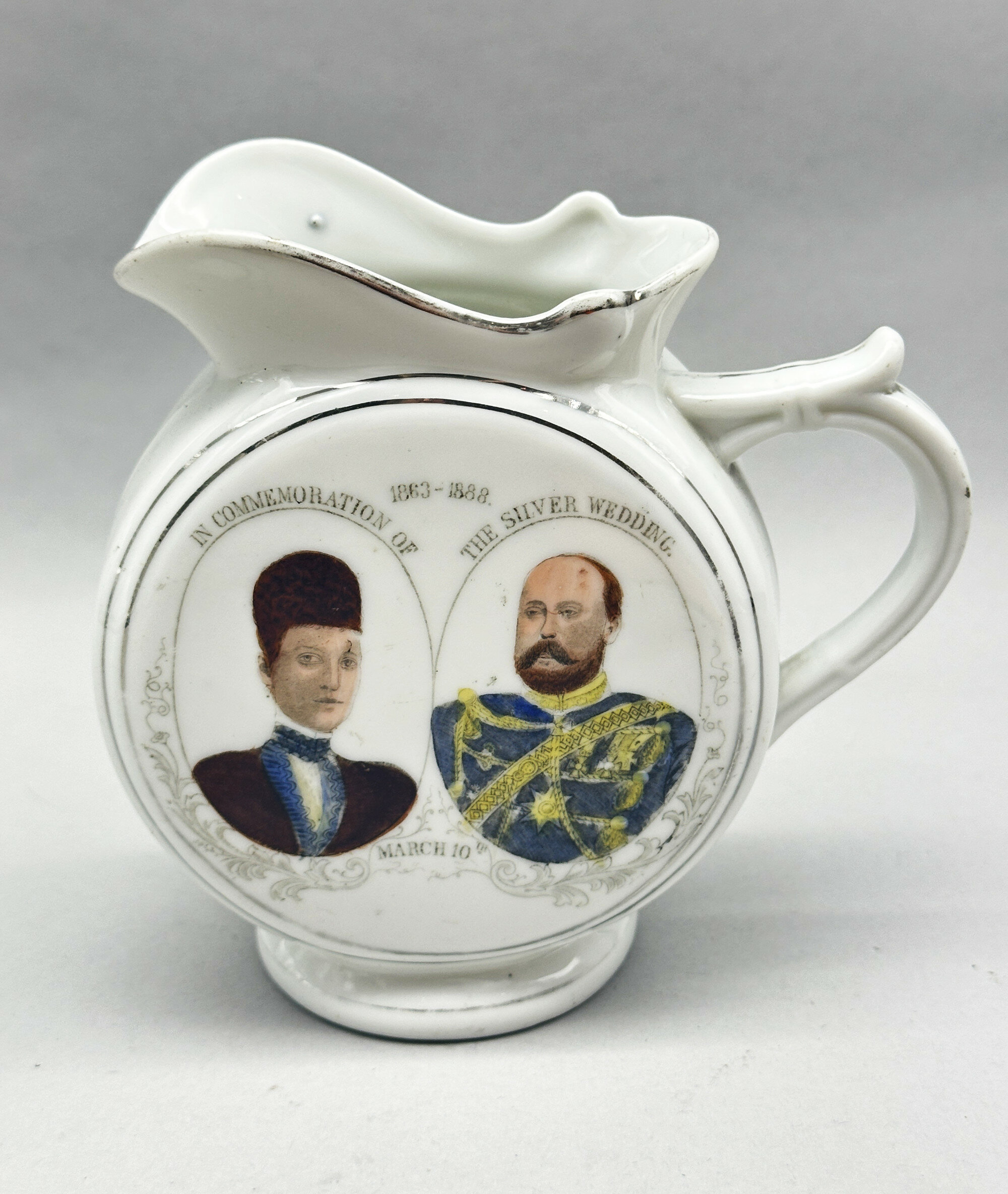
Prince Edward and Princess Alexandra, Silver Wedding Jug, 1888
Price: £25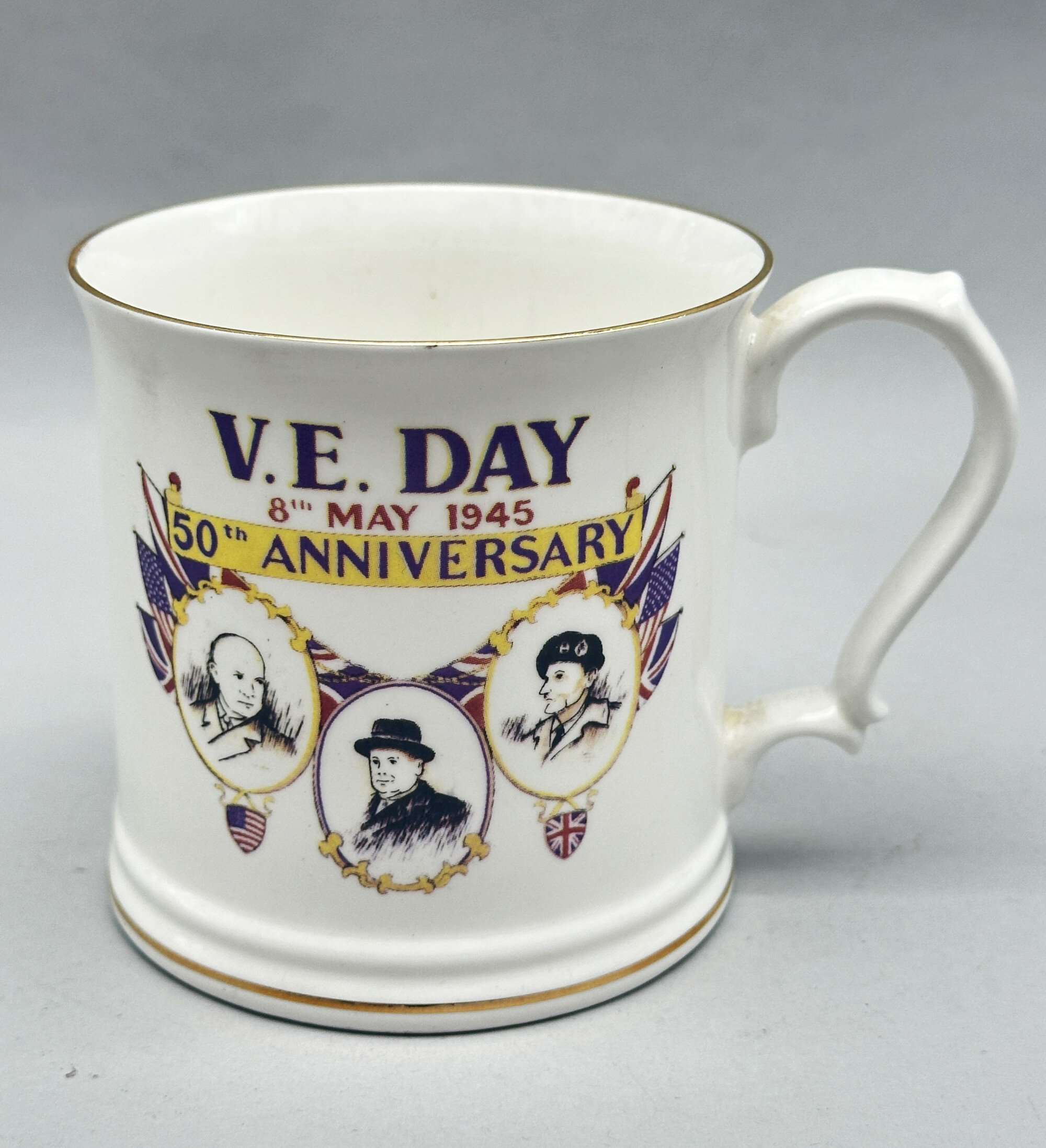
VE Day, 50th Anniversary Commemorative Mug, 1995
Price: £10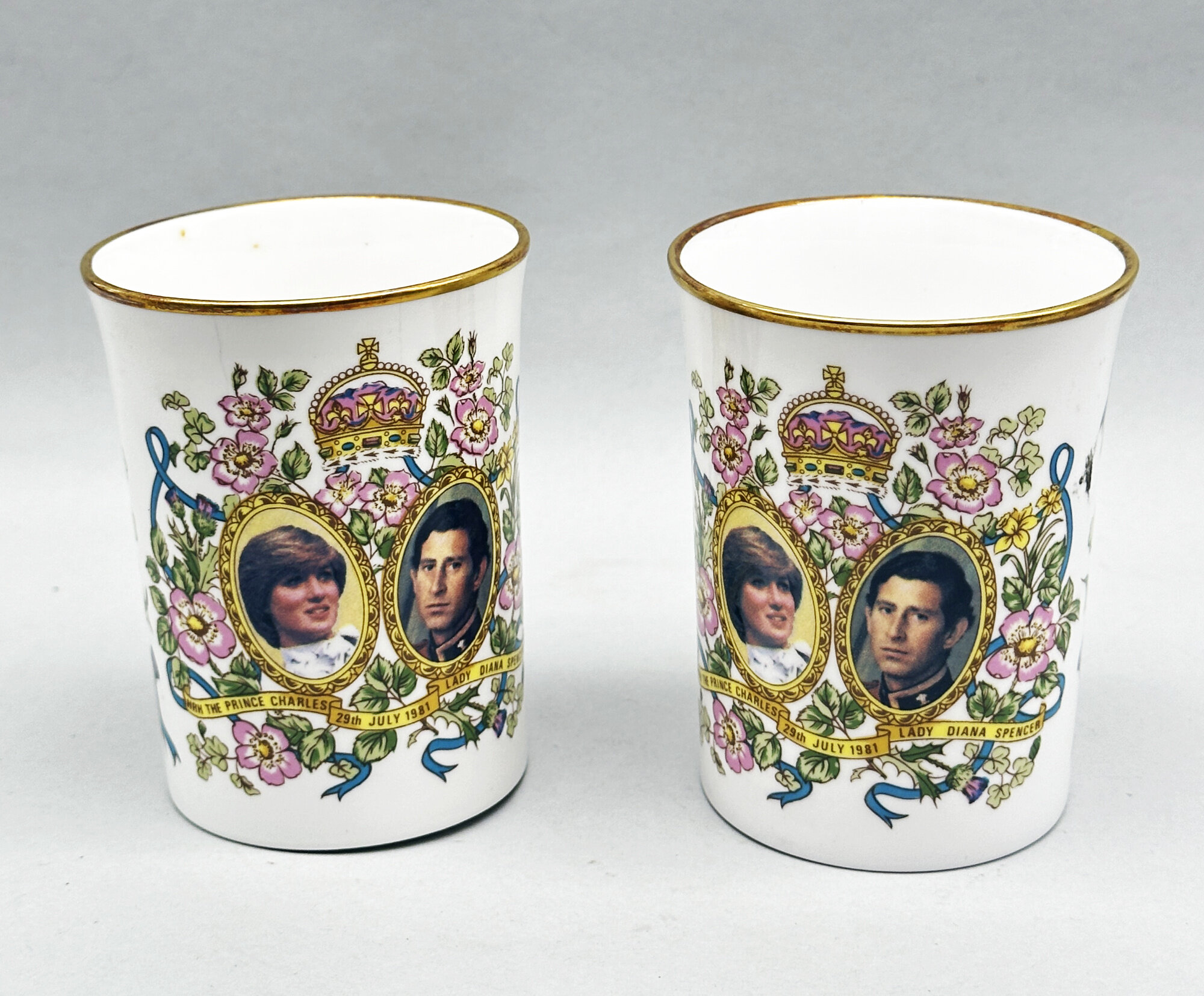
Two Beakers : Wedding of the Prince Charles and Lady Diana Spencer, 1981
Price: £15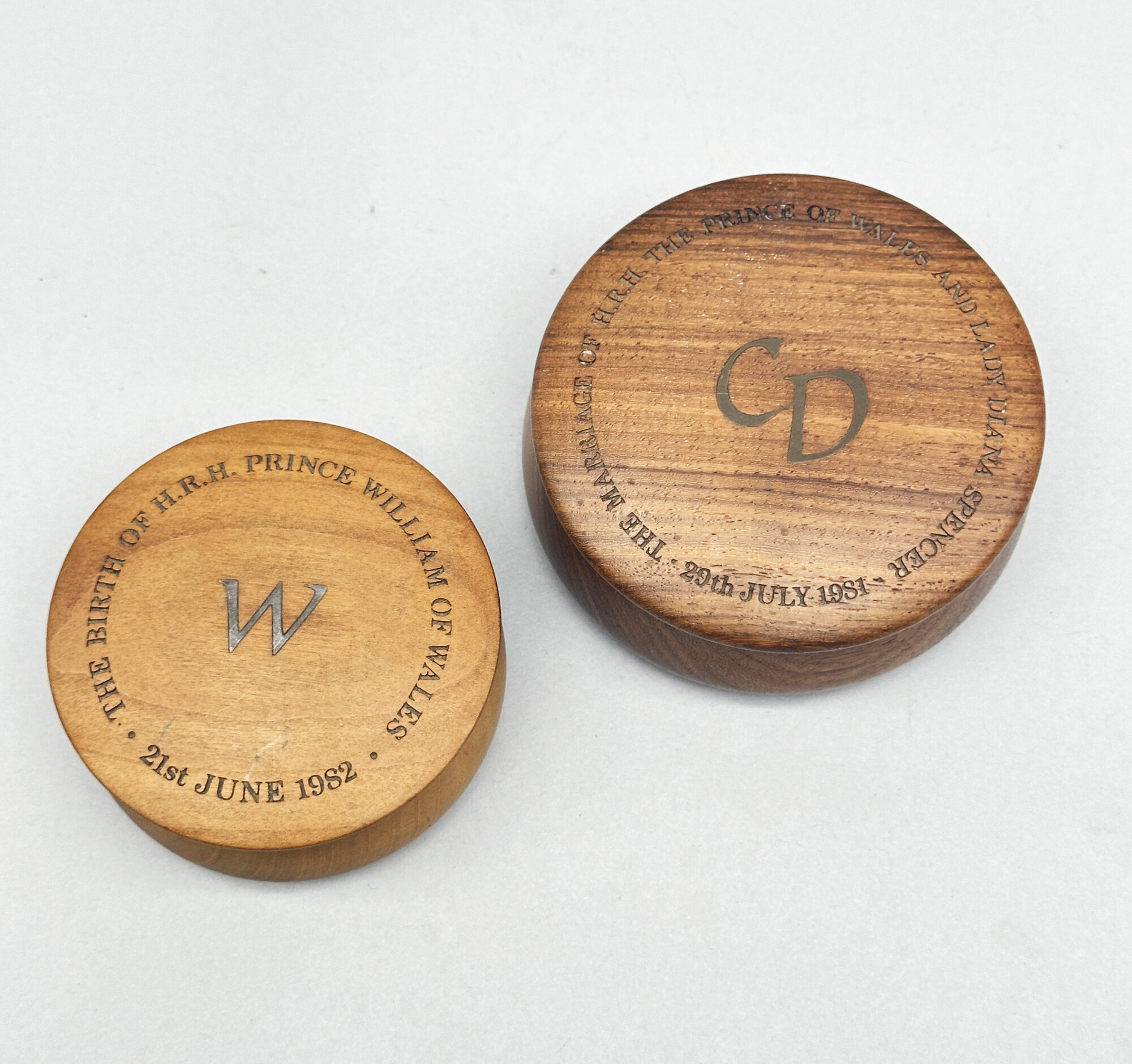
Two Wood Boxes : Marriage of Charles and Diana, Birth of Prince William, late C20th
Price: £15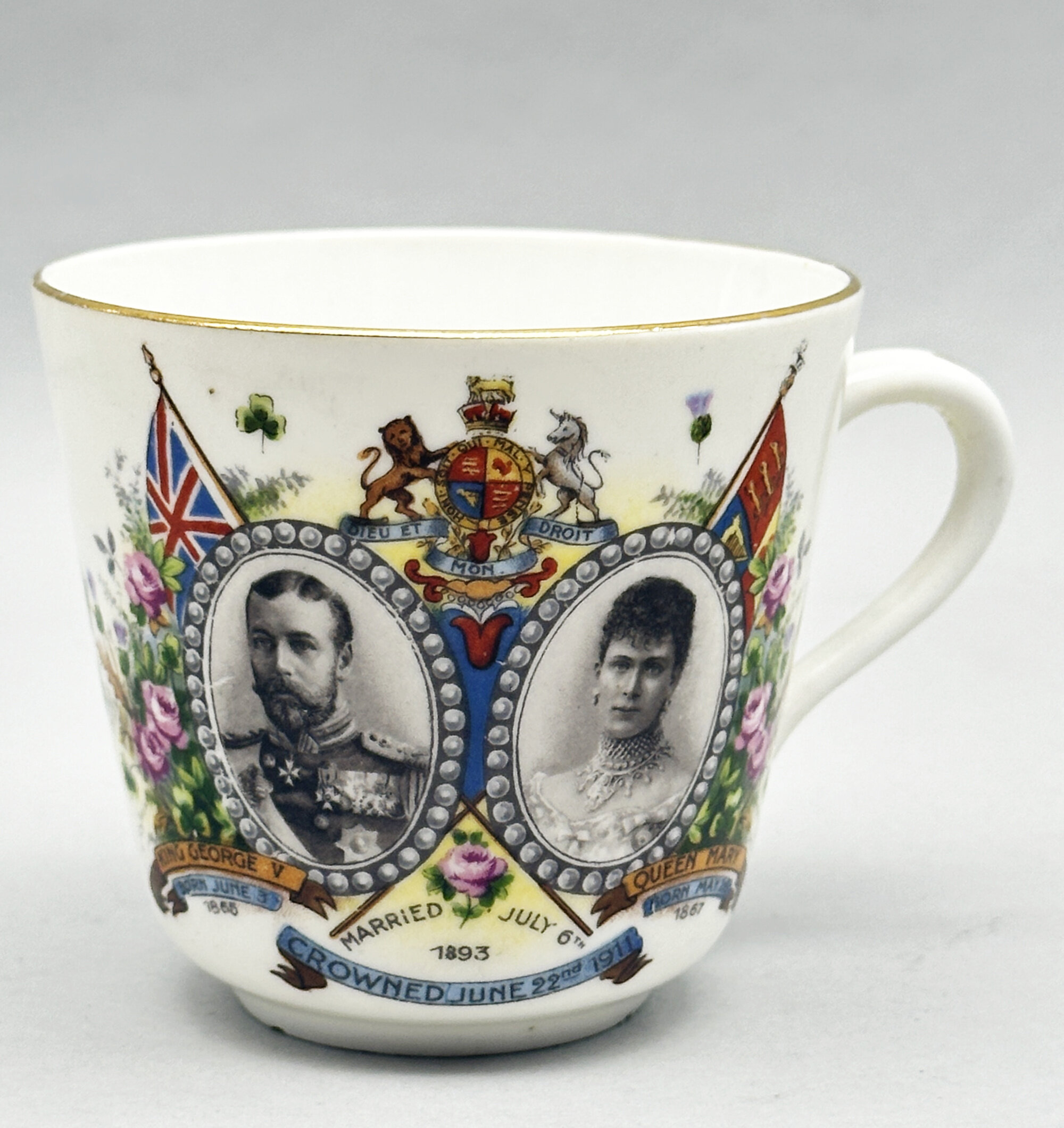
Cup : Marriage and Coronation of King George V and Queen Mary, 1911
Price: £10Production of this piece was presumably contemporary with the coronation in 1911 and many similar pieces were made by other factories at the time, more often in a straight sided mug shape. The form here suggests that there might have been an original saucer but none seem to have survived.
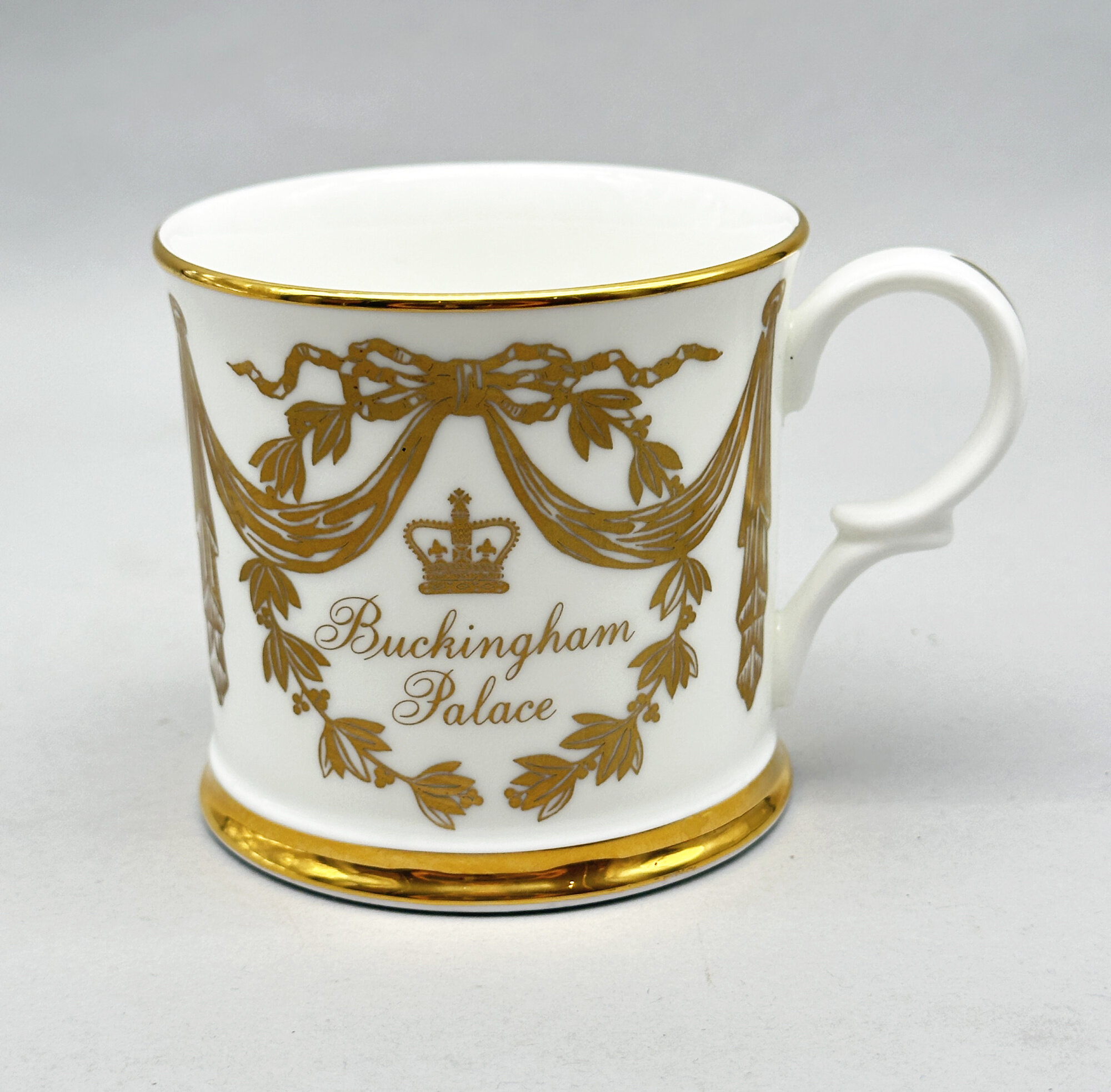
Porcelain Mug : Buckingham Palace 1997
Price: £10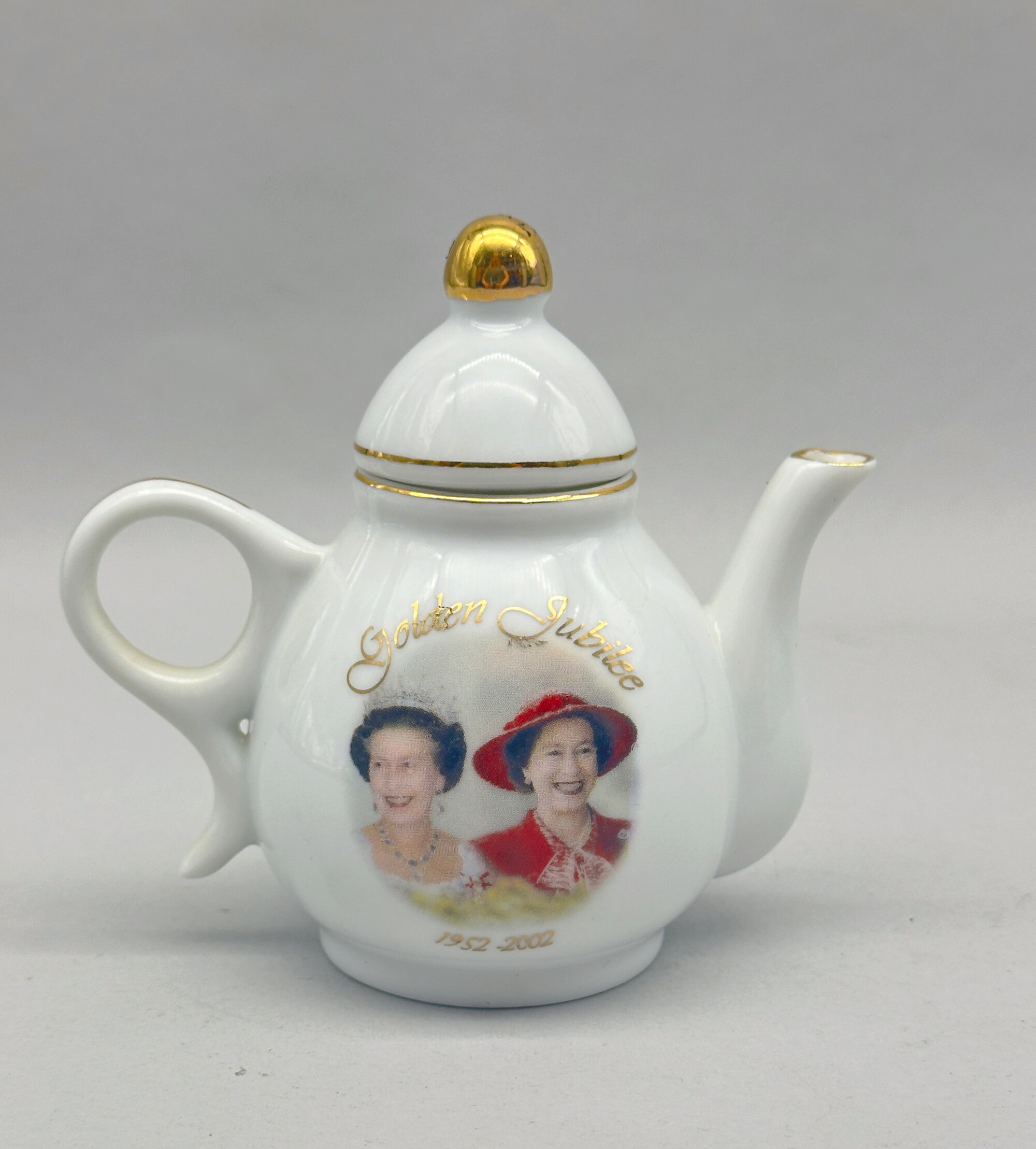
Teapot and Cover : Golden Jubilee Queen Elizabeth II, 2002
Price: £10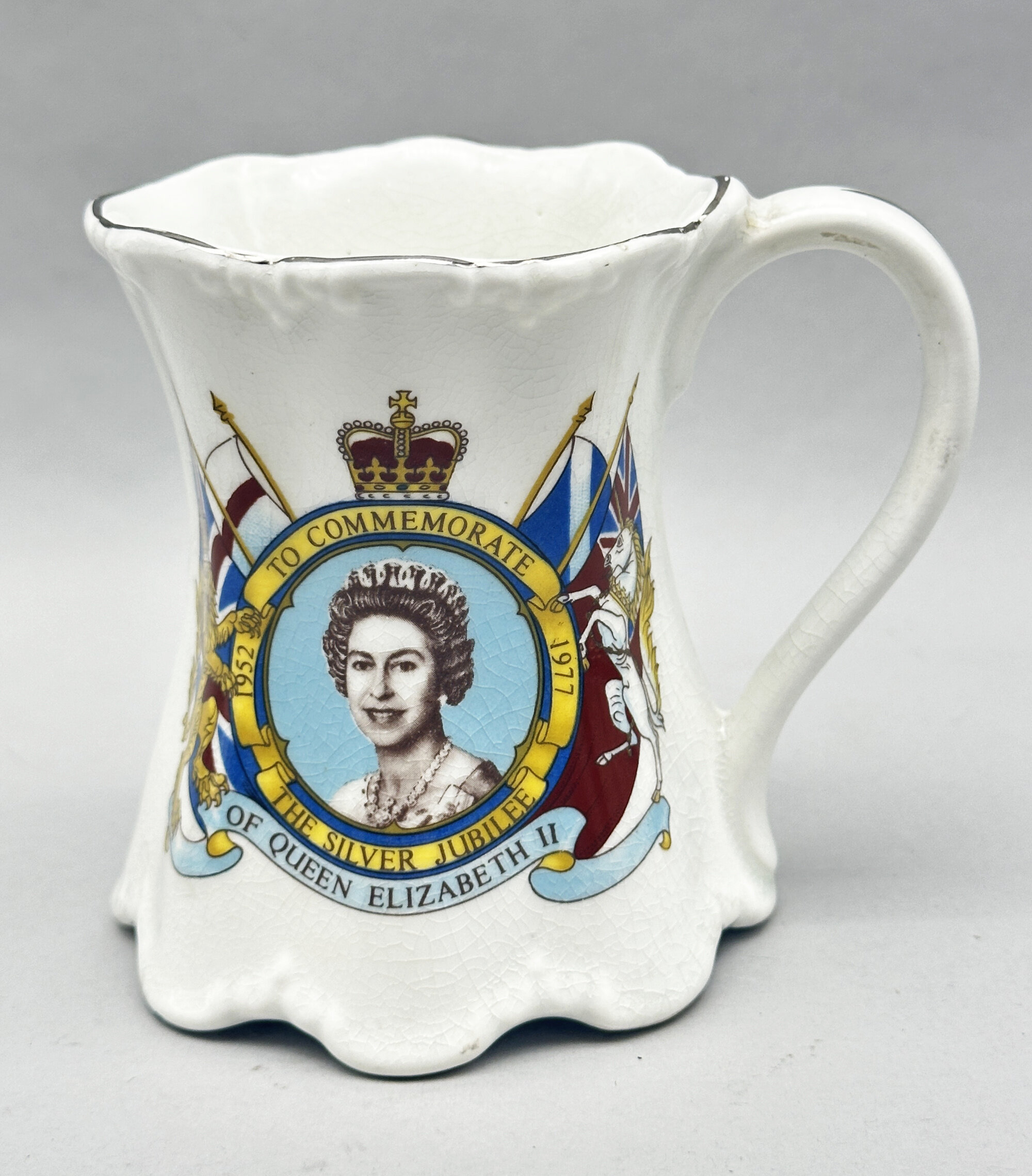
Queen Elizabeth II Silver Jubilee China Mug, 1977
Price: £10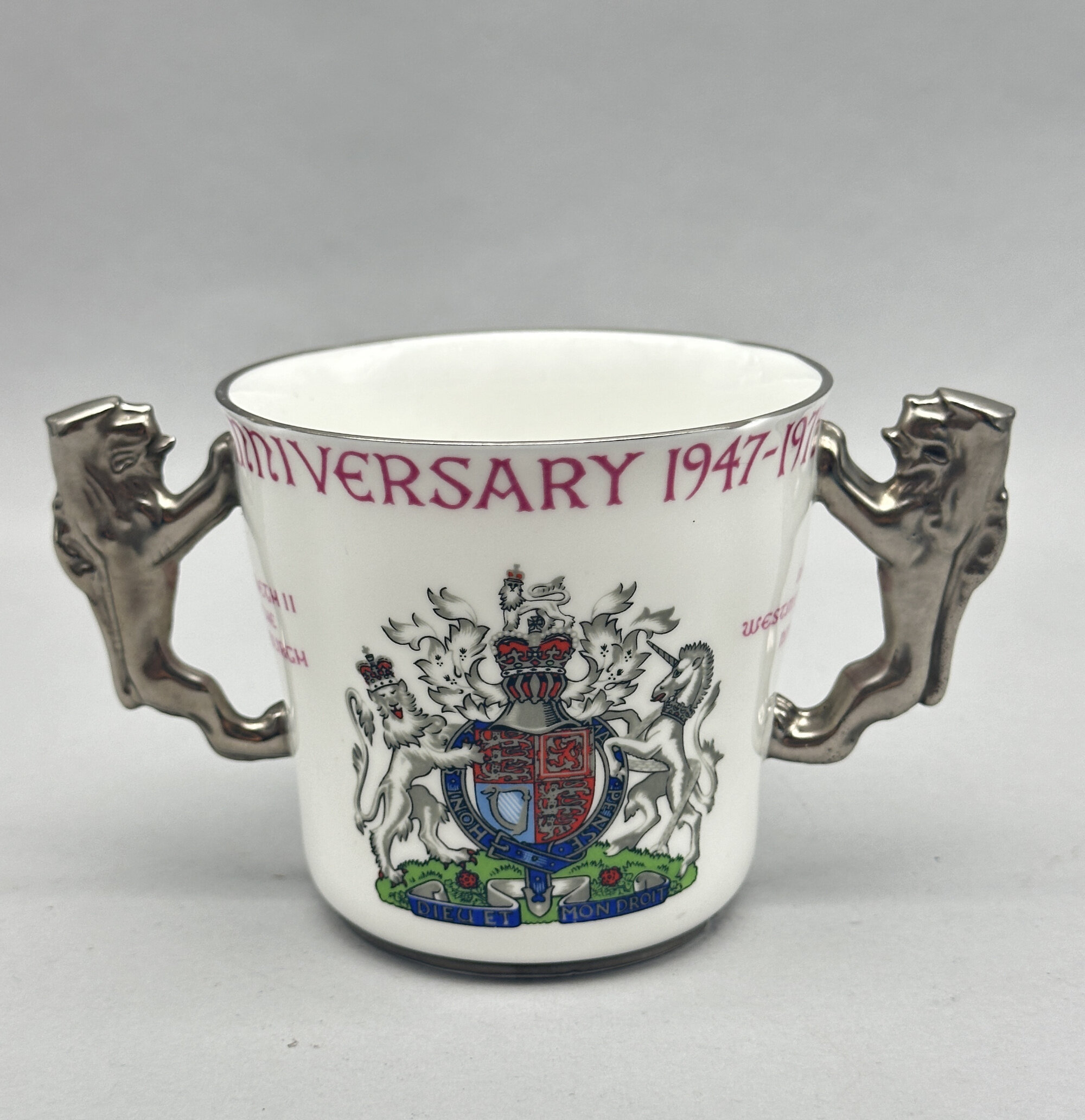
Cup : the Silver Wedding Anniversary of Queen Elizabeth II and Prince Philip in 1972
Price: £25The Paragon China Company, formerly the Star China Company (see Lot XX), produced high quality gift items from 1920 to 1971, at first independently and then in alliance with other companies, finally being absorbed by Royal Doulton in 1972 who kept the ‘Paragon’ name until 1991. Commemorative wares were a speciality and this cup is a fine and typical example.
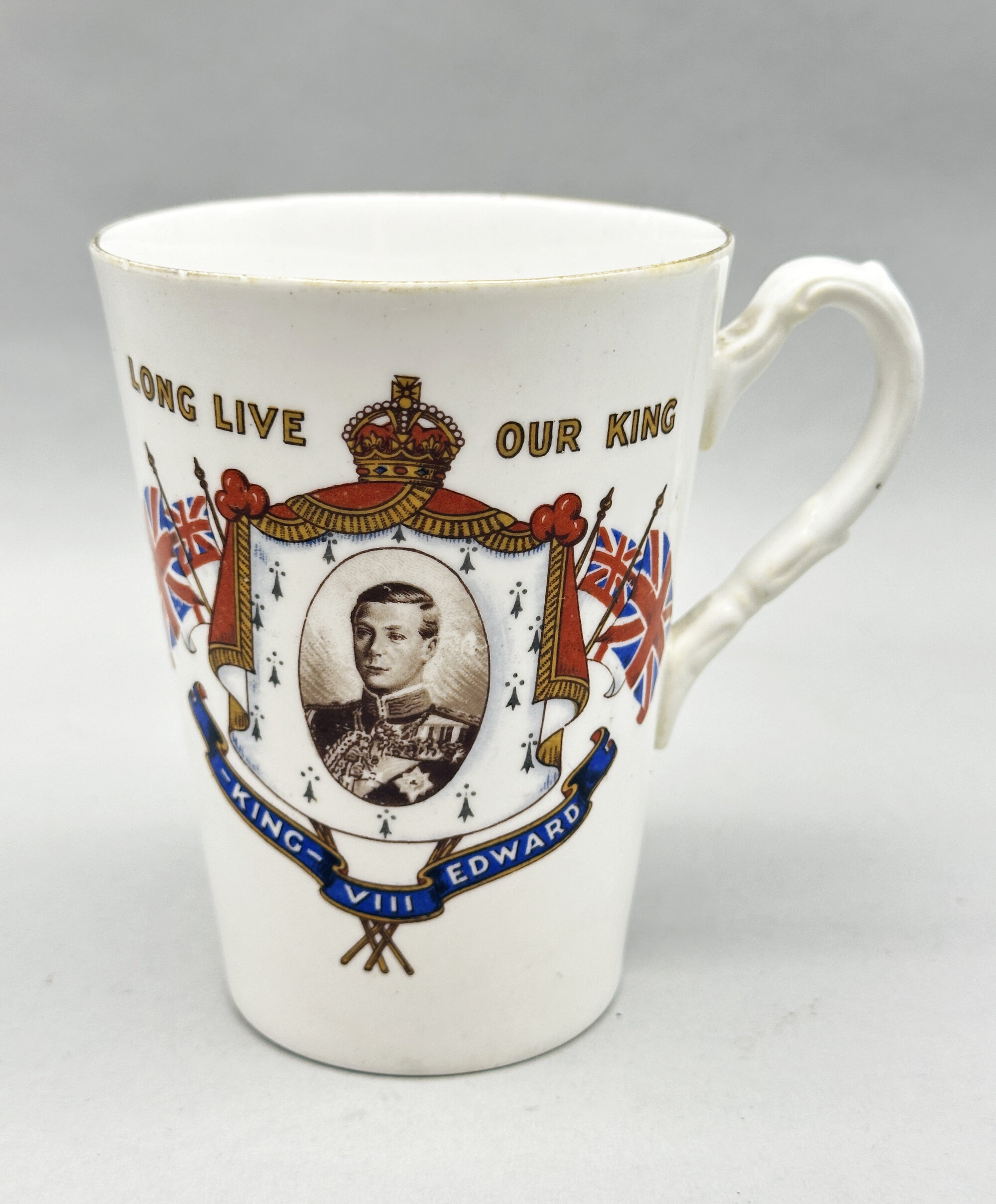
Mug Commemorating the Coronation of Edward VIII in 1937
Price: £25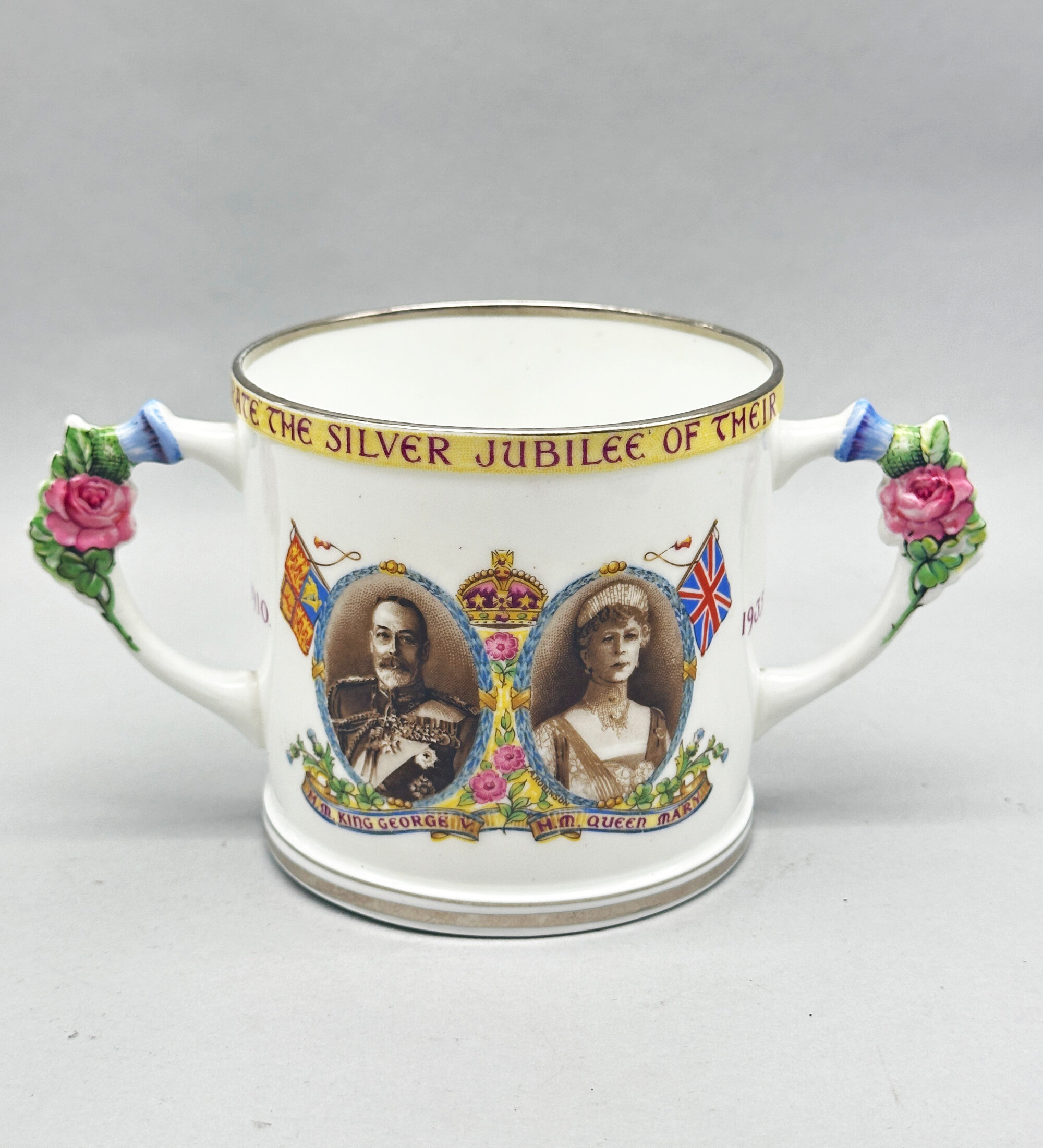
Cup Commemorating the Silver Jubilee of King George V and Queen Mary in 1935
Price: £55The Paragon China Company, formerly the Star China Company (see Lot XX), produced high quality gift items from 1920 to 1971, at first independently and then in alliance with other companies, finally being absorbed by Royal Doulton in 1972 who kept the ‘Paragon’ name until 1991. Commemorative wares were a speciality and this cup is a fine example.
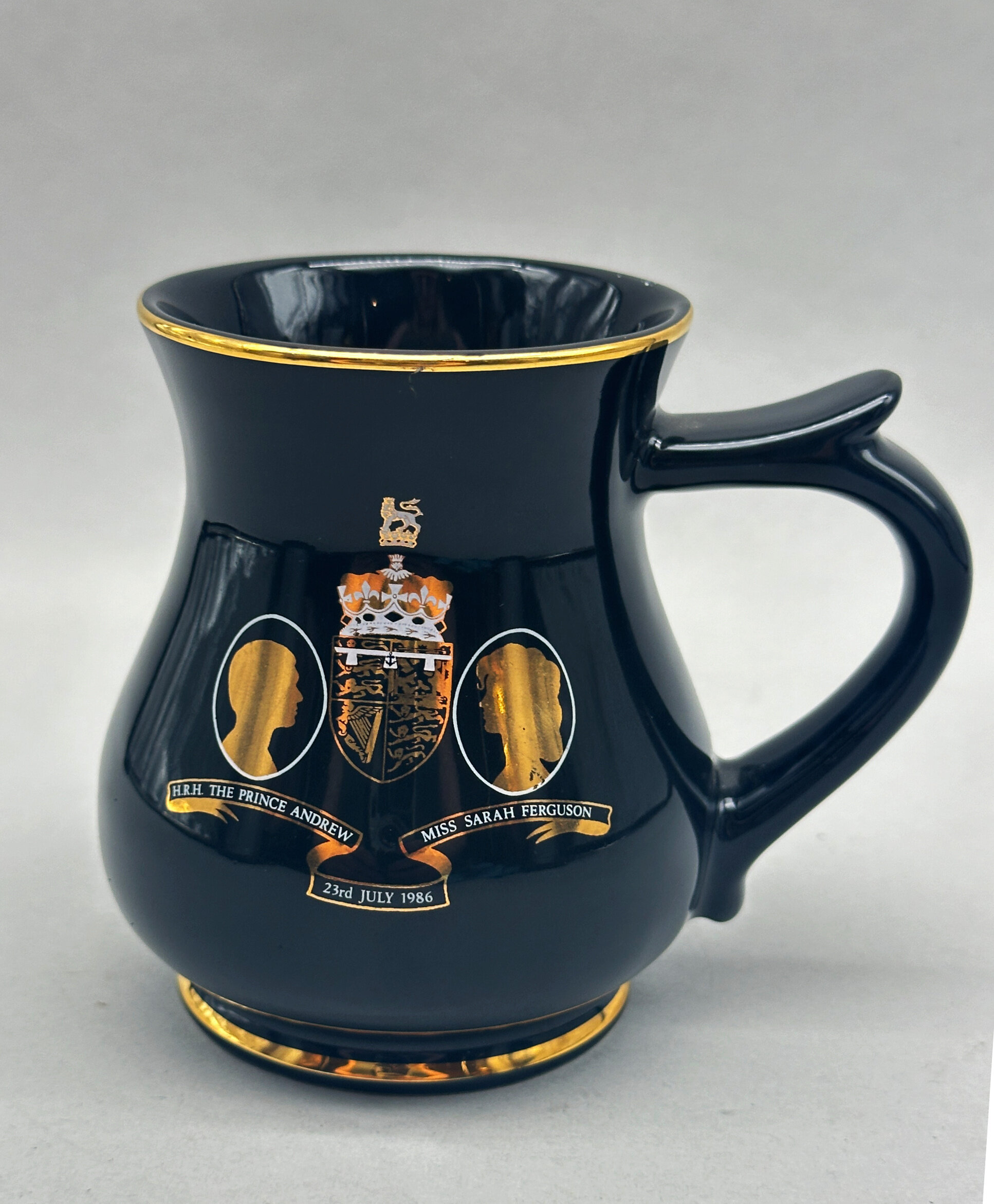
Ceramic Tankard celebrating the Marriage of Prince Andrew and Sarah Ferguson in 1986
Price: £10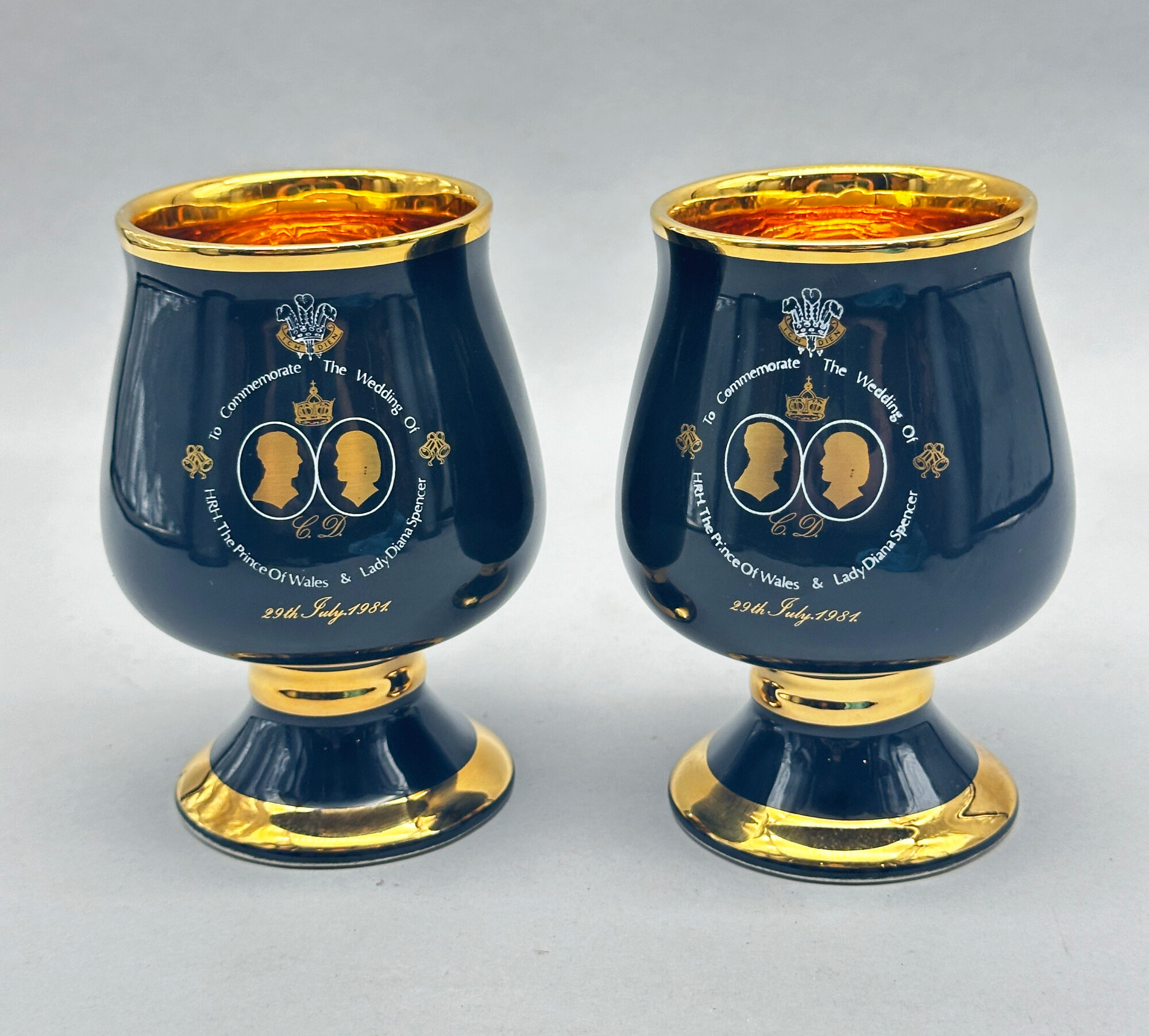
Pair of Ceramic Goblets : the Wedding of Prince Charles and Lady Diana Spencer in 1981
Price: £20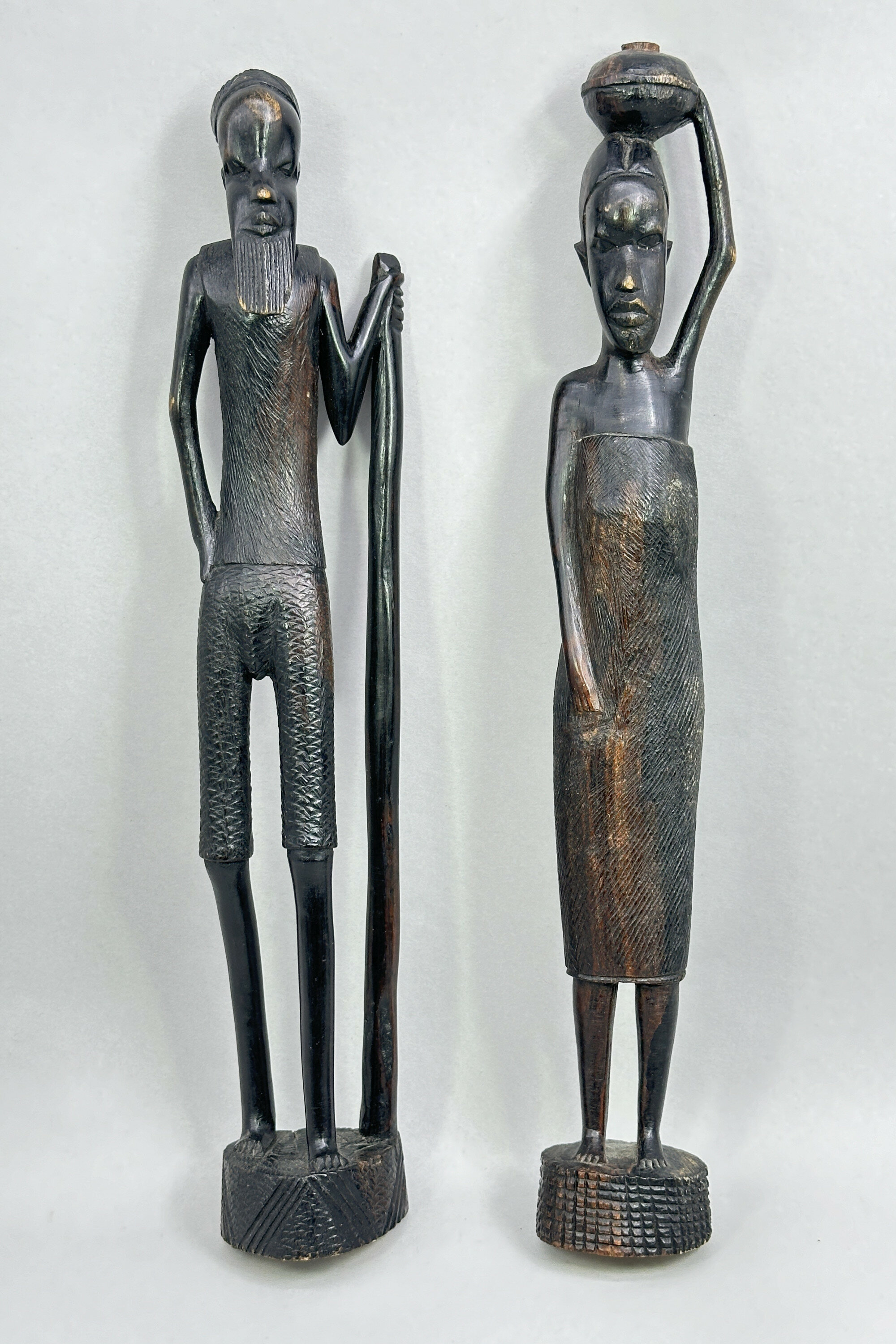
Pair of African Wood Figures of a Man and a Woman, probably mid C20th
Price: £25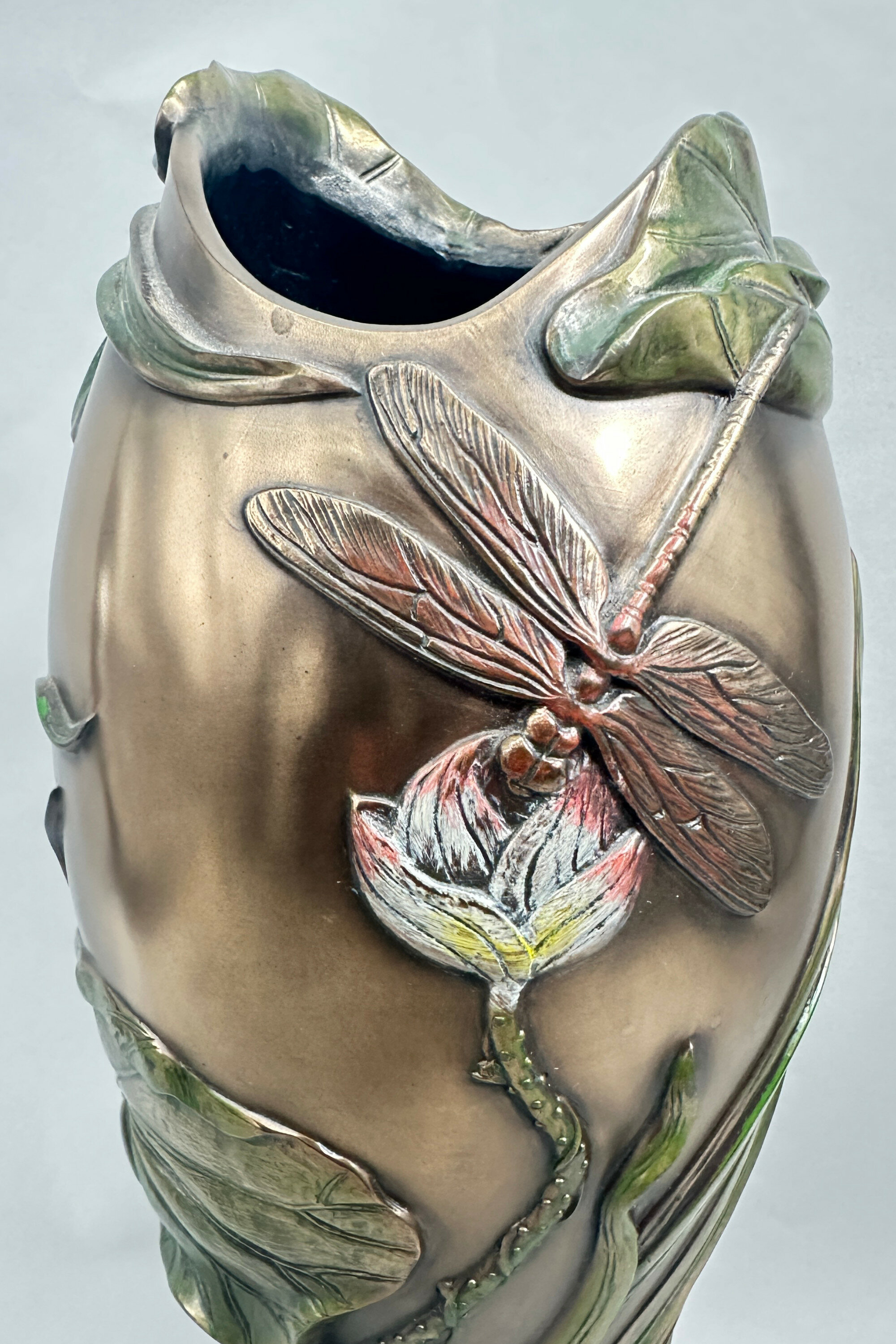
Past Times Art Nouveau Style Vase, Veronese Collection, 2004
Price: £45‘Past Times’ was founded in 1986 by John Beale, at first as a mail order company but then trading from physical stores and developing into a business which enjoyed enormous popularity with over one hundred shops in the early 2000s. The stock was focused on retro and vintage style items also including a wide range of licensed products, such as Harry Potter and Beatrix Potter merchandise. Badly impacted by the recession in 2008 it went into administration in 2012 and was bought by W.H.Smith a year later leading to the disappearance of its products from the marketplace.
This ‘Art Nouveau’ vase can be seen as an example of their range at its best. Manufactured with care it presents an appealing souvenir of the era it aims to recreate at a rather more affordable price than the authentic originals.
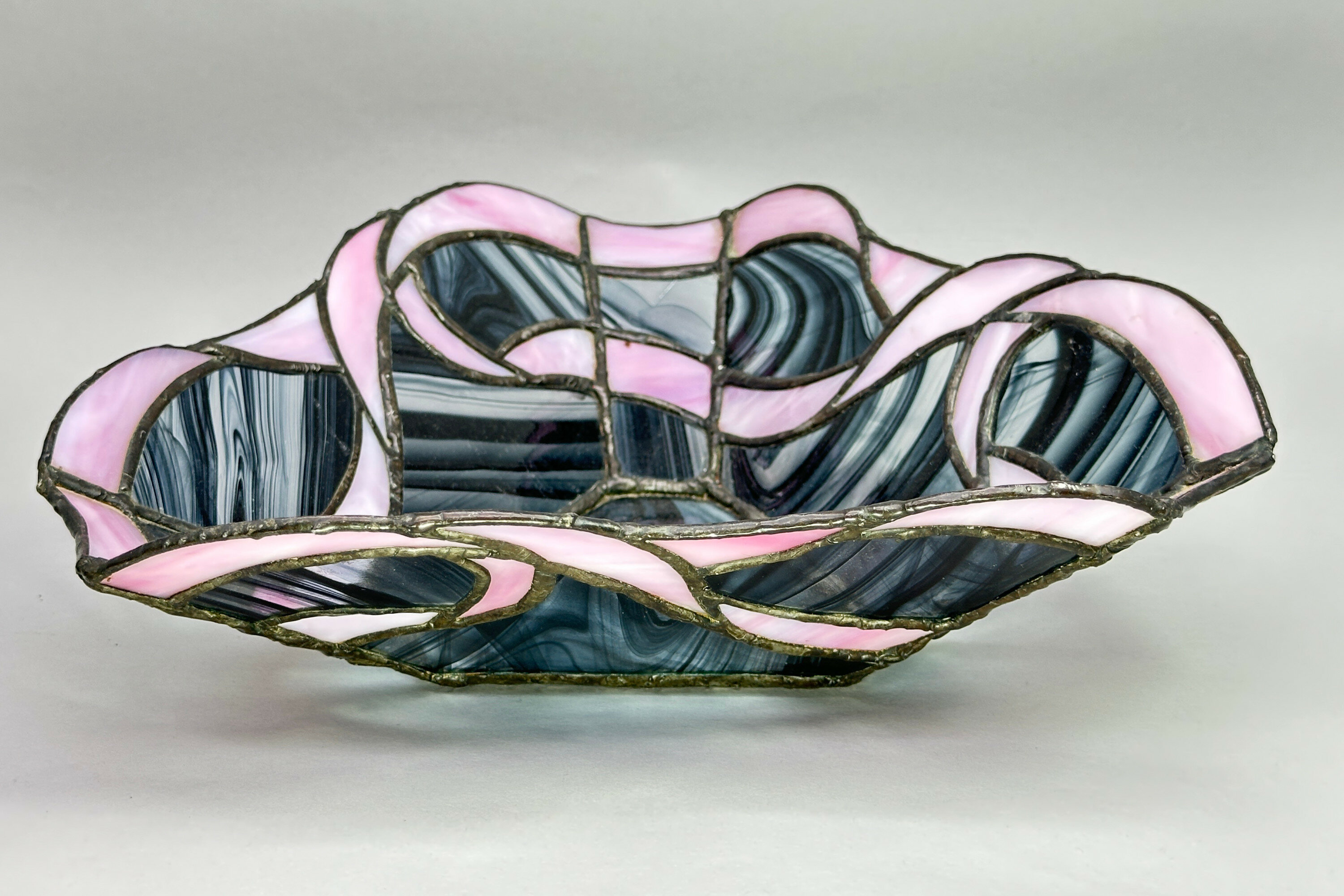
Leaded Slag Glass Bowl, C20th
Price: £45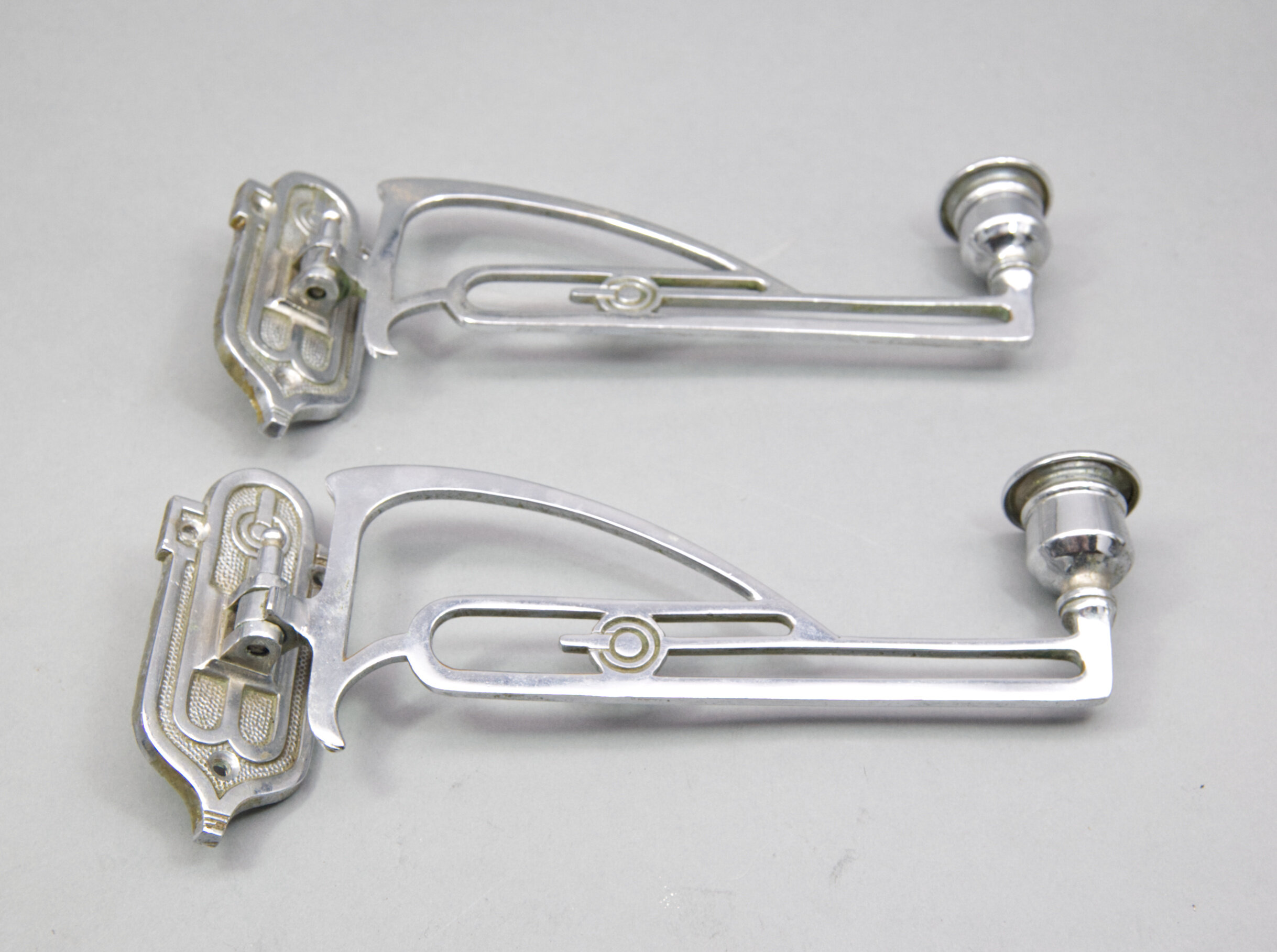
Pair of Art Deco chrome wall sconces
Price: £75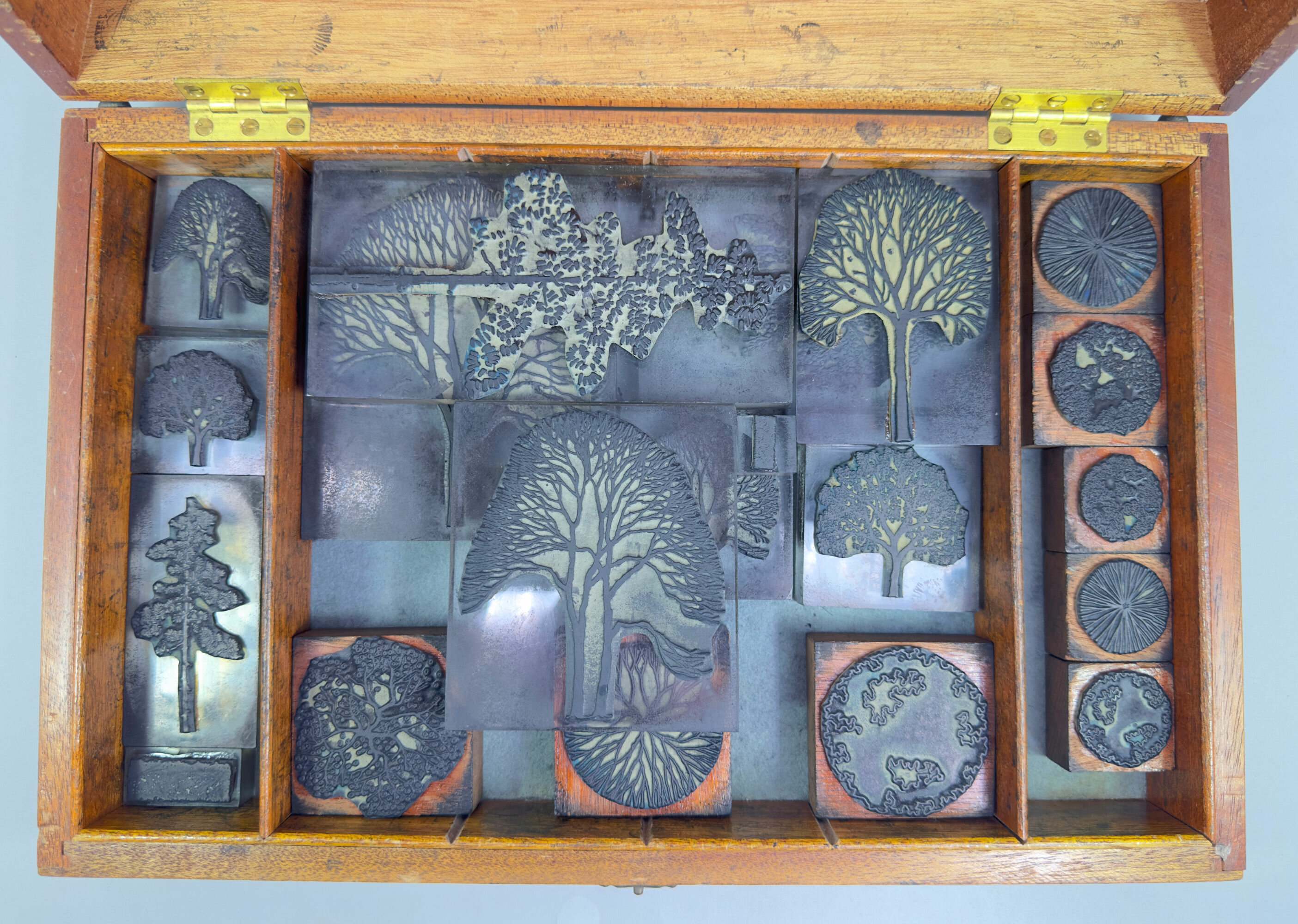
A group of twenty assorted artists Stamps in H&R Johnson sample Box, C20th
Price: £75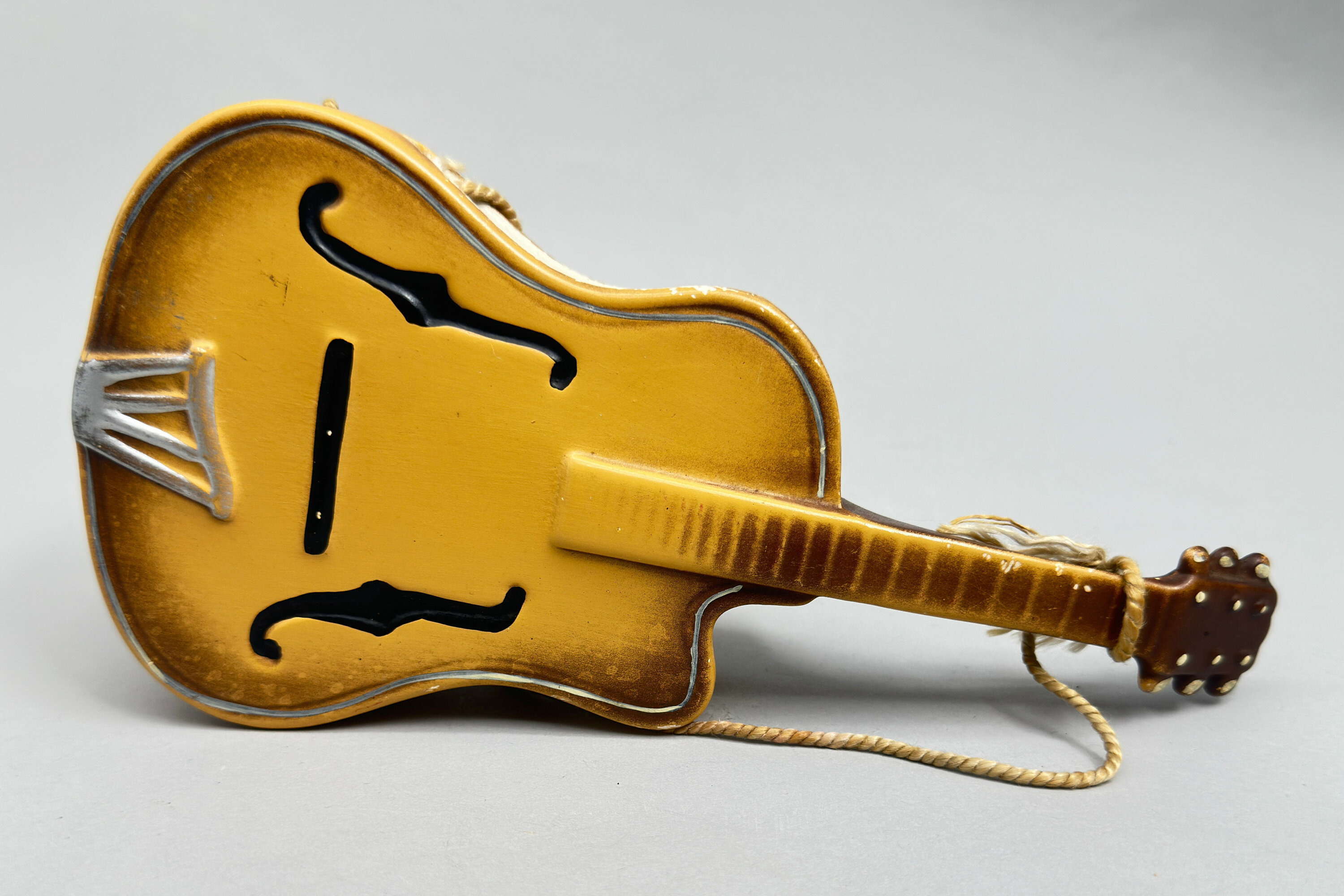
Novelty ceramic Wall Vase in the form of a Gretsch Guitar, English, 1950s
Price: £25
Pewter and brass box and cover in the form of a Mallard Duck, Gatco, Hong Kong, 1960s
Price: £25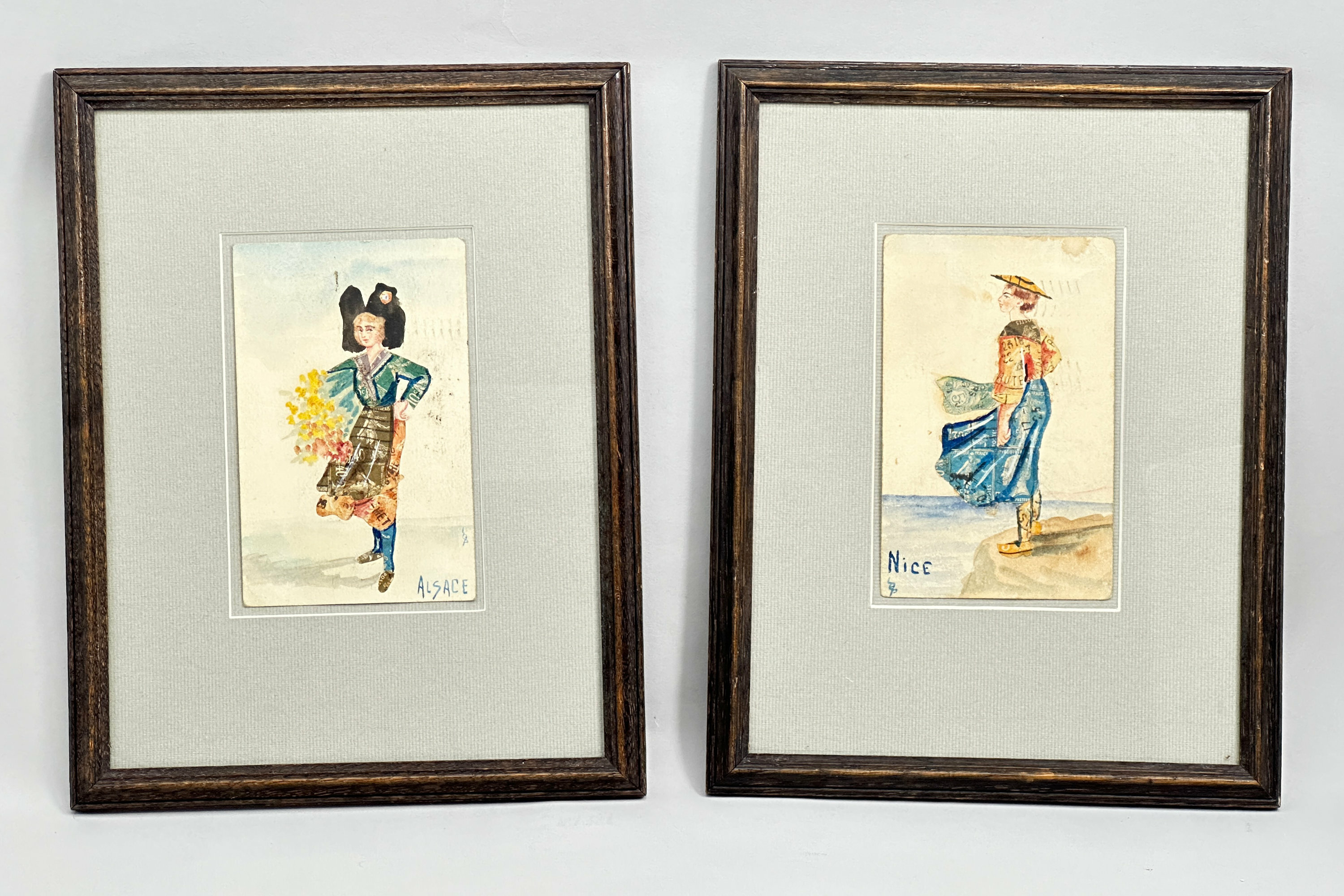
A pair of stamp collage Postcards, Alsace and Nice, framed, early C20th
Price: £45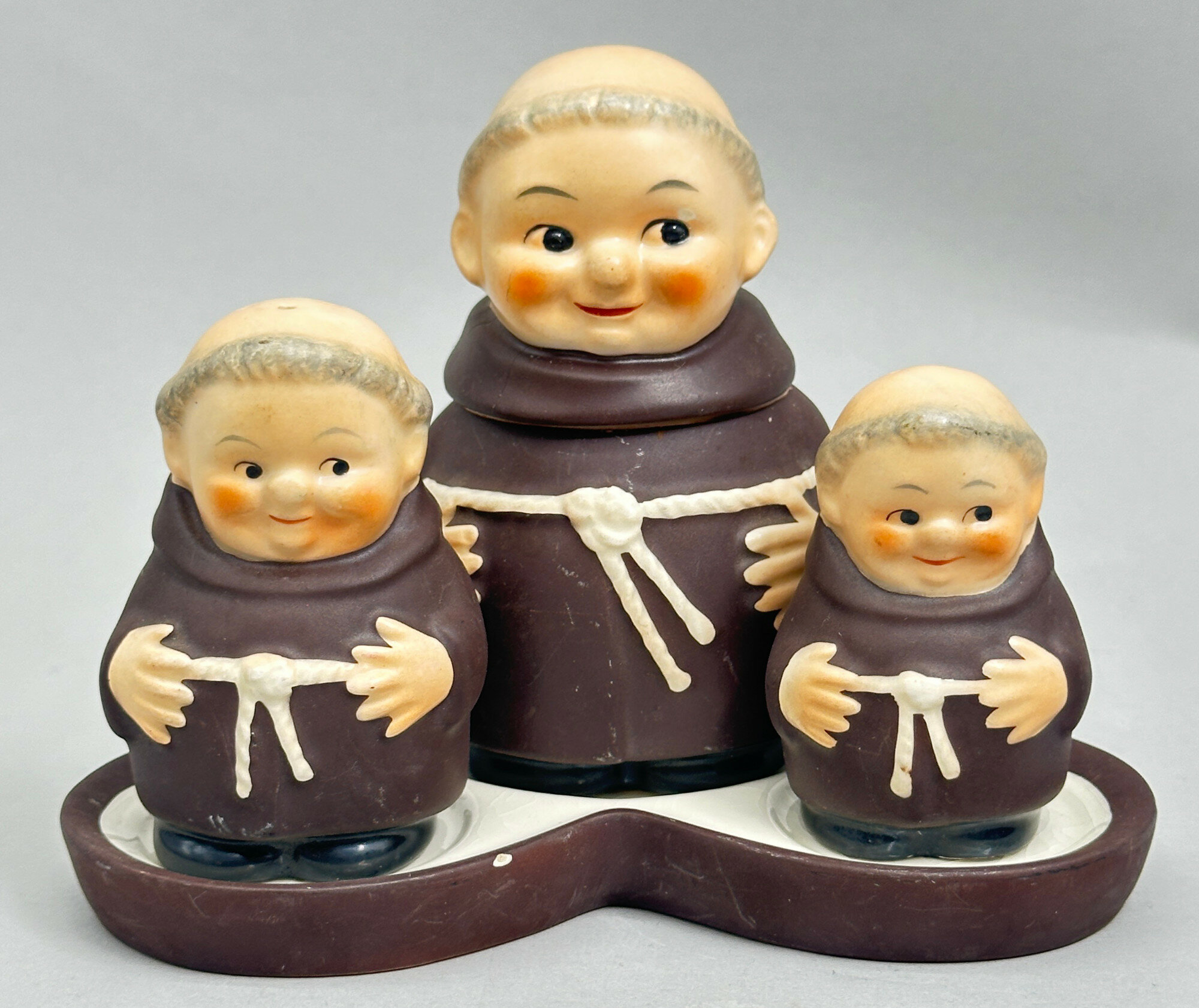
Cruet set in the form of three Friar Tuck Monks on a Tray, Hummel, West Germany, 1960s
Price: £55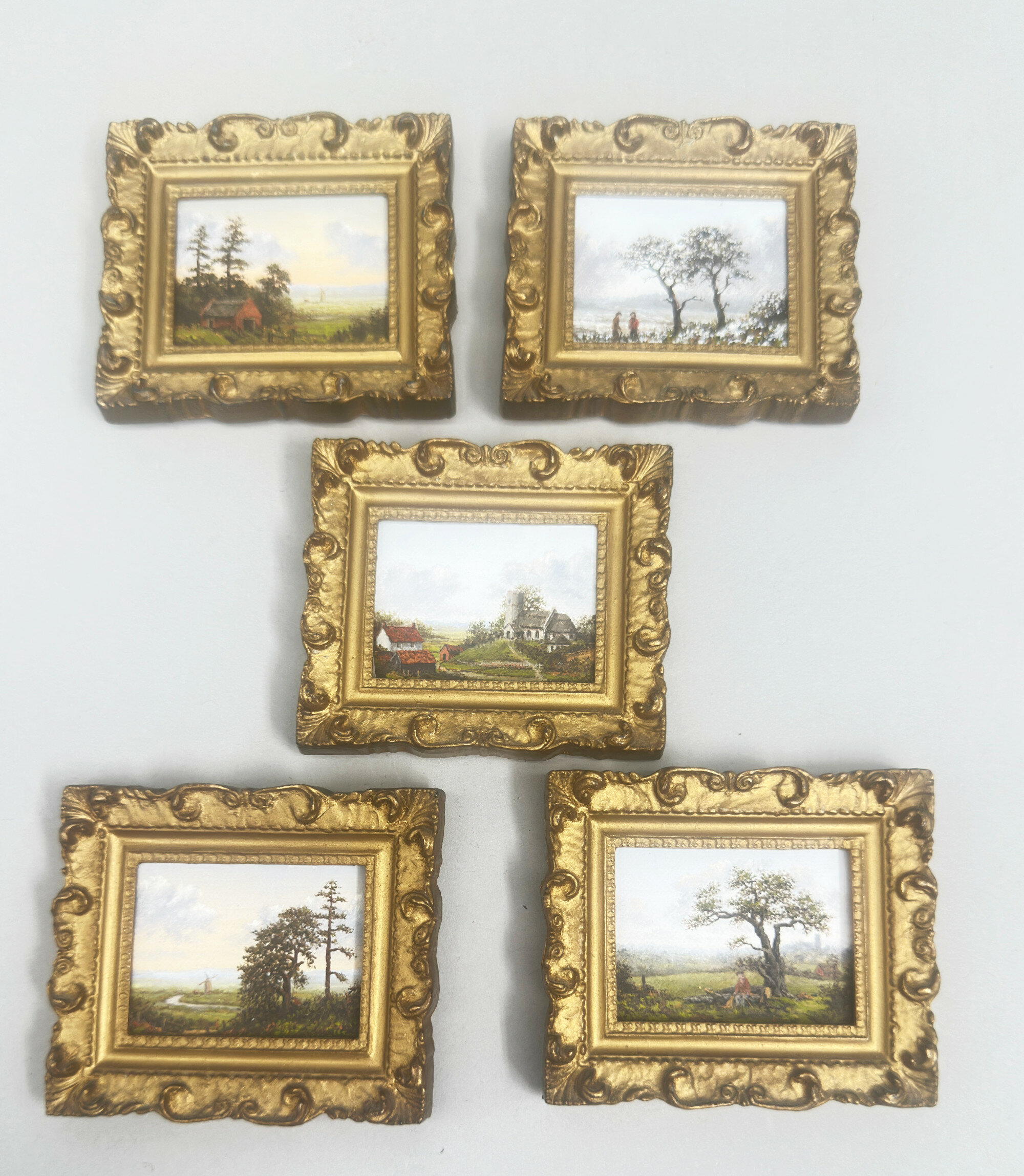
Set of five small landscape paintings attributed to Charles Boyland Turner, C20th
Price: £110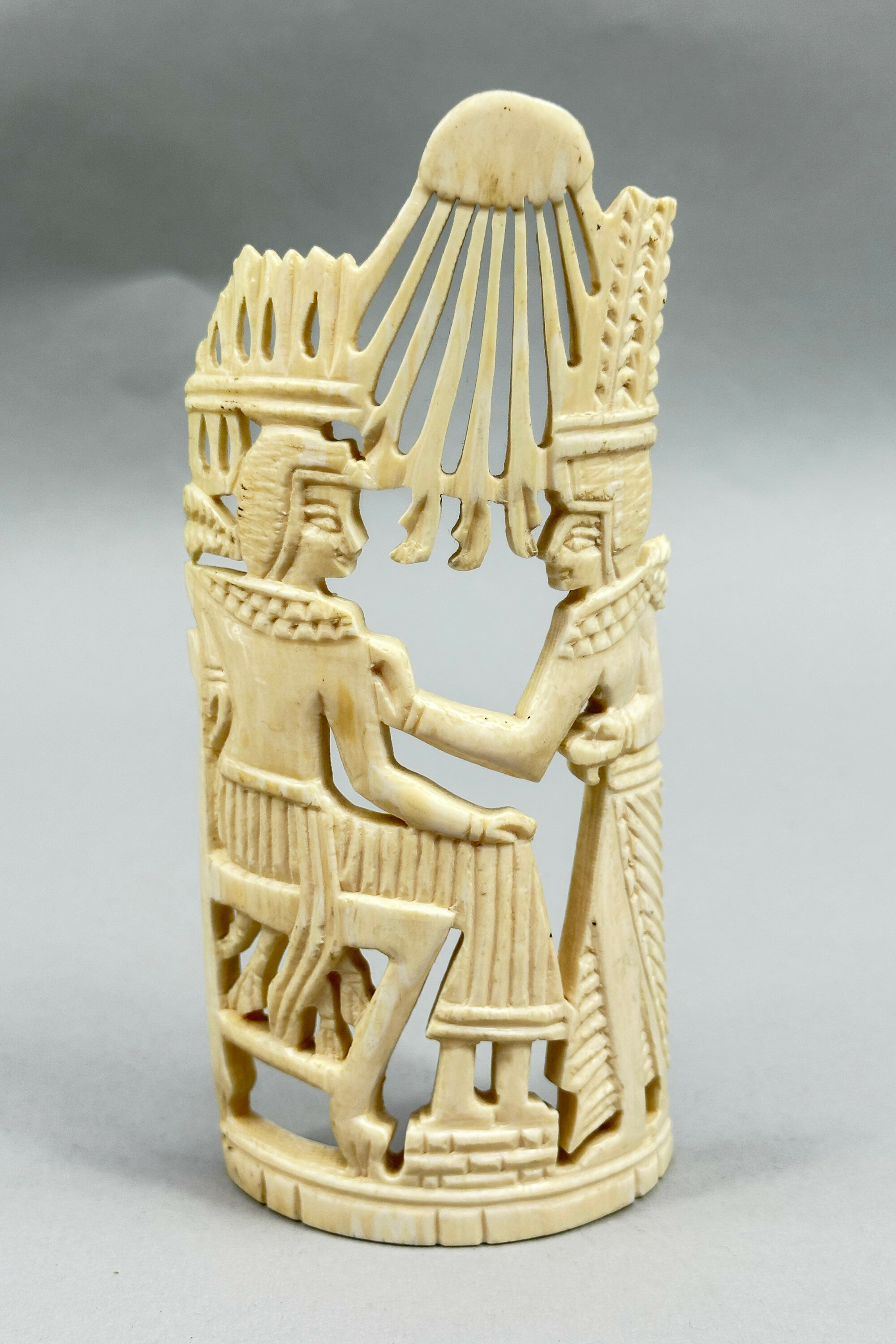
Egyptian table decoration depicting a Pharoah and Attendant, c1940
Price: £45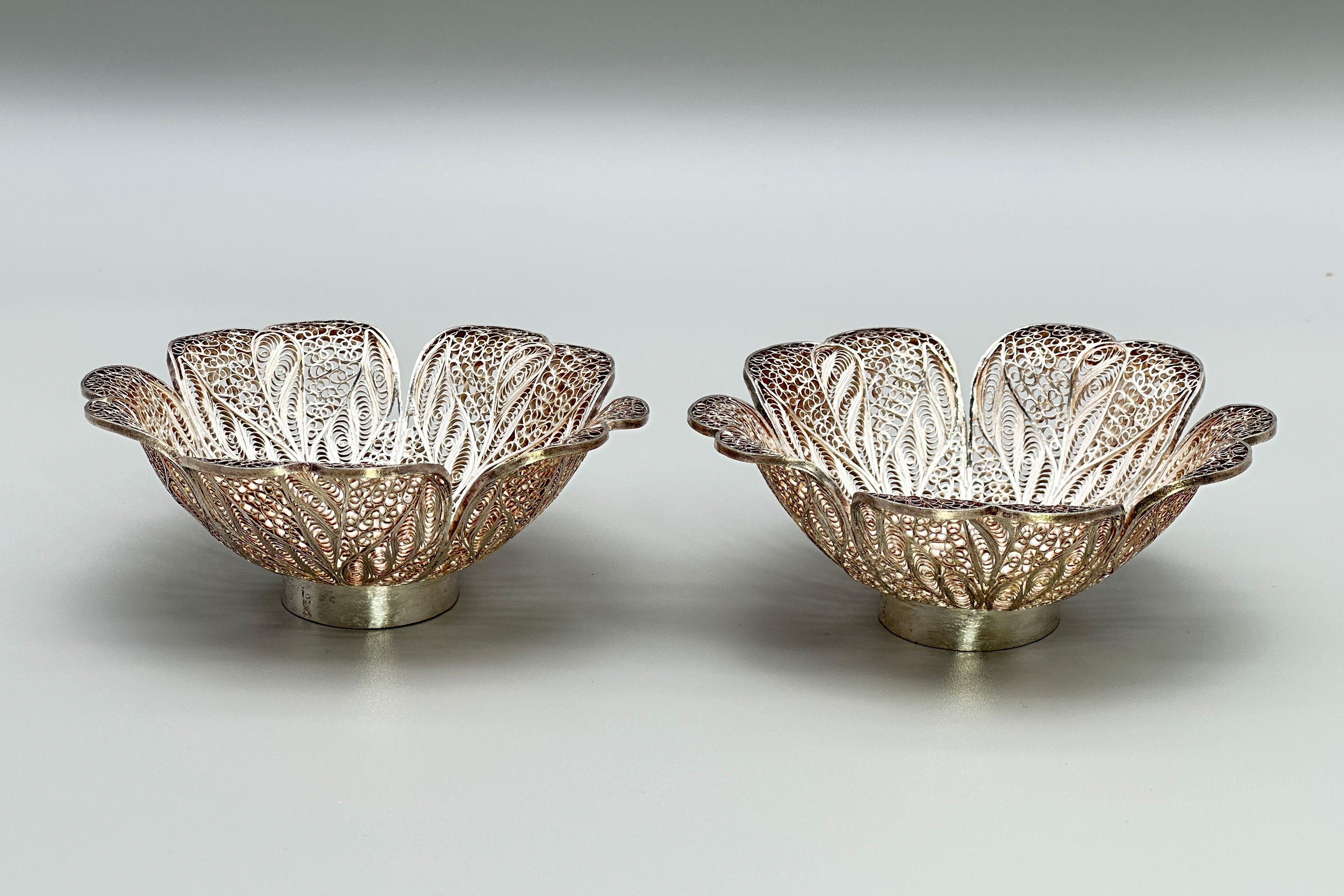
Pair of Silver Filigree Bonbonnieres, probably continental circa 1900
Price: £110
French Souvenir Verre Eglomise Box and Cover, Sacre Coeur de Montmatre, circa 1900
Price: £55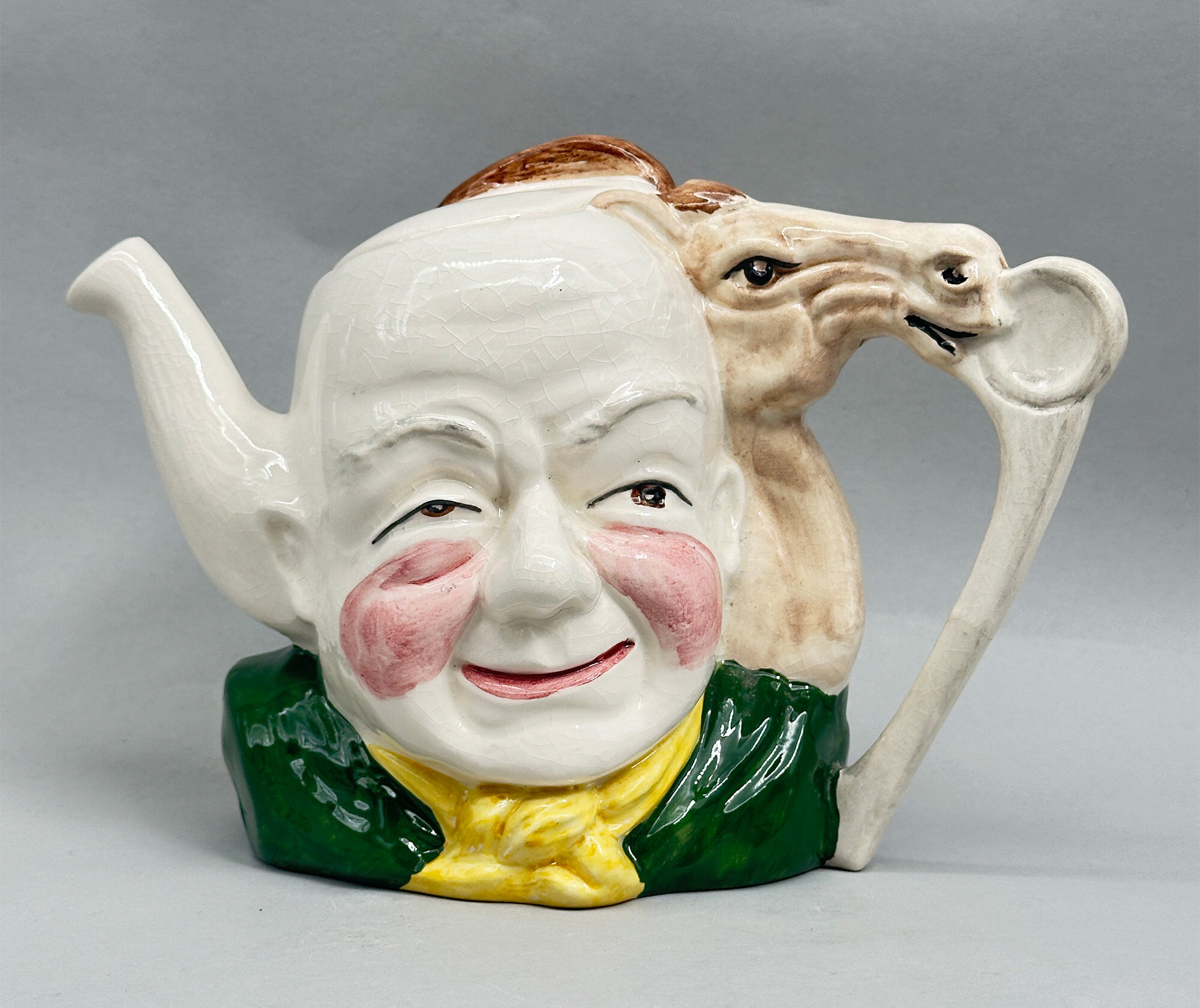
Crown Winsor Jockey Teapot, 1980s
Price: £35Crown Winsor was a short lived earthenware manufacturer at the Sylvan Works, Longton, Stoke-on-Trent, England, previously the premises of the firm Shaw and Copestake, who traded under the well known name ‘SylvaC’ and went into voluntary liquidation in 1982. A workers co-operative trading under the name of Longton Ceramics attempted to take the business over but with little success and eighteen months later the enterprise was fully taken over by United Co-operative Society and run under the name of Crown Winsor. The Co-operative society already owned the Windsor Pottery works and the Crown Clarence Pottery works which was the source of the ‘Crown Winsor’ name. Production centred on whimsical and novelty items, sometimes made from the old SylvaC moulds but demand proved weak and the business ceased trading in 1989. This teapot is typical of their range and the elaborate cipher underneath seems to read ‘CW’ grandly announcing a trade name which unfortunately had a very short life
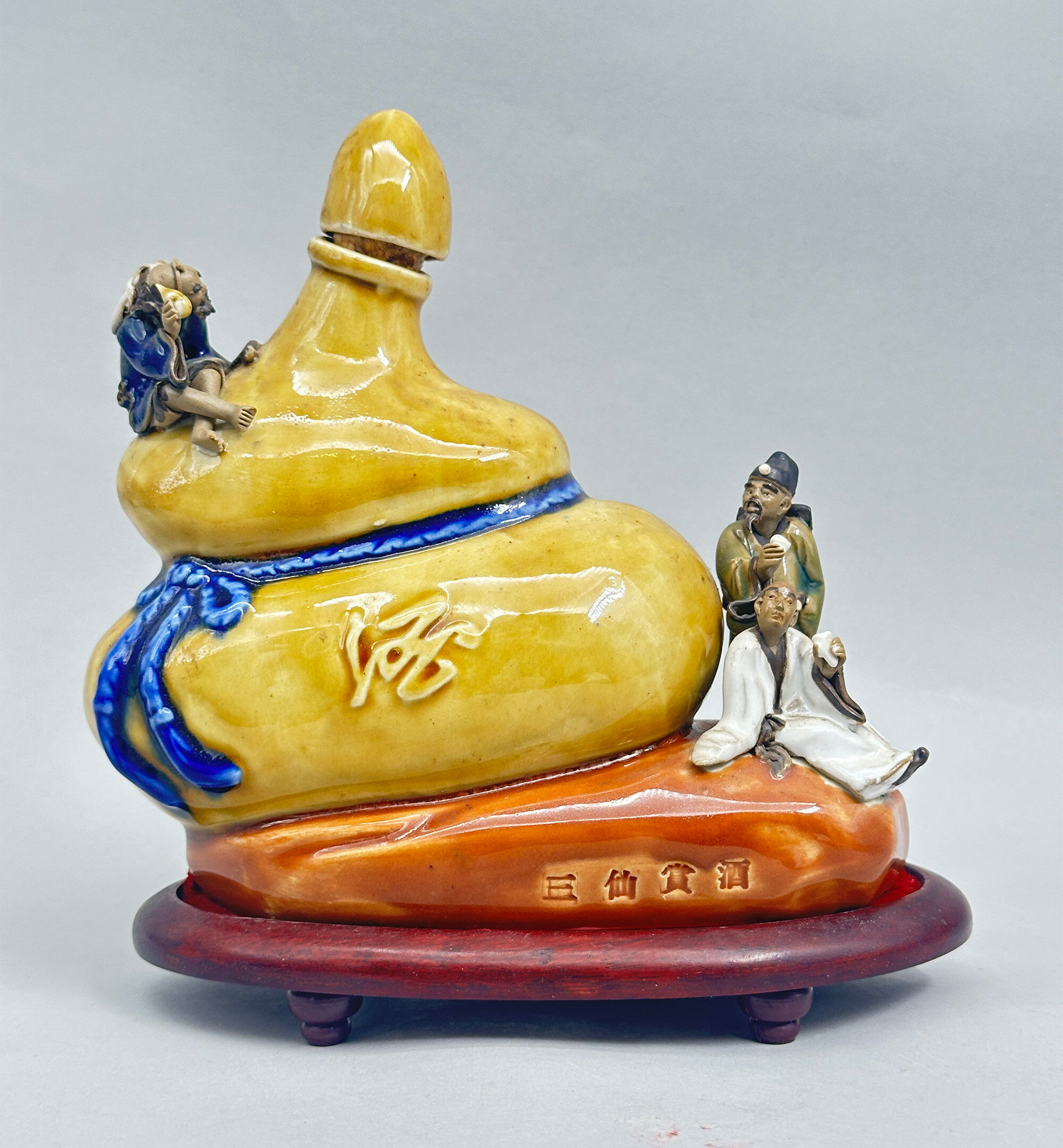
Chinese Qu Wine Decanter, Sam Seng Wine Co, late C20th
Price: £35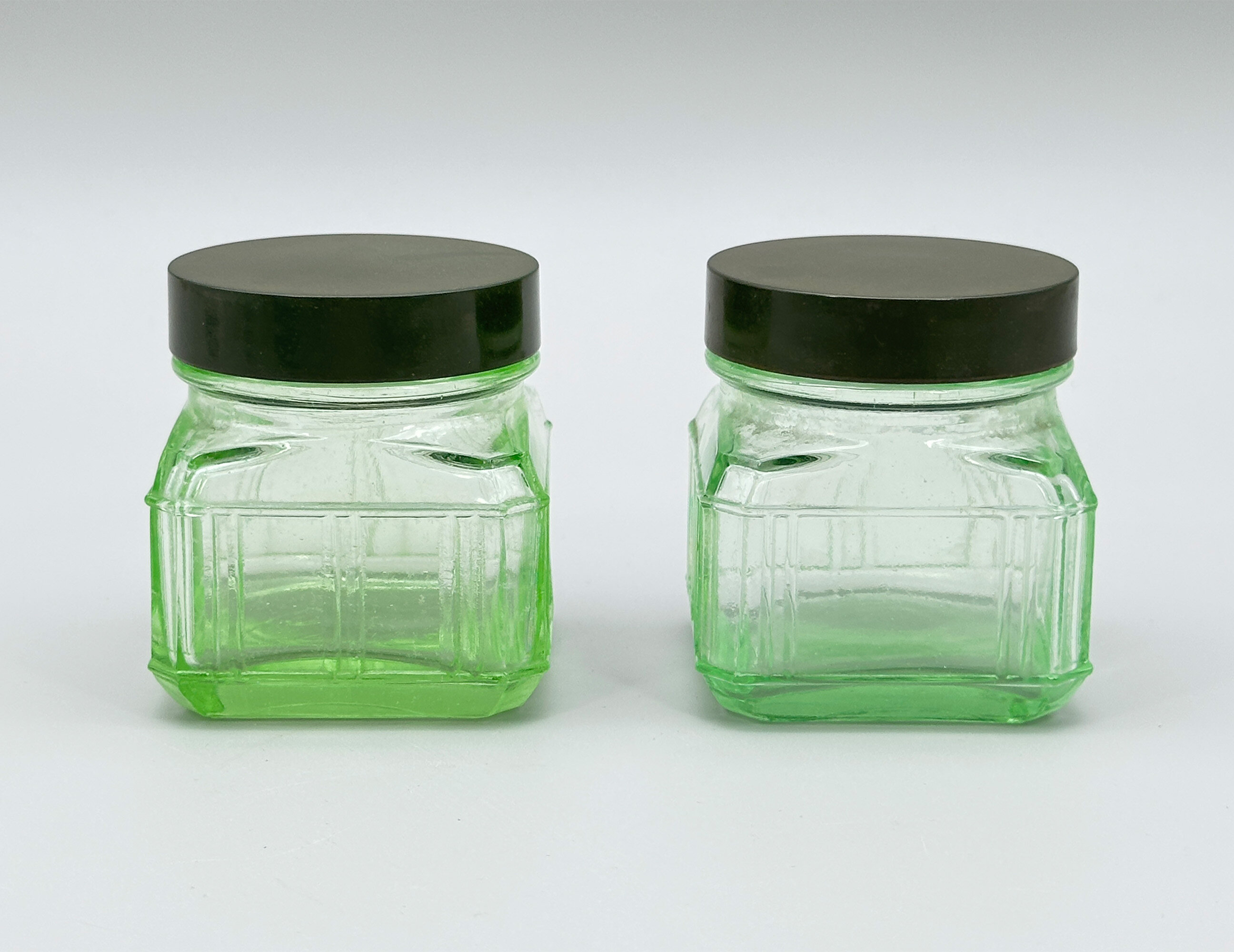
Pair of small green depression glass Jars with bakelite Covers, 1930s
Price: £45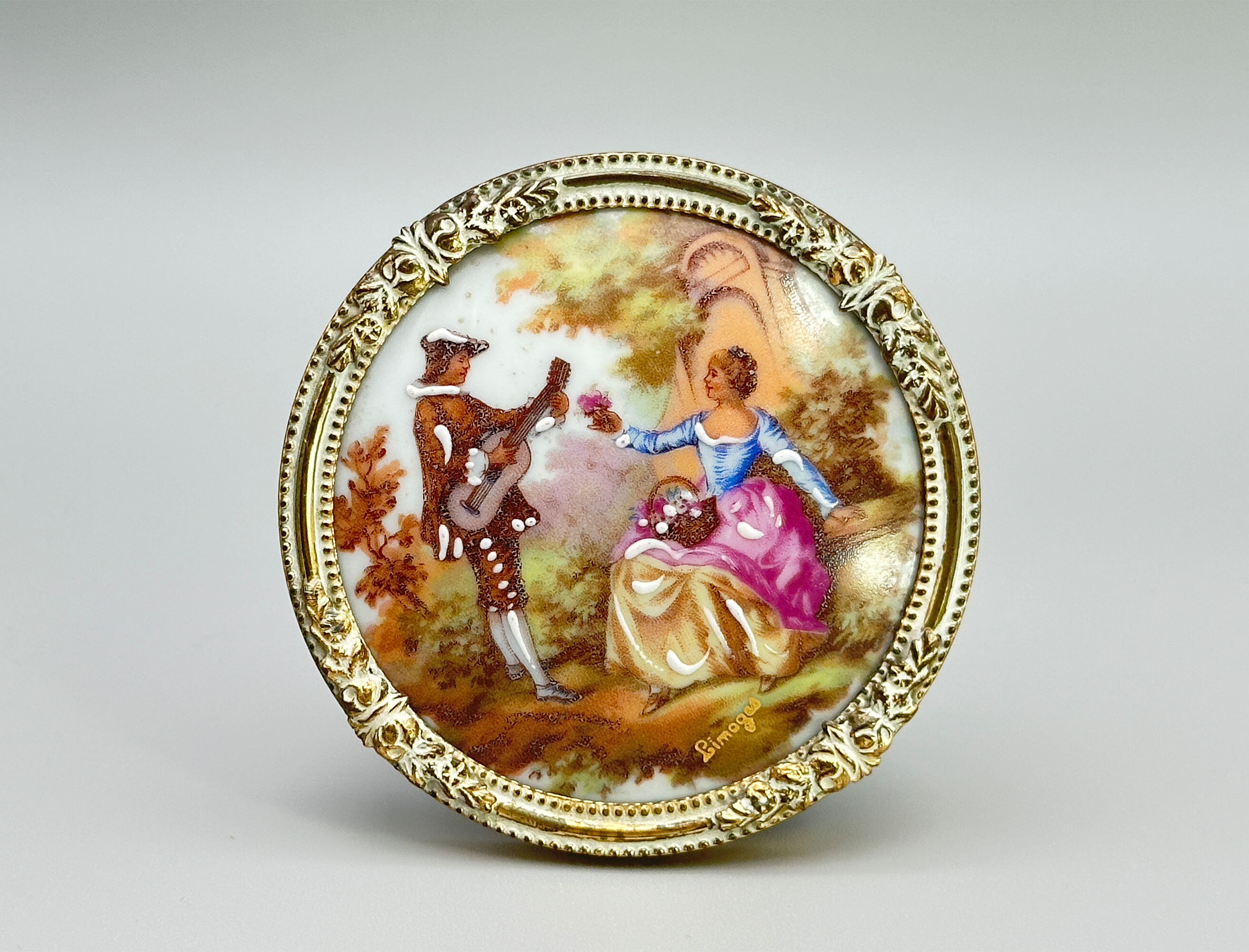
Small circular ceramic plaque after Fragonard marked Limoges, framed, late C20th
Price: £25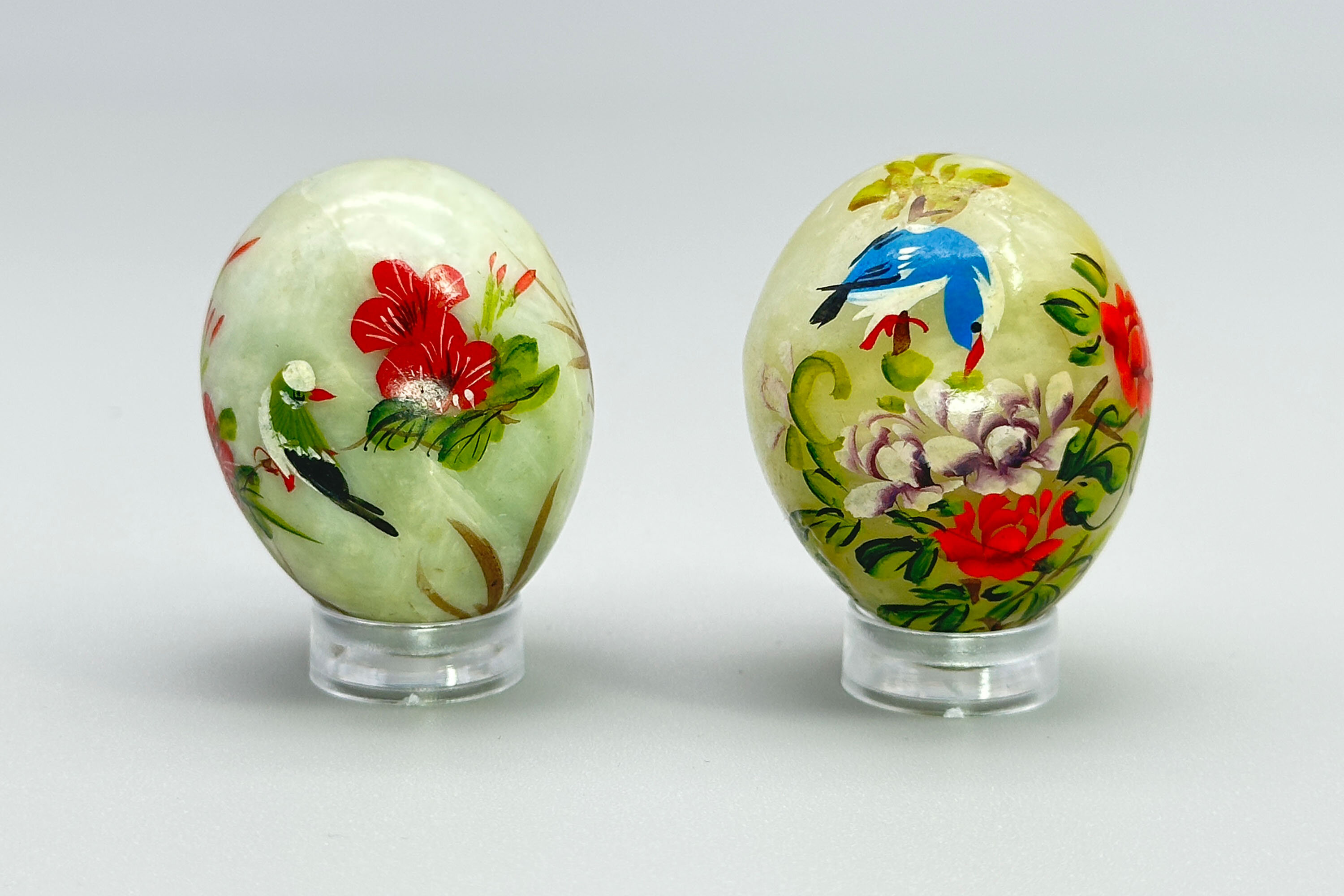
Pair of Chinese hand painted jade Eggs with modern stands
Price: £25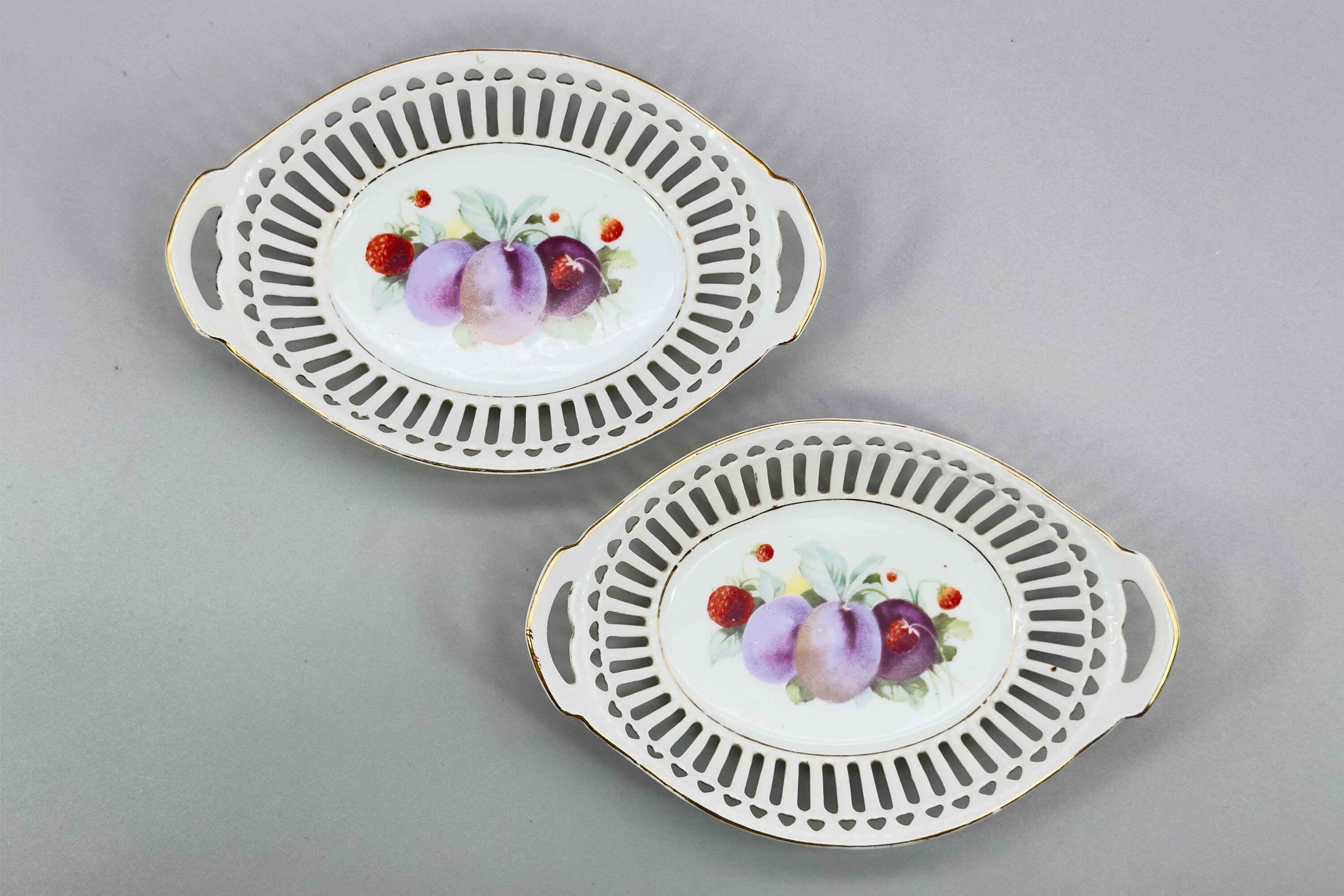
Pair of continental style openwork border Dishes, probably Chinese C20th
Price: £20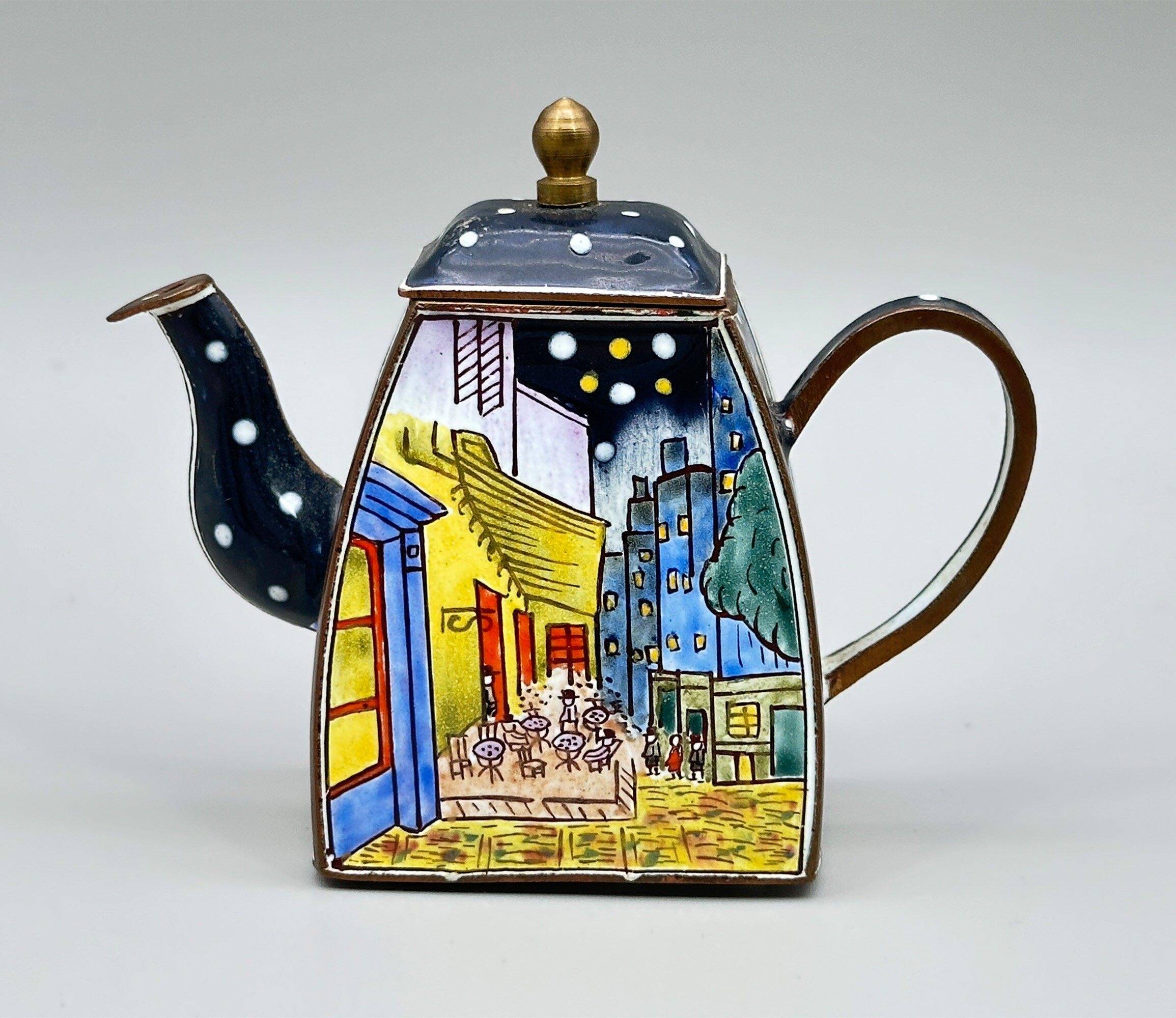
Trade+Aid Teapot, Van Gogh Café Scene, UK 1990s
Price: £25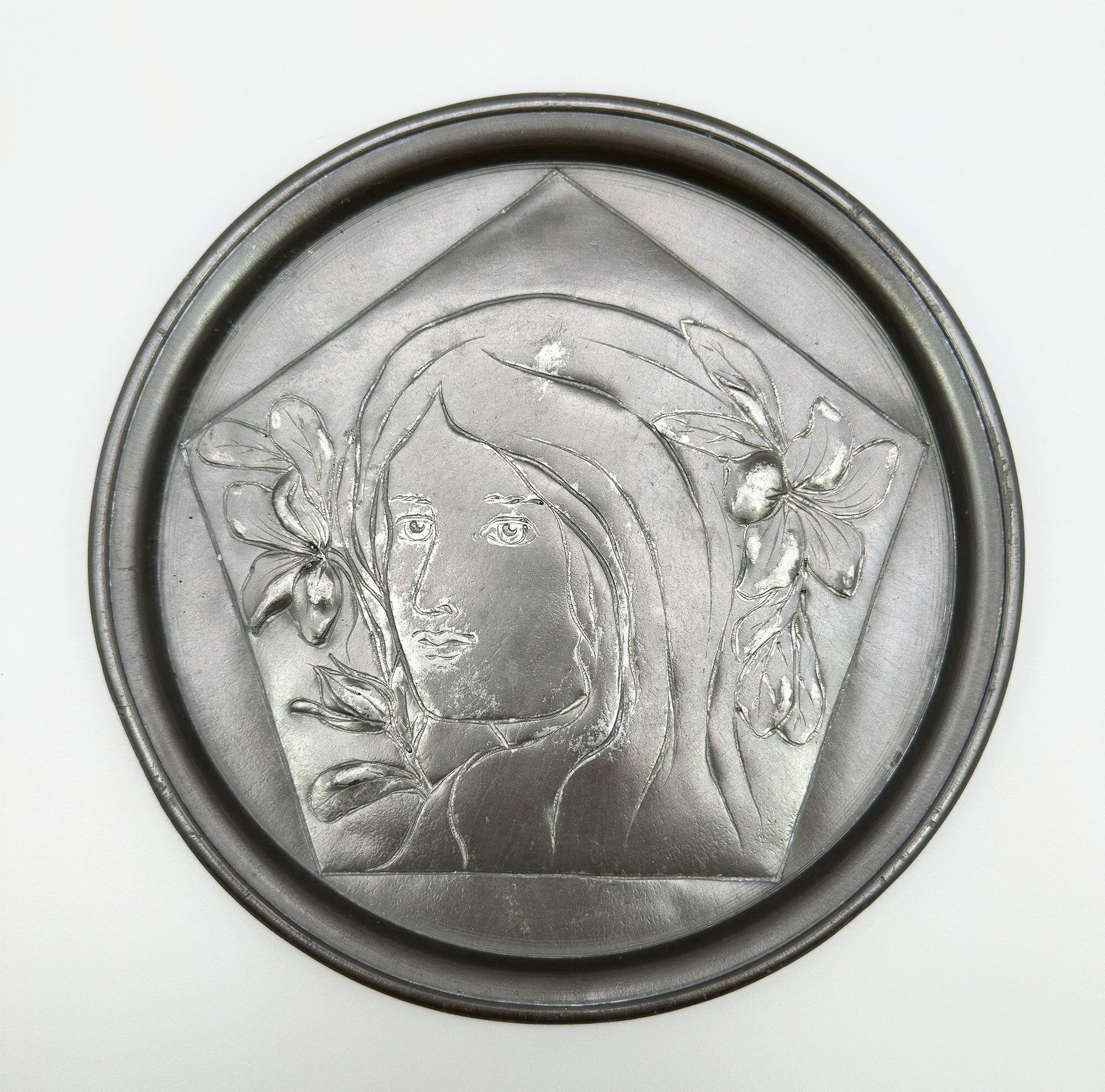
Pewter Plate in the Art Nouveau style, marked Joh. Heidl, C20th
Price: £20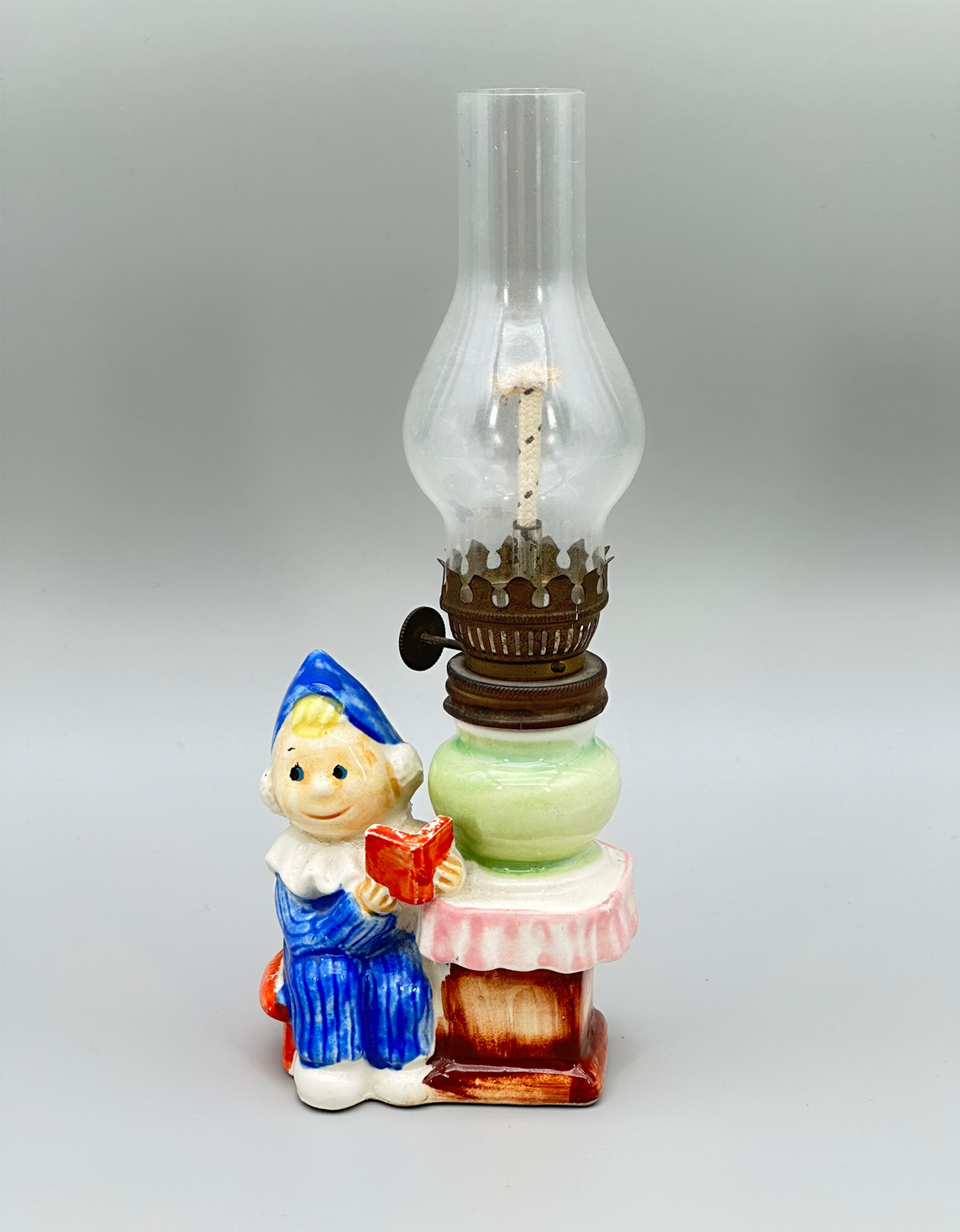
Andy Pandy Oil Lamp, German, Karl Meyer, 1950s
Price: £35TV linked merchandise was created even in the earliest days of the medium and this charming small ceramic oil lamp, hardly the safest accessory for the nursery, is an amusing example. Andy sits next to a table with an urn on the top which forms the base of the lamp. Oil or paraffin would have been contained inside and once lit the wick could be adjusted by turning the round flat knob on the side. This has the trademark symbol for the German toy manufacturers Karl Meyer (see image 7). The base is marked ‘FOREIGN’ which was a common requirement for items imported into the UK after the second World War and allowed the makers to conceal their country of origin, which might have been useful to some of them at the time. A true piece of nostagia whether the figure represented is familiar or not.
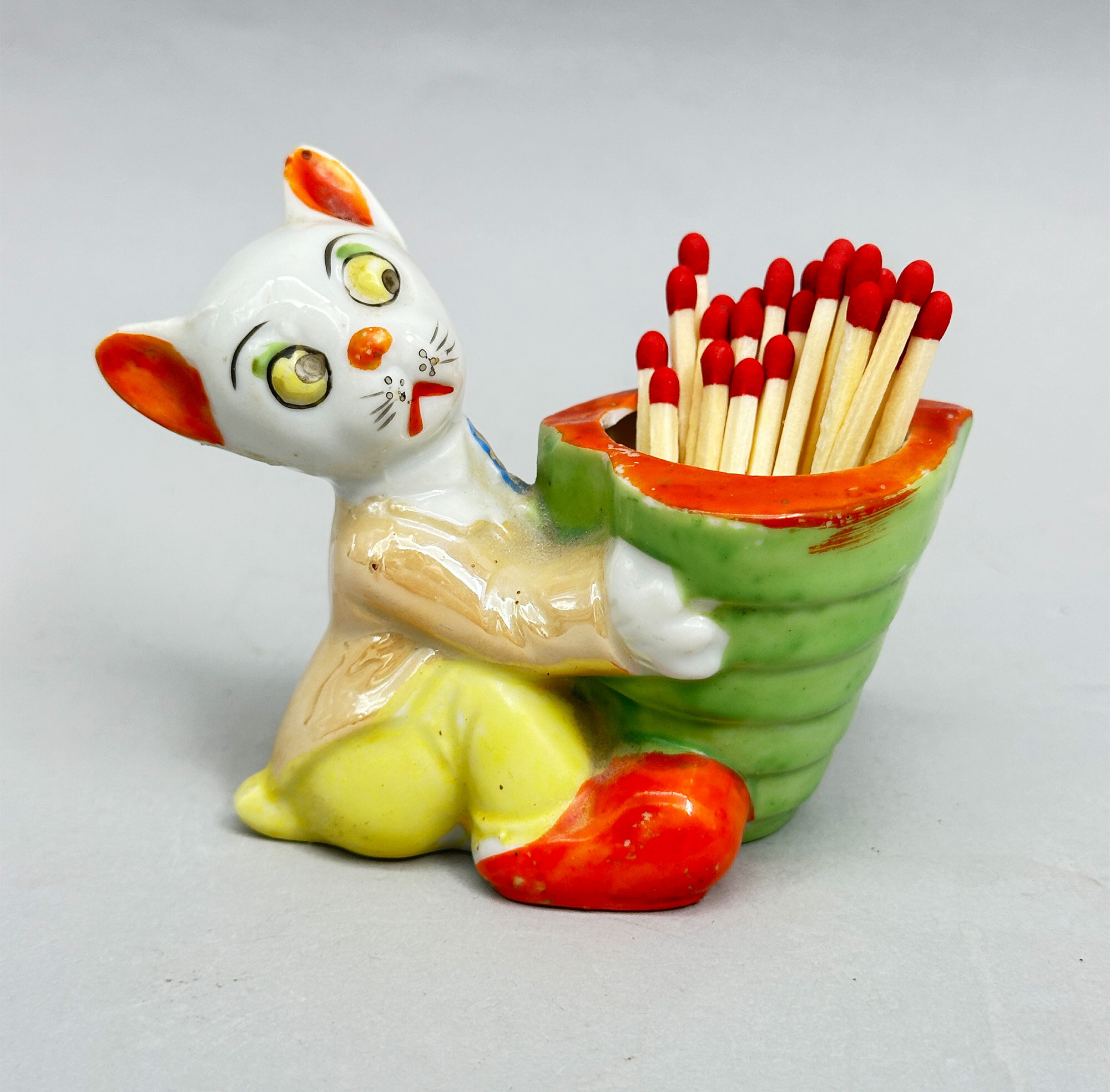
Novelty match holder with cat, Klimax Japan, mid C20th
Price: £20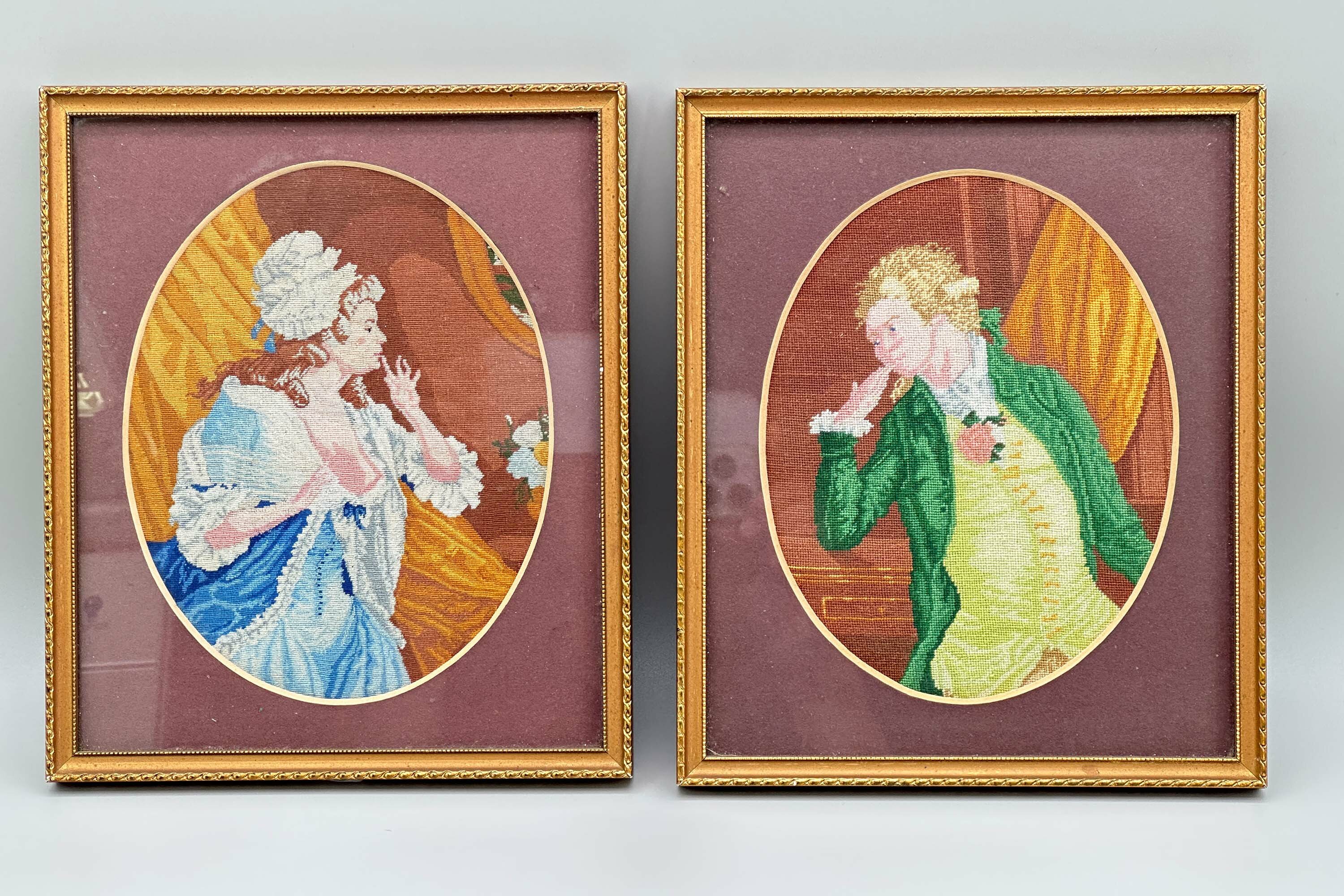
Pair of petit point Tapestry Pictures, The Needlewoman Shop London, mid C20th
Price: £55The fine stitching used here is a version of needlepoint termed ‘petit point’ because of the small size of stitches used. In general needlepoint, designs are stitched onto fine canvas using a simple tent stitch, a small, diagonal stitch that crosses over the intersection of one horizontal and one vertical thread of the canvas forming a slanted stitch at a 45-degree angle. Petit point uses the same technique but with much finer stitching and thread on a much finer canvas often requiring magnification for the work to be carried out. It allows more intricate designs and shading effects as can be clearly seen here. The technique was particularly popular in France amongst the aristocracy in the early eighteenth century which perhaps determines the choice of subject here but with their intricate stitching and complementary frames, this pair of tapestries would definitely be a candidate for boudoir accessories in the present day.
